V-TANK STORAGE SPEAKS OUT
Our cover star explains how its proactive and competitive approach helps its terminals stand out
SAFETY EXCELLENCE
Odfjell Terminals Korea shares insights into establishing an accidentfree workplace

CHEMICAL SUPPLEMENT
Get the latest insights and interviews from the global chemicals sector
Autumn 2023 | Volume 19 | Issue 04
Established 2005. Trusted. Valued. Influential.
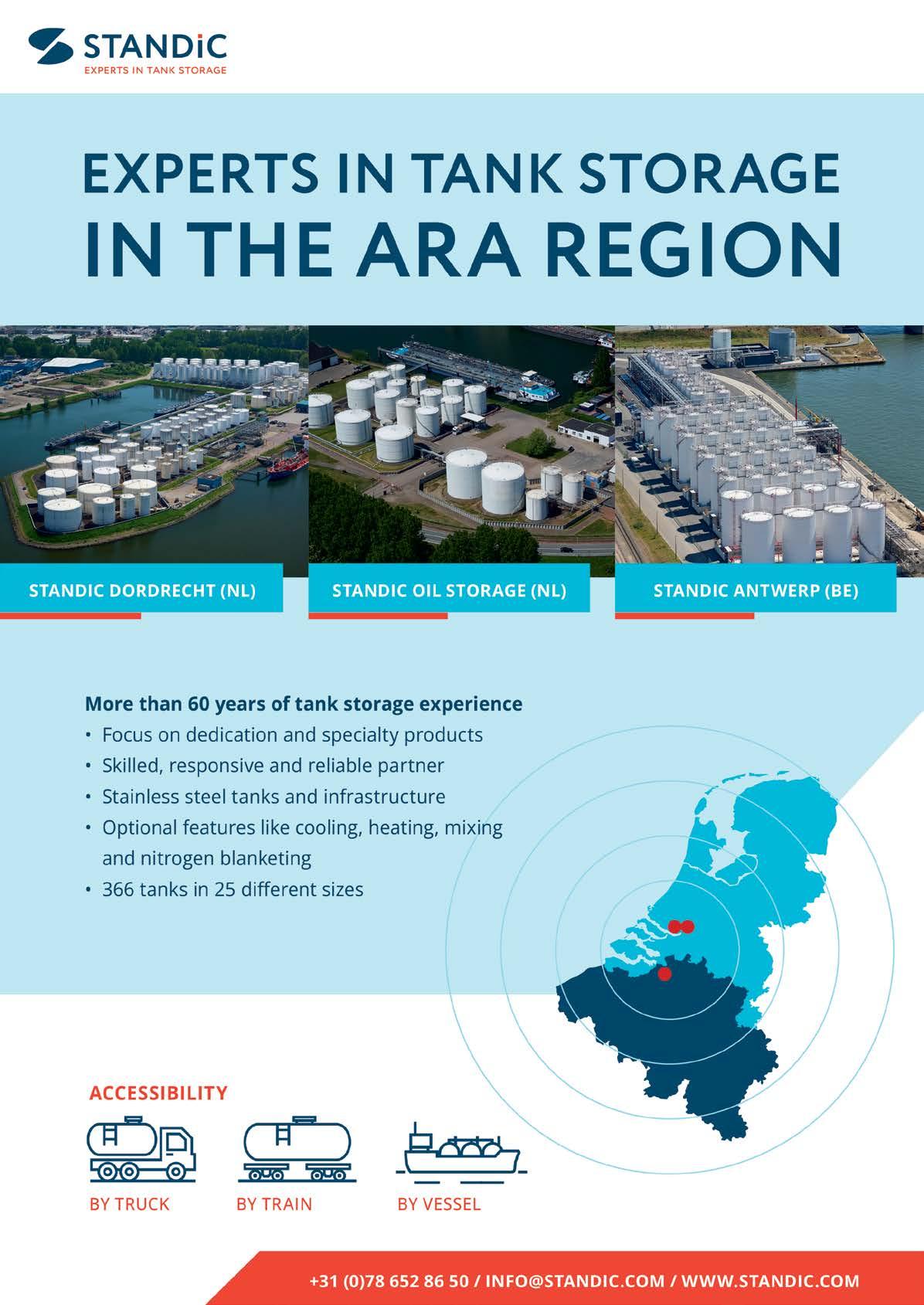
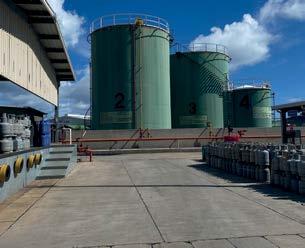



EXCLUSIVE INTERVIEWS 38 36 40 43 34 Following dreams; making choices Tank Storage Magazine sits down with Agnes Kiss, sales representative at Walter Tosto to discuss what route led her to tank storage 36 Proactive, competitive and always on the go Tank Storage Magazine speaks to this edition’s front cover sponsor, V-Tank Storage SA, about its global sites 38 Prioritising safety for customers and employees Having won gold in Safety Excellence at the Global Tank Storage Awards, Odfjell Terminals Korea shares insights into establishing an accident-free workplace 40 Operating in the Middle East Star Energy Advario CEO and VP of Advario Middle East, Andrew Drayton, tells Tank Storage Magazine about the Dubai terminal 43 Expanding terminals to supply future fuels Alexander Fokker, managing director at Vopak, explains the development of its sustainable feedstock storage in Rotterdam CHEMICAL STORAGE SUPPLEMENT INSIDE GLOBAL NEWS UPDATE 10 Editor’s Picks 12 Energy Transition 16 Product Launches 17 LNG 18 Digitalisation 21 Asia 25 Incident Report 34 Tank Terminal Update 30 Global Project Update UP FRONT 04 Contributors 06 Advertiser index 06 Social Storage 08 Editor’s Note 37 What’s Online? CONTENTS Autumn 2023 | Volume 19 | Issue 04 UP FRONT CONTENTS PAGE 01
MARKET ANALYSIS
44 In transition: energy security & digitalisation
FETSA’s executive director Ravi Bhatiani discusses the links between geopolitics, future fuels and the digital transformation for the energy industry

45 Asia’s outlook for LNG
President of Chevron Global Gas, Freeman Shaheen explains Chevron’s role in Asia’s LNG market
46 Energy security, transition & emissions
Andy Brooks, director of new ventures at the North Sea Transition Authority, explains the UK’s new licenses for CCS
48 What path lies ahead for hydrogen?
Insights from Argus’ latest webinar on the progress across different areas of policy, demand and project advancement and the outlook for the hydrogen sector
TECHNICAL FEATURES
51 Making inspections faster and easier
The experts at Skygauge explain why drone inspections are the future
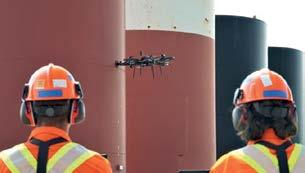
52 How mapping assets is key to maintenance
Cyann Fielding talks to industry experts about how tank mapping with lasers can improve the efficiency and longevity of assets
56 Modern foam for safer fire suppression
David Garris, firefighting foam agent & hardware product manager, at Johnson Controls explains how its new non-fluorinated foam has proven effective for large tank fire suppression
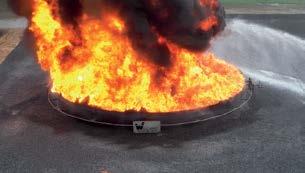
58 The key to success for data integrity
Cesar Espinoza and Veronica Dominguez at Rosen USA break down the essentials for ensuring smooth and effective data management and integrity
60 Avoiding reputational damage and injuries
Aidan Doherty, managing director of Re-Gen Robotics, discusses how no-man tank cleaning can impact safety, costs and reputation
61 Protecting critical infrastructure
Molly Cooper investigates how tank terminal operators can protect their staff and assets from terrorism and security threats
EVENTS
64 Taking the tank world by storm, one build at a time
Niklas Nordin, CEO and project manager at Nordweld, talks to Tank Storage Magazine about the company’s recent win at the Global Tank Storage Awards


68 Revolutionising tank maintenance & inspection processes

Cyann Fielding speaks to iSensPro about its gold win for Emerging Technology at the Global Tank Storage Awards 2023
71 Entering a new phase
Aquarius Energy CFO, Nicholas Gohl tells Tank Storage Magazine about winning the Outstanding Achievement award
75 Opportunities for tank storage in the hydrogen economy
Nick Waple, senior engineer at Wood Plc, gives Tank Storage Magazine an exclusive preview of his talk at the Hydrogen Technology Expo and how this relates to tank storage professionals
AT THE BACK
77 Events 2023
44
UP FRONT CONTENTS PAGE 02
51 56 60 71 64
Proven Performance. Powerful Protection.
Non-Fluorinated THUNDERSTORM® WNF33A 3x3 AR-SFFF Concentrate
The new, no-compromise firefighting solution to today’s most challenging oil, gas and chemical fires:
• Demonstrated effective on fuel in-depth tank fires.
• High-quality foam blanket produced with most conventional response equipment.
• UL 162 listed.
Backed by 70 years of WILLIAMS FIRE & HAZARD CONTROL® fire protection expertise, THUNDERSTORM® WNF33A foam is the proven, no-compromise solution for large tank fires.
For more information, contact your regional WILLIAMS FIRE & HAZARD CONTROL® product representative or visit www.williamsfire.com.

EDITORIAL
ANAMIKA TALWARIA
Anamika is the editor for Tank Storage Magazine. She curates all the fantastic content in every edition and online.

MOLLY COOPER
Molly is a journalist for Tank Storage Magazine and looks after the news section. On page 38, she speaks to Star Energy Advario about their terminal.


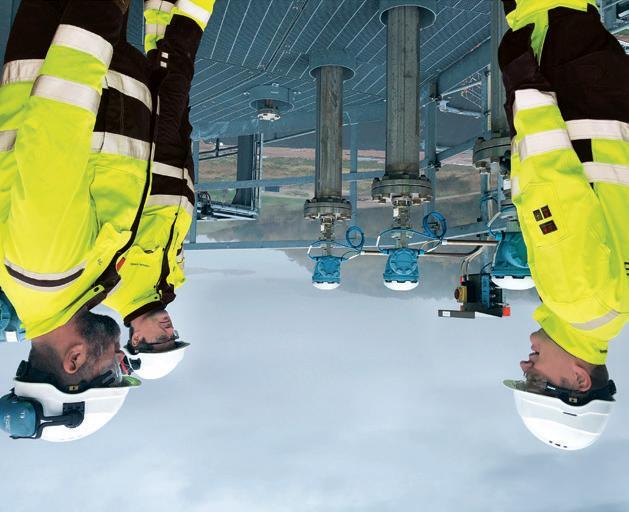
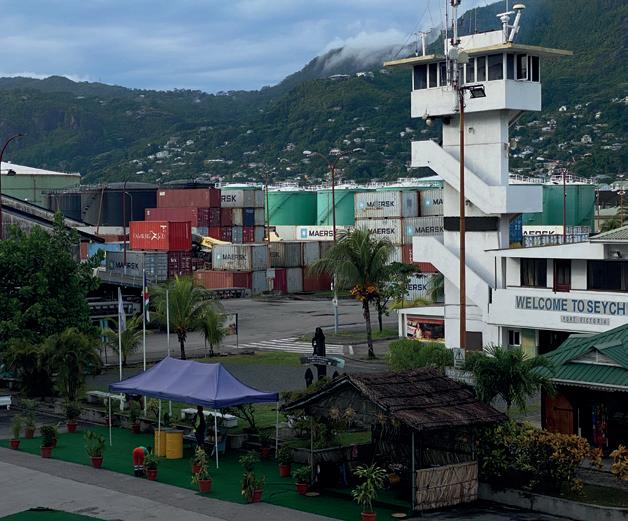
CONTACT
T +44 (0)20 3196 4300
F +44 (0)20 8892 1929 anamika@tankstoragemag.com www.tankstorage.com
Easyfairs
2nd Floor, Regal House 70 London Road Twickenham TW1 3QS United Kingdom
ISSN 1750-841X
CYANN FIELDING
Cyann is a journalist for Tank Storage Magazine. She’s covering our Women in Tanks series this issue, speaking to Johnson Matthey’s Hande Cote inside the Chemical Storage Supplement.
SALES & MARKETING
PORTFOLIO DIRECTOR
Margaret Dunn +44 (0)20 3551 5721, margaret@tankstoragemag.com
HEAD OF SALES
Sophie McKimm +44 (0)20 3196 4356, sophie.mckimm@easyfairs.com
INTERNATIONAL SALES MANAGER
David Kelly
+44 (0)20 3196 4401, david@tankstoragemag.com
SALES MANAGER
Josh Lyle +44 (0)20 3196 4364, josh.lyle@easyfairs.com
KEY ACCOUNT MANAGER
Gary Kakoullis
+44 (0)20 3196 4248, gary.kakoullis@easyfairs.com
MARKETING MANAGER
Ream Demnati
+44 (0)20 3196 4282, ream.demnati@easyfairs.com
HEAD OF DATA
Beth Welcomme beth.welcomme@easyfairs.com
CEO EASYFAIRS UK & GLOBAL
Matt Benyon
matt.benyon@easyfairs.com
Anne Lafère anne.lafere@easyfairs.com
Autumn 2023 Volume 19 Issue 04 Our cover star explains how its proactive and competitive approach helps its terminals stand out Odfjell Terminals Korea shares insights into establishing an accidentfree workplace Get the latest insights and interviews from the global chemicals sector Established 2005. Trusted. Valued. Influential. Aug Sep 2019 AN INTERNATIONAL CONCEPT IN A CAPTIVE MARKET Oiltanking matola explains how it is introducing the independent storage model in sub-saharan africa. AN INTERNATIONAL CONCEPT IN A CAPTIVE MARKET Oiltanking matola explains how it is introducing the independent storage model in sub-saharan africa. SPEARHEADING THE UAE’S NEW GAS CHAPTER The sharjah national oil corporation is ensuring greater energy security as it explores gas storage.
WITH US
Storage Magazine
Storage Magazine UP FRONT CONTRIBUTORS PAGE 04
CONTRIBUTORS CONNECT
@tankstorageinfo Tank
Tank
Expanding horizons


Driving change to meet the energy transition





At Exolum we see the energy transition as an opportunity to expand our horizons. A chance to diversify our business and meet the challenges of climate change and our customers’ businesses. We have adopted Sustainable Development Goals (SDGs) to touch every aspect of our business and made a commitment to minimising our impact on the environment by striving to use energy resources and raw materials e ciently.
Europe’s leading bulk liquid logistics provider


To find out more visit exolum.com
taken the final investment decision to expand the terminal in Antwerp, Belgium and has started the construction of 28 tanks, collectively providing a significant storage capacity of 80,000 m³. #tankstorage #storagetank #portterminal #terminalport #storageterminal #terminalstorage #petrochemicals #oilandgas #futurefuels #energytransition #bulkliquid #tankterminal #tankport
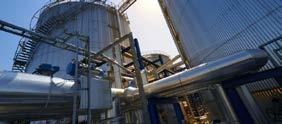
Mabanaft expands storage footprint into Denmark by acquiring 100% of Oiltanking’s terminal in the capital, Copenhagen: https://bit.ly/46vDci5 #tankstoragemagazine #tankstorage #oil #gas #tankterminals #bulkliquids #storagetanks #storageterminals #liquids #news

Vault selects Chart Industries, Inc. to supply integrated liquid hydrogen storage and fuel delivery system. The system will be for a green hydrogen long-duration energy storage system (BH-ESS) used in conjunction with a utility-scale battery to provide back-up power to the city of Calistoga, California, USA.

https://lnkd.in/dGH_x7bg
#tankstorage #storagetank #tankterminal #storageterminal #terminalstorage #futurefuels #oilandgas #petrochemical #energytransition #hydrogen

ADVERTISERS INDEX SOCIAL STORAGE Most liked posts this summer: UP FRONT ADVERTISERS INDEX & SOCIAL STORAGE PAGE 06 V-Tank Front Cover Standic Inside Front Cover JCI Williams 3 Exolum 5 Rosen Group 7 Rubis-Tepsa 9 Gerotto 11 EEMUA 13 Auma 15 Suma 17 EEMUA 19 E2G 20 Protego 21 Soliflo 22 Koerting 23 Dantec 24 StocExpo 26 Walter Tosto 29 SGB 33 FETSA 44 TSA Conference 47 EPCA 49 Merrett Surveys 55 Re-Gen Robotics 60 Nordweld 65 iSensPro 69 AntwerpXL 70 World Hydrogen Week 73 API Conference 74 ADIPEC 76 Rotary Engineering Back Cover CHEMICAL STORAGE SUPPLEMENT Port of Tarragona Front Cover Hazard 33 5 VII Med Hub Day Back Cover Tank Storage Magazine, (ISSN 1750-841X) is published five times a year by Easyfairs UK Ltd, 2nd Floor, Regal House, 70 London Road, Twickenham, TW1 3QS, UK. A one-year, 5-issue membership costs €299. The US annual subscription price is $243. Airfreight and mailing in the USA by agent named WN Shipping USA, 156-15, 146th Avenue, 2nd Floor, Jamaica, NY 11434, USA. Periodicals postage paid at Jamaica NY 11431. US Postmaster: Send address changes to Tank Storage Magazine, WN Shipping USA, 156-15, 146th Avenue, 2nd Floor, Jamaica, NY 11434, USA. Subscription records are maintained at Easyfairs UK Ltd, 2nd Floor, Regal House, 70 London Road, Twickenham, TW1 3QS, UK. Tank Storage Magazine 12,845 followers 1mo • Edited Tank Storage Magazine 12,845 followers 2mo • Edited Tank Storage Magazine 12,845 followers 2mo • Edited LBC Tank Terminals expands Antwerp terminal: https://lnkd.in/eA5aN-zu LBC Tank Terminals has
Energy
LBC Tank Terminals expands Antwerp terminal Mabanaft Acquires Oiltanking Terminal in Copenhagen Energy Vault Selects Chart Hydrogen technology 116 • 2 comments • 6 reposts 2,624 engagements 164 • 3 comments • 14 reposts 6,054 engagements 74 • 2 comments • 1 repost 3,183 engagements Like Like Like Comment Comment Comment
The syntheses of non-destructive testing and integrity allows for the comprehensive understanding of an asset’s safety, lifetime, and performance. By bringing together technology, expertise, and consultancy, we become your partner in reliable decision-making. | Always a leading innovator, we deliver solutions that give operators confidence in their assets, ensuring safety and compliance with accurate diagnostic data and dedicated integrity services to protect and manage plants & terminals.
Comprehensive Asset Management

www.rosen-group.com
EDITOR’S NOTE
A WARM welcome back to you all. It’s been a while since the last print edition landed on your desk, so let me remind you of the high quality content you can enjoy. This issue has our annual Chemical Storage supplement, which you can find on page 50. Inside is an exclusive interview with Stolthaven Singapore, centring on the facility’s Dow SEA S4TAR Award win.
There’s also updates from the Chemical Business Association about creating a safe and sustainable supply chain, plus Cepsa Quimica offers insight into its range of sustainable chemical products.
Throughout the rest of the magazine, you’ll find an exclusive interview with one of 2023’s Global Tank Storage Award winners Odfjell Terminals Korea (page 36), key insights into how LNG and hydrogen fit into the tank storage industry, and the role of carbon capture and storage. Our editorial team has also been working hard to produce some exciting and original articles on laser mapping for inspections (page 52) and on security at the terminal (page 61).
So whether you’re reading this on release day in early September, or at one of the many events this edition is available at throughout the Autumn months, I hope you enjoy the content we’ve packed in.
A lot has changed for TankStorage Magazine over the summer.
We launched a brand new website and membership model, with the aim of bringing you lots more exclusive content, without needing to wait for the quarterly editions of each magazine. So look out for interviews with high-level professionals in the tank storage industry, original editorials about the topics that matter most to you, and our event previews (and reviews).
Make sure you become a member to avoid missing out – and please tell us what you think! We’ve set up our Google Business Account, but it doesn’t mean much without the input of our valued readers and members. Plus, if you follow us on LinkedIn, you’ll have your chance to give us your input by telling us what you want to read about! So give us a follow.

We’ve also onboarded some new staff members – sales manager Josh, and marketing intern, Lily. They’ll both have a huge role to play in the success of our magazine and I can’t wait to help immerse them in our industry.
A final word from myself and the editorial team: thank you! We all joined this world a year ago, and the community that we’ve managed to forge within the tank storage community has been inspirational. It’s partly why we’ve create the new membership model – to help build a community and share knowledge between everyone in the industry.
I look forward to connecting with you all at the various events over the next few months, but don’t hesitate to get in touch with our team in the meantime.
Best wishes,
PAGE 08 UP FRONT EDITOR’S NOTE
Anamika 01
01 The Tank Storage Portfolio team enjoying lunch in the sunshine this summer
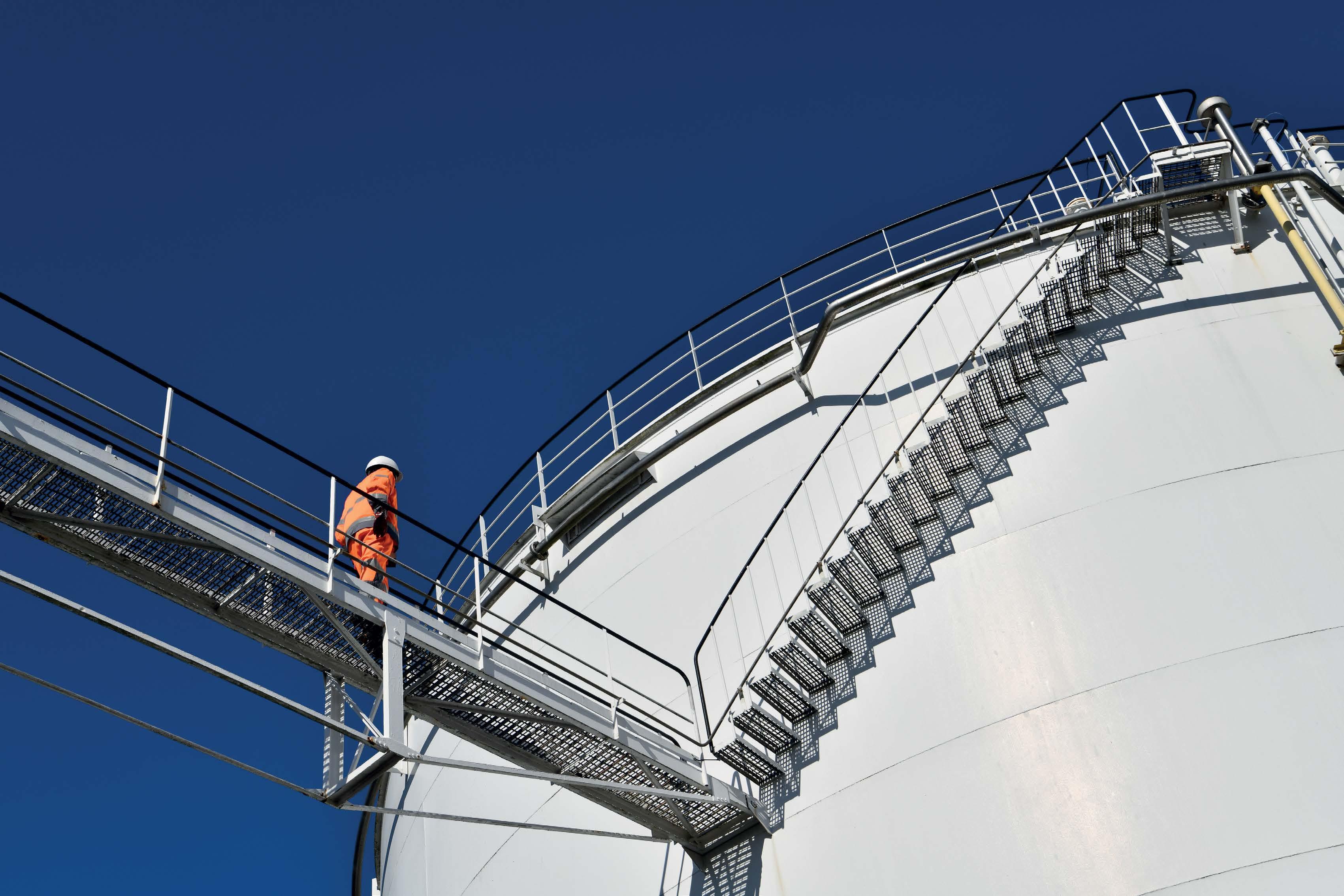
Sustainable storage solutions for everyday life. We connect industries with people through safe storage solutions. We preserve essential products in sustainable ways. www.rubis-terminal.com FRANCE – SPAIN – NETHERLANDS – BELGIUM
GLOBAL NEWS UPDATE
Stay informed with our round-up of all the news hitting the tank storage sector
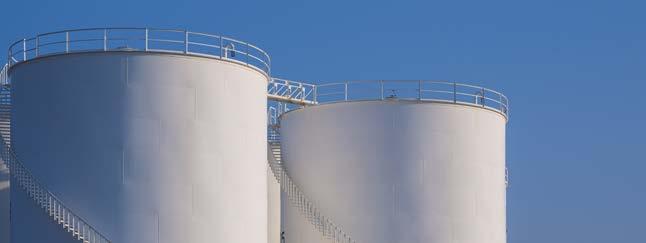
ESSAR OIL PARTNERS WITH OIKOS STORAGE
Essar Oil can now transport and distribute middle distillate fuels at the Oikos Storage Canvey Island facility, in the UK, to serve the Thames and surrounding regions. This enhances Oikos’ connectivity to the United Kingdom Oil Pipeline (“UKOP”) system, strengthening both supply and resilience to the Essar terminals in Northampton and Midlands region.
Larry Khanna, head of business development at Essar Oil UK, says: ‘We are delighted to have expanded our rack offering with Oikos and to be able to serve the largest market in the country. Supply resilience and security of supply are paramount for our customers, and we pleased to be able to offer this as we leverage our strong fuel expertise to serve existing and new customers and markets across London and the South East. It has been great to welcome long-standing customers to our new facility at Oikos and we look forward to meeting customers old and new at the site.’
Arunan Sriskanda, managing director at Oikos, says: ‘Oikos is delighted to support Essar with their rack commissioning as part of the long-term contract. There are great synergies between our operations, where we hope to support on both Essar’s midstream and downstream strategic aspirations. The new Essar rack offering will improve the UK’s fuel connectivity and supply chain resilience, as well as develop our site’s capability as we look to play an important role for future fuel trends.’
EXOLUM PARTNERS WITH VOPAK FOR HYDROGEN LOGISTICS
Exolum and Vopak Ventures have invested in the French start-up HSL Technologies, a company focused on the development and industrialisation
of simple, efficient, innovative, and cost-effective methods to safely transport and store hydrogen.
HSL Technologies’ is developing a unique process to introduce hydrogen molecules into a silica-based liquid carrier, where the hydrogen can be released on demand. Initial tests have shown that this carrier is stable and can be safely transported and stored in existing infrastructures at ambient pressure and temperature.
Martijn Schouten, of Vopak Ventures says: ‘This investment very well fits into Vopak Ventures’ New Energies, Feedstocks & Sustainability fund, in which we focus on funding ventures facilitating new sustainable solutions in areas such as zero emission fuels, green feedstocks, recycling solutions and flow batteries. We are very much looking forward to give our support in further developing this promising technology.’
Europe
BAKER HUGHES TO DEVELOP LOW-CARBON AIRPORT SOLUTIONS
Energy technology company Baker Hughes has announced a memorandum of understanding (MoU) with airport management and operations company Avports to develop, implement and operate onsite microgrid solutions for the airport industry. The collaboration addresses emissions reduction and zero-emission buildings, horizontal airport infrastructure, vehicles and aircraft systems.
‘Providing a technical and economic roadmap to airports to meet their energy needs of the future is key as an airport management and operations company,’
says Jorge Roberts, CEO of Avports. ‘Our partnership with Baker Hughes brings world-class technology and know-how together with our ability to support airport customers to realize these solutions at their facility.’
Together, Avports and Baker Hughes are committed to a more sustainable industry.
EUROPEAN COMMISSION APPROVES DUTCH SCHEME FOR RENEWABLE HYDROGEN
The European Commission has approved a €246 million Dutch scheme to support the production of renewable hydrogen.
The measure aims to contribute to the development of renewable hydrogen in line with the objectives of the EU Hydrogen Strategy and the European Green Deal. The scheme will also contribute to the objectives of the REPowerEU Plan to end dependence on Russian fossil fuels and fast forward the green transition.
The Netherlands notified the European Commission of its intention to introduce a €246 million scheme to support the production of renewable hydrogen in order to increase the country’s electrolysis capacity.
Margrethe Vestager, executive vicepresident in charge of competition policy, says: ‘This €246 million Dutch scheme is another example of how we work towards securing Europe’s decarbonised future. It will help ramping up the production of renewable hydrogen and facilitate the greening of sectors that are otherwise
Europe Europe
PAGE 10 NEWS UPDATE EDITOR’S PICKS GLOBAL NEWS UPDATE
United Kingdom
difficult to decarbonise. The aid will support the most cost-effective projects. And this while minimising possible distortions of competition.’
The tender will be open to all companies established in the European Economic Area and operating, or wishing to build and operate, a hydrogen production unit in the Netherlands.


WSG SELLS WELL INTERVENTION DIVISION FOR NEW ENERGY SERVICES
WSG has sold its Well Intervention division and will use the funds raised to lay the foundations for a period of international expansion for the rebranded WSG Energy Services (WSGES).
In a major reorganisation, WSGES has divested its traditional Well Intervention offering – including coil tubing and slickline services – and will now focus on growing its market share in process, pipeline and industrial services (PPIS). There are no redundancies aspects to the deal.

The Netherlands-headquartered business retains its global footprint with a strong presence in the UK, mainland Europe, Asia and Australia, and its next objective is to establish a permanent presence in North America to capitalise on recent project successes.
Proceeds of the Well Intervention division sale to Excellence Logging (Exlog), a leading provider of oilfield services and launched by Bluewater in 2015, will be used to fund further acquisitions and to maintain R&D for refining the company’s emissions management processes and technologies, which are in demand from energy companies looking to reduce emissions on the route to net-zero.
Founder Geert Prins will remain an integral part of WSGES’ C-suite as chairman, while Andrew Burrell continues in the role of CEO leading the growth of WSG Energy Services globally.
STOLTHAVEN NEW ZEALAND SENDS TWO TANKS OUT TO SEA
Stolthaven Terminals sparked the interest of onlookers and local media in New Zealand when it floated two
225 tonne tanks down the coast of the North Island to its storage terminal at Mount Manganui.
The empty tanks – measuring 25 m in diameter and 16 m in height – were hard to miss. Built by Culham Engineering in Whangarei, in the far north-east of the North Island, they completed their 290-nautical-mile, five-day sea voyage south earlier this month. Fortunately, for such hefty cargo, it was plain sailing despite a 48-hour stopover along the way due to the threat of bad weather.
‘Obviously, we needed stable weather conditions for the barge journey and for the unloading as well, so we had to take precautions,’ says Brent Metson, general manager of Stolthaven Mount Maunganui.
‘That included conducting the land transportation and heavy lifting operations overnight because we had to close roads. I’m pleased to say, it all went very smoothly, and the tanks are now safely on site. This new tankage will take up most of our remaining land and significantly increase our operating income.’
Stolthaven Terminals commissioned the new tanks, which each have a capacity of 8,100m3, to store very low sulphur fuel oil (VLSFO) for one of its customers. The VLSFO stored at the terminal will be used to replace heavy fuel oil for ships at the nearby Port of Tauranga.
Netherlands
New Zealand
PAGE 11 NEWS UPDATE EDITOR’S PICKS
MITSUBISHI LAUNCHES OPERATIONS AT NAGASAKI CARBON NEUTRAL PARK
Japan’s Mitsubishi Heavy Industries (MHI) has started operations at Nagasaki Carbon Neutral Park, a centre dedicated to the development of MHI Group’s energy decarbonisation technologies.
The new base is expected to progressively expand over the coming years. According to MHI, of its main capabilities will be fuel production, combustion and carbon capture technologies.
By applying the thermal energy system design and manufacturing capabilities developed at Nagasaki Shipyard & Machinery Works’ Nagasaki and Koyagi plants, the park will accelerate research and development toward product commercialisation and business viability.
Regarding hydrogen production, the facility will focus on next-generation technologies such as advanced water electrolysers that operate by solid oxide electrolysis cells (SOEC).
Key technologies developed at Nagasaki Carbon Neutral Park will be demonstrated at Takasago Hydrogen Park in Hyogo prefecture, along with a demonstration of a hydrogen turbine generating power.
The development will target the commercialisation of synthetic fuel production facilities, such as biomass. This is to include sustainable aviation fuels (SAF) produced by biomass gasification integrated Fischer-Tropsch synthesis.

Ammonia combustion testing will be performed using an actual-size burner of a large-scale combustion test furnace located within the Nagasaki district. The plans will call for co-firing with at least 50% ammonia demonstration testing at a power plant in FY2024 or soon thereafter.
STANLOW TERMINALS AND ENI UK SIGN MOU
Independent bulk liquid storage provider, Stanlow Terminals has signed a memorandum of understanding (MoU) with the UK subsidiary of global energy company, Eni UK to explore the development of CO2 collection, shipping and storage. Collection, shipping and storage would occur at the Stanlow Terminal location in the UK, with delivery into Eni UK’s carbon transport and storage infrastructures currently being developed in the north west region of the UK.
Stanlow Terminals and Eni UK will evaluate opportunities to establish an open-access CO 2 transport and storage terminal which will be capable of receiving, gathering and storing CO 2 from industrial emitters and other sources via shipping.
The objective is to ultimately connect multiple emitters with Eni UK’s licenced storage location through an open-access system, facilitating the sequestration of substantial volumes of CO 2 in the future.
This will play a significant role in the expansion of CCS infrastructure, by offering feasible and flexible routes between sources and storage sites.
The agreement follows Stanlow Terminal’s announcement of plans to also develop open access green ammonia facilities on the River Mersey.
BUREAU VERITAS BECOMES CERTIFICATION BODY FOR CERTIFHY HYDROGEN SCHEME
Bureau Veritas has announced it has become certification body for CertifHy hydrogen scheme. The CertifHy non-governmental certification scheme offers certified proof of origin for hydrogen throughout Europe.

CertifHy aims to facilitate and advance the production, procurement, and use of non-renewable, renewable, and low-carbon hydrogen. It has developed the CertifHy non-governmental certification (NGC) scheme in Europe to support the growth of the hydrogen market by providing a reliable tool for consumers to track hydrogen’s origin and environmental credentials.
The methodology underpinning this scheme focuses on two aspects: the origin of the energy used, and the carbon footprint of the hydrogen produced. These non-governmental certificates facilitate the trade of renewable and low-carbon hydrogen throughout Europe. With this new accreditation, its auditors can now perform CertifHy audits of hydrogen production facilities to ensure that the energy produced meets the CertifHy NGC Scheme requirements.
Europe
Japan
PAGE 12 NEWS UPDATE ENERGY TRANSITION
United Kingdom
CARBON CATALYST AND PERENCO UK AWARDED CARBON STORAGE LICENCES
Independent UK company, Carbon Catalyst and independent hydrocarbon producer Perenco UK (PUK) has announced it has been the awarded of two carbon storage licences by the North Sea Transition Authority (NSTA) to progress the Orion carbon storage project in the Southern North Sea sector of the UK Continental Shelf.
The two carbon storage licenses cover the PUK-operated and decommissioned Amethyst and depleted West Sole gas fields.
These high-quality geological stores represent the most geographically proximal offshore storage sites to Humberside, the UK’s largest industrial cluster, and are directly connected by pipeline to the PUK-operated onshore Dimlington Gas Terminal.
Orion will play a crucial role in providing additional, cost-effective CO 2 transport and storage services to various industrial and power generation emitters across the broader Humberside area.
The project is planned to be operational by 2031, with initial CO 2 injection rates of 1 MTPA.
PORTHOS WELCOMES COUNCIL OF STATE’S GREEN LIGHT FOR CO2 STORAGE
The Port of Rotterdam has announced that the first major project for CO 2 transport and storage in the Netherlands can go ahead, now that the Council of State has given a positive opinion on the ecological assessment of the Porthos project. The Council of State concluded today that the ecological research has shown that the nitrogen deposition of Porthos has no significant effects on nearby nature reserves.
It is expected that 2.5 million tonnes of CO 2 per year will soon be captured and permanently stored by Porthos.
The final investment decision is now being prepared by Porthos. The aim is to start construction in early 2024. The construction of the Porthos system takes about two years. Porthos is expected to be operational from 2026.
Specialist Training for the Storage Tank Industry


Classroom, live online, blended, in-house, and e-learning
Gain or renew up to 5-year Certificates of Competence*
Courses based on EEMUA 159 English, Dutch, German and French language options
Select from courses throughout each year:
TankAssessor courses*
2-5 October 2023 – in French –classroom – Près de Lyon, FR
9-12 October 2023 – in Dutch –classroom – Rotterdam, NL
6-9 November 2023 – in German –live online
13-16 November 2023 – in English –near Manchester, UK
TankInspector courses*
16-18 October 2023 – in English –live online
TankBasics courses
25 September - 3 November 2023 –in English – blended (live online and e-learning)
Storage Tanks e-learning

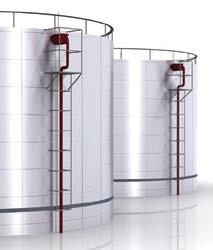

On-demand – in English or Dutch
In-house courses*
By arrangement – to suit your time, location, language
Also...
*** Storage Tanks Seminar ***
30 November 2023 – Rotterdam, NL
More choices, information and registration at www.eemua.org

Above ground flat bottomed storage tanks A guide to inspection, maintenance and repair Pub icat on 159 Edition 5
. . . .
. United Kingdom Netherlands PAGE 13 TERMINAL NEWS AFRICA & THE MIDDLE EAST NEWS UPDATE ENERGY TRANSITION
WOOD TO DESIGN FUTURE GRID WITH NATIONAL GAS
Consulting and engineering company, Wood, is working with independent gas supplier, National Gas to ensurethe secutity and sustainability of Britain’s gas transmission system.
National Gas currently operates the entire gas transmission system in Great Britain and has appointed Wood to digitally upgrade 7,600 km of essential pipelines, compressor stations and terminal infrastructure as part of their commitment to energy transition.
Over five years, Wood will apply digital solutions to transform National Gas infrastructure to modern, cyber-secure technology across their entire network of critical assets across Britain.
Wood is also delivering specialist hydrogen studies to National Gas on its National Transmission System (NTS) to support its target of achieving net zero by 2050. Wood Virtuoso, a digital twin solution, will analyse the characteristics of blended hydrogen and natural gas and advise on the level of investment required to repurpose the NTS infrastructure.
Azad Hessamodini, Wood’s executive president of consulting, says: ‘This work demonstrates the intrinsic link between digitalisation and decarbonisation and Wood’s expertise to deliver tangible solutions that drive towards the industry’s net zero goals…Through our ability to combine hydrogen and digital expertise, we are also providing a path for NGT to transition to low-carbon fuels through hydrogen blending, further supporting the UK’s net zero ambitions.’
UNIPER LAUNCHES RESEARCH FOR HYDROGEN PROJECT
Uniper’s HyStorage research project aims to investigate the influence of hydrogen on porous rock formations in order to determine the feasibility and integrity of pore storage facilities for the storage of hydrogen. A specialised gas-technical unit for the storage test has been set up on a designated drilling site at Uniper Energy Storage’s Bierwang site.
Commissioning is currently in progress and the first hydrogen will be injected from September onwards.
The storage test intends to inject different methane-hydrogen gas mixtures with a 5%, 10 % and 25 % hydrogen content into a smaller former natural gas reservoir in three operating phases. The gas will be withdrawn again after a standstill period of about three months. The storage horizon is independent of the existing Bierwang natural gas storage facility. Individual investigation of each site is needed to store hydrogen in porous rock reservoirs.
The collected data will be analysed and evaluated. Reliable technical assessments for the storage potential can be expected as early as 2024.
WÄRTSILÄ AND AGL COMPLETE CONSTRUCTION OF AUSTRALIA ENERGY STORAGE FACILITY
Technology group Wärtsilä has completed construction at the Torren Islands Grid Scale battery energy storage system (ESS) with AGL Energy Limited, one of Australia’s leading integrated energy companies.
The 250-megawatt (MW) / 250 megawatt-hour (MWh) ESS installed at Torrens Island in South Australia is the second-largest operational battery in the country.
The project delivers a major step towards Australia’s renewable energy future, supporting the nation’s decarbonisation goals. The flexible capacity provided by Wärtsilä’s advanced ESS balances the supply of energy from renewable sources, maintaining the stability and reliability of the grid.
The ESS will provide enough electricity to power approximately 75,000 South Australian homes for one hour, with the potential to extend the duration to four hours in the future.
The Torrens Island system will operate in grid-following mode, transitioning to grid-forming mode (virtual synchronous generation – VSG) later. This groundbreaking feature makes it the largest energy storage solution capable of operating in VSG mode, enabling fast response times and futureproofing operations for the Torrens Island facility. The solution is supported by Wärtsilä’s advanced GEMS Power Plant Controller.
TOTALENERGIES ACQUIRES 40% INTEREST IN CARBON STORAGE EXPLORATION LICENSE
TotalEnergies has signed an agreement with CapeOmega Carbon Storage AS, a wholly owned subsidiary of CapeOmega AS, to acquire the 40% participating interest held by CapeOmega in the CO 2 storage exploration license ExL004 (the ‘Luna’ project).
Located 120 km offshore Bergen, Norway, in 200 m water depth, ExL004 covers an area of 453 km². It is adjacent to the license where the Northern Lights CO 2 storage project (TotalEnergies, 33%) is under development, with a first phase due to start in 2024.
ExL004 is operated by Wintershall DEA Norge AS with a 60% participating interest. ‘This transaction is an important milestone to grow our CO 2 storage offering: subject to a successful exploration, this area could enable the storage of several hundred million tons of CO 2 from hard-to-abate industries in Europe,’ says Arnaud Le Foll, senior vice-president new business – carbon neutrality at TotalEnergies.
He adds: ‘With the Northern Lights start-up in 2024 and other projects under development in the Netherlands, Denmark and the UK, TotalEnergies is building a world-class carbon storage portfolio across the North Sea. Norway will play a leading role in this portfolio thanks to its large geological storages and supportive government policies.’
STOLTHAVEN TERMINALS DAGENHAM ACHIEVES ISCC
Stolthaven Terminals has announced that its terminal in Dagenham, UK has achieved the ISCC – International Sustainability and Carbon Certification, an internationally recognised standard in the biofuels and energy industry that demonstrates the fuel, biobased feedstocks and renewables stored on site meet defined sustainability criteria.
Gary St Pier, Stolthaven Dagenham’s operations excellence manager says: ‘This certification confirms our biofuels credentials, which are increasingly
Australia
United Kingdom
United Kingdom
PAGE 14 NEWS UPDATE ENERGY TRANSITION
Norway Germany
valuable to our customers as more of them require storage for bio-based products. The ISCC also reinforces our own commitment, both here in Dagenham and as a global business, to operating as sustainably as possible.’

Stolthaven Terminals is committed to continuously enhancing the sustainability of our operations and reducing our environmental impact.
UM GROUP UNVEILS SOLAR PANEL PROJECTS IN HUNGARY AND BELGIUM

Molasses marketing and trading, UM Group has announced that two companies with the group have taken steps towards becoming more sustainable.
UM Argos Feed in Hungary and UM Tameco in Belgium have installed solar panel arrays at their respective facilities. The solar panel projects form an important part of UM Group’s sustainability strategy which was launched earlier this year.
The 44 kWp solar power plant at the UM Argos Feed site in Hungary includes 80 solar panels with the possibility of adding more in the future. The plant is expected to produce 49,616 kWh a year, feeding 9,625 kWh back into the country’s national grid during the summer months.
The UM Tameco site in Belgium has a capacity of 29 kWp for 64 panels, the maximum on the flat roofs available. Expected production is 26,000 kWh with the company potentially using over 90% of the power generated itself.
UM Group will be monitoring the success of the two solar panel projects with a view to installing similar systems at other sites operated by the business.
AUMA CORALINK Discover our digital ecosystem SAVE RESOURCES AUMA SERVICE coralink.auma.com E x p e r t c are fo r yo ur ac tua to r s CO R A LI N K
PAGE 15 TERMINAL NEWS AFRICA & THE MIDDLE EAST NEWS UPDATE ENERGY TRANSITION
Belgium
INOXPA LAUNCHES DINAMIX SMX SIDEENTRY AGITATOR
INOXPA has announced the launch of the Dinamix SMX side-entry agitator range. It offers an adaptable system using standard components to produce many different configurations, avoiding the need to manufacture made-to-measure agitators.
The concept’s success is based on adaptability, responsiveness and efficiency. Products are configured using a system of modules, interfaces and structural rules. The range is configured with different standardised supports and flanges, and power ranging from 0.18 kW to 22 kW.
Side-entry agitators are a cost-effective solution for process and storage tanks in the food, pharmaceutical and cosmetic industries. The agitator features: stainless steel lantern, gear drive with hollow shaft and more robust fitting, optional hygienic design, standardised EN 1092-1 type 01 PN 10 flange, ATEX certification, shut-off system, mechanical seal with hidden springs and a T16 Gamma propeller.
SHERWIN WILLIAMS ANNOUNCES HEATFLEX CUI COATINGS
Sherwin-Williams Protective and Marine has announced its new line of Heat-Flex CUI-mitigation coatings to help mitigate the dangerous condition of corrosion under insulation (CUI).
The line includes Heat-Flex ACE (advanced CUI epoxy), which is an ultra-high-solids epoxy novolac developed with a functional chemical enhancement for CUI mitigation. In addition, three coatings featuring a high concentration of micaceous iron oxide (MIO) pigment round out the lineup, including Heat-Flex 750, Heat-Flex 1200 Plus and Heat-Flex 650.
Mark Rubio, energy business manager at Sherwin-Williams says: ‘The battle against CUI is never-ending, as coated steel encapsulated in insulation will inevitably corrode over time. Our goal is to mitigate that corrosion process for as long as possible, and we’ve developed some high-performance coatings that enable just that. For example, Heat-Flex ACE is the best product we’ve tested for long-term CUI mitigation. We anticipate it becoming a preferred specification
solution as the industry gains experience with this enhanced CUI-mitigation system. We have also boosted the market’s CUI-mitigation capabilities for existing specifications with the three MIOenhanced Heat-Flex coatings.’
PORT OF ANTWERPBRUGES LAUNCHES DRONE NETWORK
The Port of Antwerp-Bruges has partnered with DroneMatrix, SkeyDrone and Proximus to create a network of six autonomous drones. The D-Hive drone-in-a-box network is a world-first that makes an important contribution to the overall security of the complex port environment. The drones will perform daily flights in the Antwerp port area, Belgium, covering an area of more than 120 km².
The network will act as additional eyes to help coordinate smooth, safe and sustainable operations in this complex environment. The drones will offer a perspective from the air and enable port authorities to manage, inspect and supervise a large area, quickly and effectively. The port will use the drones for a range of functions including berth management, monitoring, infrastructure inspections, oil spill and floating waste detection, and to support security partners during incidents.
The 18 daily BVLOS (Beyond Visual Line of Sight) drone flights will be remotely controlled from a command-and-control centre in the heart of the port. The
operational permit was built around a new BVLOS framework (known as preUspace airspace), built by Skeydrone and approved by the BCAA (Belgian Civil Aviation Authority) and EASA (European Union Aviation Safety Agency), as an appropriate and safe framework for BVLOS drone flights.
SECURING ENERGY FOR EUROPE SIGNS FOURYEAR CONTRACT WITH OMAN LNG

Under the agreement, Securing Energy for Europe (SEFE) will receive 0.4 MTPA from Oman LNG. The agreement is based on a 4-year contract, starting in 2026.
The signing of agreement between SEFE and Oman LNG marks a milestone as SEFE becomes the first German firm to receive Omani LNG in the partnership between Oman LNG and international energy firms.
Mahmoud Al-Baloushi, CCO of Oman LNG says: ‘The term-sheet signing with SEFE marks another milestone, where the Omani LNG will be accessing new market through Germany, and beyond. Going further, the agreement leverages our constant efforts to add value to Oman’s economy through growth and
Port of Antwerp-Bruges
Inoxpa
Oman
PAGE 16 NEWS UPDATE PRODUCT LAUNCHES NEWS UPDATE LNG
Sherwin-Williams
collaborations, especially as we see Oman tapping further on Germany’s technologies and market, more broadly, thus creating a win-win for both.’
‘As pioneers among German companies to embark on this partnership, SEFE is proud to lead the way towards enhanced collaboration. The partnership with Oman LNG diversifies SEFE’s portfolio and reinforces our efforts to continue to reliably supply our customers with energy,’ adds Egbert Laege, CEO of SEFE.
EL MUSEL LNG TERMINAL RECEIVES ITS FIRST COMMERCIAL SHIP
Enagas LNG terminal, El Musel, Gijón, Spain has announced it has received the its first commercial ship, Gaslog Warsaw, after successfully completing the unloading of the first two LNG gas tankers required for the commissioning of the terminal.
The commissioning of El Musel is a milestone for the start of commercial operations of the terminal, which is part of the Government’s More Energy Security Plan, and will strengthen the security of energy supply in Europe.
Jarmo Stoopman, managing director at Gate Terminal, says: ‘Now that all elements are in place, we are happy that today we can start with the construction of this important expansion. We look forward to working with our contractors and ensuring safe and timely construction of this 4th tank.’
LEDWOOD AWARDED £13 MILLION CONTRACT FOR GRAIN LNG
Pembroke Dock-based Ledwood Mechanical Engineering has begun work on a £13 million (€15.1 million) contract to expand the capacity of the largest LNG terminal in Europe located on the Isle of Grain, UK.
Working on behalf of a VINCI Joint Venture (EVT), Ledwood will fabricate 300 tonnes of steel and 280 linear metres of pipework before installation and testing on-site. The contract will create and safeguard up to 65 jobs.
SUMA
This project will create a 190,000 m³ liquified natural gas reservoir as part of the programme to expand the capacity of Europe’s largest LNG terminal. The new full containment tank will consist of a 9% nickel steel inner tank with a prestressed concrete outer shell.
Liam Revell, commercial director for Ledwood, says: ‘Having been instrumental in the construction of the UK’s first three LNG import terminals: South Hook, Dragon and Isle of Grain we provide project management, manufacture and installation of pipework, tanks and mechanical engineering for the LNG sector.’
Netherlands

GATE TERMINAL STARTS CONSTRUCTION OF 4TH LNG TANK AT PORT OF ROTTERDAM
Gate Terminal and its shareholders Gasunie and Vopak, have announced that the final investment decision has been taken to expand Gate Terminal’s storage and regasification capacity in the Port of Rotterdam, the Netherlands.
The €350 million expansion consists of a new LNG storage tank of 180,000 m³ and an additional regasification capacity of 4 BCM per year. The new capacity is already rented out under long-term commercial agreements and is expected to be ready for operation by the second half of 2026.
The Gijón terminal could contribute up to 8 billion m3 of LNG capacity per year to Europe’s security of energy supply. SUMA
The new tank will be constructed alongside the three existing LNG tanks, next to the waterside. Once all envisaged projects at Gate Terminal have been
E-Mail:
SUMA
BRASUMA
■
■
■ Long-term reliability
■ High operational safety

PAGE 17 TERMINAL NEWS AFRICA & THE MIDDLE EAST NEWS UPDATE LNG

Rührtechnik GmbH
Str. 21 | 87477 Sulzberg/Germany
Martinszeller
info@suma.de | www.suma.de/en
America Inc. (USA)
| www.gosuma.com
Ltda. (Brasil)
for longterm digester efficiency?
| www.brasuma.com Looking
65 years of experience in mixing of various substrates
Tailored solutions
■ User friendly application , the leading innovator in advancing mixing technology.
United Kingdom
completed, the terminal will have a total regas capacity of 20 billion m³ per year.
Spain
HONEYWELL TO ACQUIRE SCADAFENCE
Honeywell has announced it has agreed to acquire SCADAfence, a leading provider of operational technology (OT) and Internet of Things (IoT) cybersecurity solutions for monitoring large-scale networks. SCADAfence provides asset discovery, threat detection and security governance which are key to industrial and buildings management cybersecurity programs.
Kevin Dehoff, president and chief executive officer, Honeywell Connected Enterprise says: ‘A simple breach in the OT environment has the potential to create safety and business continuity risk for organisations of all sizes. OT assets are inherently different than those in the IT environment as they are domain specific…Adding SCADAfence’s product portfolio will strengthen our capabilities and help our customers defend themselves against cyber security risks which are progressively increasing.’
‘We are thrilled to join Honeywell as we work towards fulfilling our mission of empowering industrial organisations to operate securely, reliably and efficiently… With this acquisition, we are poised to deliver some of the most advanced OT security technology to Honeywell’s broad customer base…’ adds Elad Ben Meir, chief executive officer, SCADAfence.
SCADAfence is headquartered in Tel Aviv, Israel and will expand Honeywell’s Cybersecurity Center of Excellence in Tel Aviv.
The transaction is expected to close in the second half of 2023.
NOVA TRANSPORTADORA DO SUDESTE APPOINTS ATMOS FOR PIPELINE SIMULATION
Nova Transportadora do Sudeste (NTS) has become the latest Latin American pipeline company to select Atmos for its natural gas transmission network.
The NTS network is made up of more than 2,000 km of pipeline and has the highest capacity of all pipelines in Brazil, with a transport contractual capacity of 158.2 million m3 of gas per day. NTS transports natural gas through a pipeline system that crosses Brazil’s most industrialized region and has links to the states of Rio de Janeiro, Minas Gerais and São Paolo.
NTS transports gas to areas that are responsible for around 50% of gas consumption in Brazil. NTS selected Atmos’ Simulation Suite (SIM) to help better understand the pipeline’s behaviour, improve operations and maximise efficiency.
The software is in operation in over 20 countries, supporting approximately 45,000 km of pipelines globally.
NORDIC STORAGE TRIALS NEW OMS
Nordic Storage is implementing a new and improved operating management system (OMS).

André Svensson, one of the company’s HSEC coordinators, explains the benefits: ‘The new OMS is a better and more effective way to ensure the safe, reliable, and responsible operations throughout our business. The aim of the OMS is to achieve quality at all levels and ensure the safety of our company, our customers, and our employees. The OMS describes how we conduct our business, why we do it and evaluates so that we can continuously improve our operations. This enables us to act in accordance with best practice. Everything we do must be anchored in a controlled system that everyone knows about.’
Last year, Nordic Storage attended the Aquarius Energy International HSEC Summit in Fujairah. For the first time the HSEC departments from the entire Aquarius Energy group gathered to share best practice and participate in safety seminars and on-site visits. Svensson shares the key takeaways: ‘We are stronger together than if we function as individual units in the group. By having the summit, the connection within the group becomes stronger and we can share experiences, which benefits everyone in the future.’
Australia
NSW PORTS ANNOUNCES SMARTFLOW DIGITAL SOLUTION IS LIVE
NSW Ports, Australia, has announced its selected comprehensive solutions provider, Platform8 and partners Smartflow digital solution for shipto-shore ISGOTT processes – are now live.
This solution is streamlining NSW Ports’ operations, boosting safety, and ensuring compliance within the maritime industry. The improved visibility and collaboration drives cost and carbon savings.
Josh Davidson, head of technology at NSW Ports says: ‘Working with Platform8 and Smartflow has been a seamless experience. Their solutions have proven to be efficient and reliable. We are impressed with the ease of implementation and the value they bring to our operations. We are excited to explore more of their solutions across our platform.’
NORTHWEST TANK JOINS TANKNOLOGY
Tanknology has announced the acquisition of Northwest Tank and Environmental Services (Northwest Tank), a Washington-based (USA) provider of underground storage tank (UST) compliance services and metre calibrations across various states including Washington, Oregon, Idaho, Montana and more. Allen Porter Tankology president and CEO, says: ‘The transaction is expected to provide significant benefits to both
USA
Europe Israel Brazil PAGE 18 NEWS UPDATE DIGITALISATION
companies’ customer base by adding highly skilled employees, expanding geographic capacity and offering additional proprietary testing and inspection services. Northwest Tank shares in our commitment to a customercentric culture and delivery of the highest quality of service.’
He continues: ‘Our objective has always been to meet the compliance needs of our customers and international partners. The integration of Northwest Tank’s expertise, services, and processes, further expands this mission and positions Tanknology toward many years of growth and industry leadership.’
RIGHTSHIP EXPANDS ACCESS TO DATA PLATFORM
ESG-focused digital maritime platform, RightShip, has launched RightSTORE, a self-service e-commerce platform providing access to RightShip data for accessible products.
As part of RightShip’s commitment to democratising data for the maritime industry, RightSTORE will also host a range of other zero-harm products from trusted partners.
Developed and delivered from RightShip’s technology hub in Singapore, RightSTORE is the key to the proverbial engine room, providing unprecedented levels of access to RightShip’s existing data and information, without the need for a traditional subscription. This new point of entry provides an alternative and cost-effective route to information beyond the traditional subscription model, breaking down data silos and empowering opportunities for innovation beyond the maritime sector.
Steen Lund, CEO, RightShip says: ‘RightShip has always been steadfast in our belief that no single person or entity is responsible for harm reduction; instead, it is the responsibility of everyone at all levels and in all businesses to be a proponent for zero-harm…Through RightSTORE, everyone from students, researchers and educators, through to tech start-ups, consultancies and regulators, will have access at the touch of a button – it’s a powerful opportunity and I’m excited to see where the industry takes it.’
Training to prevent loss of hazardous substances…
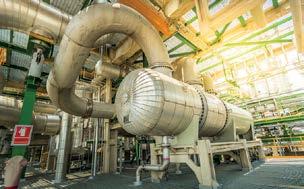

EEMUA's MIPC® course helps practitioner-level engineers to be on-site and on top of the latest industry developments and good practice in the primary containment of hazardous substances.
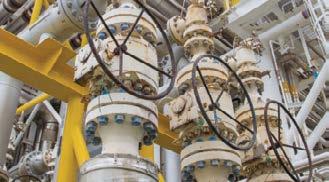
Blending live, online classes, 1-1 sessions with expert tutors, and e-learning, all enhanced by a Mentor’s support and guidance throughout, EEMUA’s Mechanical Integrity Practitioner Certificate course delivers in-depth training to engineers where they work – giving professionals flexibility to learn on-site or on-call, for industry-reconised, 5-year certification.

2-hour Induction adapts the MIPC course to the engineering needs of each Learner and their site/s. Only two MIPC courses run each year...
Next MIPC course of 2023: Learning starts October 2023. Induction to fit work diaries from September 2023.
Registration open now.
For details please contact EEMUA online-learning@eemua.org +44 (0)20 7488 0801 www.eemua.org
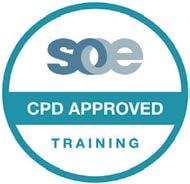
TERMINAL NEWS AFRICA & THE MIDDLE EAST
Singapore
MIPC® shortlisted for the Best E-learning/ Online Education Initiative memcom membership excellence awards 2020 and 2022
PAGE 19 TERMINAL NEWS AFRICA & THE MIDDLE EAST NEWS UPDATE DIGITALISATION
FITNESS-FOR-SERVICE (FFS)
E²G | The Equity Engineering Group, Inc. provides world-class engineering support for storage tank owners & operators. Our team of experts leverages design, inspection, and advanced analysis experience to solve problems both big and small.
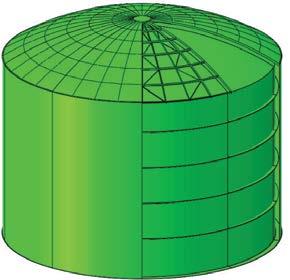

SAFETY. RELIABILITY. INTEGRITY.
WE SOLVE PROBLEMS
⊲ Shell Distortions
⊲ Foundation Settlement
⊲ Structural Concerns
⊲ Overpressure & Overfill
⊲ Cracking & Brittle Fracture
VISIT CONTACT OUR TEAM www.E2G.com Sales@E2G.com ANSWERS FOR TODAY. INSIGHTS FOR TOMORROW. P: +1.216.283.9519 © 2023 E²G | The Equity Engineering Group, Inc.
E 2 G SOFTWARE
We help you ensure safety, manage risk, and maintain profitability throughout your tank’s lifecycle. DAMAGE MECHANISMS ASSESSMENTS
s )
RISK-BASED INSPECTION (RBI)
EQUITY ENGINEERING PRACTICES (EEP
⊲ Corrosion & Metal Loss
IMPROVE STORAGE TANK RELIABILITY
PRODUCTION RESTARTS AT NESTE’S SINGAPORE REFINERY AFTER SHUTDOWN
The production of renewable diesel at Neste’s Singapore refinery expansion restarted in early August 2023.

The production line at the expanded part of the refinery was shut down in June 2023 for unexpected equipment repairs.
The ramp-up of the production at the expanded part of the refinery continues and is planned to be completed by the end of the year.
Sustainable aviation fuel (SAF) production in Singapore is scheduled to start during the third quarter as communicated in Neste’s half-year report in July 2023.


The Singapore refinery expansion doubles Neste’s production capacity in Singapore. With the growth projects in Singapore and Martinez, the company targets to increase its total nameplate capacity of renewable products to 5.5 million tonnes in early 2024.
INEOS AND SINOPEC COMPLETE PETROCHEMICALS DEAL


Global chemical business, INEOS has completed the formation of a 50/50 joint venture with oil and gas business, SINOPEC for the Tianjin Nangang Ethylene Project, China announced in December 2022, which is currently under construction by SINOPEC and expected to be onstream by April 2024.
The petrochemical complex includes a 1.2 MTPA cracker, a new 500ktpa HighDensity Polyethylene plant to produce INEOS pipe grade under license and 11 other derivative units.
The completion of the agreement marks the continued progression of the significant petrochemical deals announced by the parties last year, and highlights the close relationship and growing collaboration between SINOPEC and INEOS.
STOLTHAVEN SINGAPORE WINS DOW SEA S4TAR AWARD
Stolthaven Terminals’ Singapore facility has won the Dow SEA S4TAR award for terminals for the third year in a row.
Dow Chemicals established the S4TAR SEA (South East Asia) programme to enhance collaboration with its logistics services partners in the region and recognise strong performance in safety, service, sustainability and social responsibility.
Stolthaven Singapore underwent a thorough assessment by Dow and scored highly in all four areas. General manager Chek Chai Foo says: ‘Dow rated our service as consistently good and reliable and this was further enhanced through our electronic data interchange project with them. We also scored much higher on sustainability than the three runners-up. This is due to our many local sustainability initiatives, including green terminal transportation.’
China PAGE 21 TERMINAL NEWS AFRICA & THE MIDDLE EAST NEWS UPDATE ASIA
Singapore Singapore














SANTOS BAYU-UNDAN JOINT VENTURE AND TIMOR GAP SIGN MOU FOR CCS
Australian oil and gas exploration and production company, Santos and its Bayu-Undan joint venture partners have signed a memorandum of understanding (MOU) with national oil company, Timor Gap. This is to explore partnership opportunities for the proposed BayuUndan carbon capture and storage (CCS) project offshore Timor-Leste, Asia.
The MoU follows four non-binding MOUs for CO 2 supply to Bayu-Undan CCS that indicate demand for CO 2 storage at BayuUndan CCS could be more than 10 MTPA.
The MOU with Timor Gap includes sharing information about Bayu-Undan CCS and exploring potential partnership opportunities, including equity participation for Timor Gap in the BayuUndan CCS project.
ENI ACQUIRES CHEVRON’S ASSETS IN INDONESIA
Eni has announced the acquisition of Chevron interests, including operatorship, in the Indonesian blocks Ganal PSC (Chevron 62%), Rapak PSC (Chevron 62%) and Makassar Straits PSC (Chevron 72%), in the Kutei Basin, offshore East Kalimantan.
Eni already has a 20% interest as nonoperator in the Ganal and Rapak blocks. The acquisition of Chevron’s assets in Indonesia will allow Eni to fast-track the development of the IDD project, leveraging its strong presence in the East Kalimantan area as well as the synergies with Eni-operated Jangkrik infrastructures, the existing Bontang LNG facility, and the domestic gas market. This acquisition is also in line with Eni’s energy transition strategy to increase the share of natural gas production to 60% by 2030, in conjunction with global demand for accessible, low-carbon and affordable energy. This operation comes shortly after the announcement of Eni’s agreement to acquire Neptune Energy, holding – among others – a significant presence in Indonesia and an excellent fit with Eni operations in East Kalimantan.
Customised tank mixing solutions
Essential
advantages with Körting tank mixing systems:

• low energy input
• no sealing problems
• low investment costs
• no unmixed dead zones
• wear-resistant operation
• no maintenance in the tank
• complete mixing of tank content
• optimisation with (CFD) Computational Fluid Dynamics
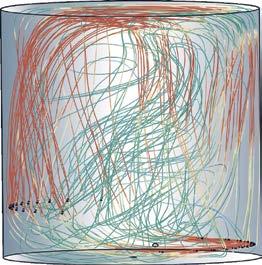
+49 511 2129-221 | sales@koerting.de | koerting.de Asia
NEWS UPDATE ASIA
Indonesia
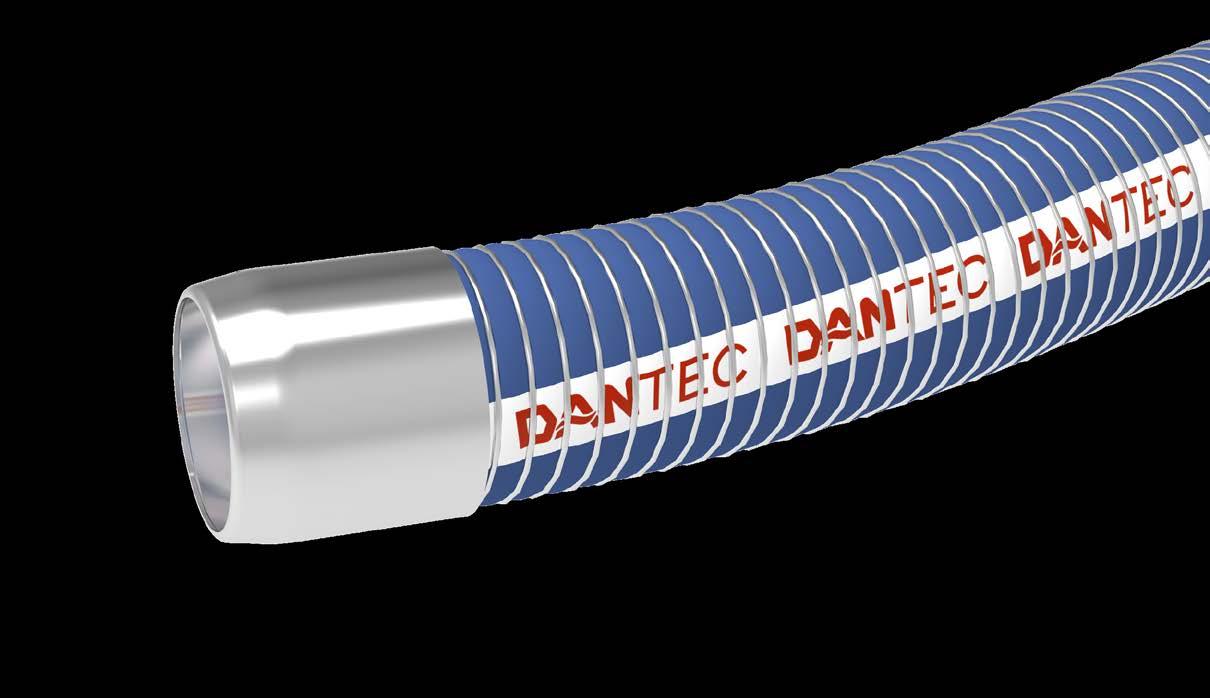
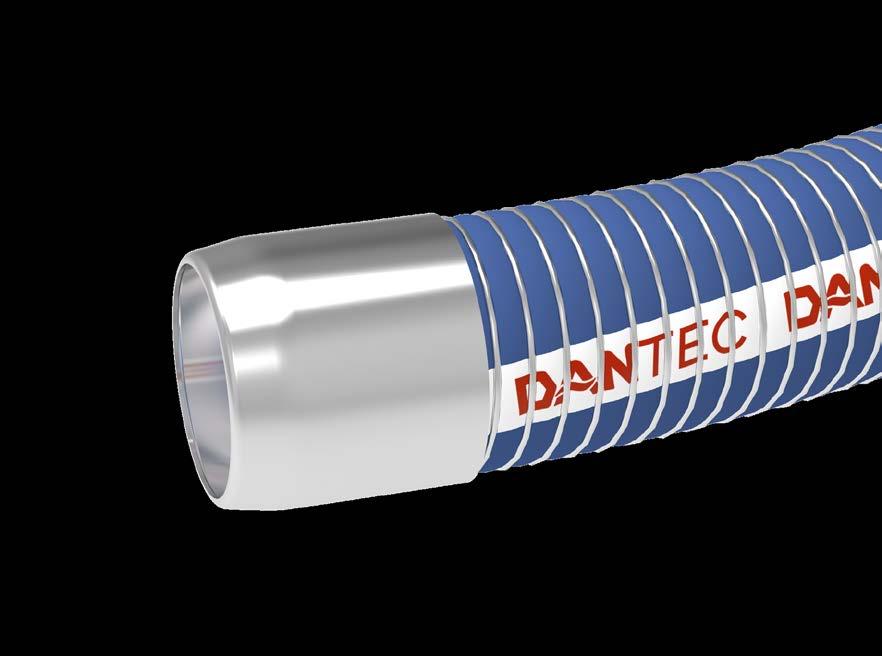
EXPLORE OUR SOLUTIONS IN UPCOMING EVENTS: TANK STORAGE CONFERENCE & EXHIBITION, 21ST SEPTEMBER 2023 STOCEXPO,12-13TH MARCH 2024 WORLD LEADERS IN COMPOSITE HOSE TECHNOLOGY www.dantec.com sales@dantec.com +44 (0)151 678 2222 • OIL & CHEMICAL TRANSFER HOSES • HOSES FOR LIQUIFIED GASES SUCH AS LPG, AMMONIA AND LCO2 • IN PLANT TRANSFER HOSES
Incident Report: A summary of the recent explosions, fires and leaks in the tank storage industry
31 August 2023
USA
Leak at Calumet hydrogen plant to impact throughput
A leak detected in the steam recovery system at Calumet Specialty Products Partners’ Montana renewable hydrogen plant is limiting throughput until repaired. The company, which manufactures and produces specialty products and renewable fuels, said the leak was detected earlier this month and the repair is expected to be completed in late September.
The Montana plant’s redundant hydrogen systems allow it to continue to run at reduced rates.
The plant expects 8,000 to 8,500 barrels per day of renewable product sales for the third quarter, and the facility is currently processing all untreated feed, according to Calumet.
18
August 2023
SRI LANKA
Fire engulfs Sri Lanka chemical storage facility

A fire broke out in a chemical storage facility in the Homagama Industrial Zone (Katuwana, Sri Lanka) on 17 August.
Seven fire trucks attended the scene, in an attempt to douse the flames at the chemical factory.
A special team of Sri Lanka army personnel was also called to assist with managing the blaze.
The Disaster Management Centre has advised the residents of Homagama to wear face masks to avoid smoke inhalation. Inhaling harmful smoke can inflame lungs and airways, causing them to swell and block oxygen.
No casualties have been reported in the incident.
27 July 2023
UKRAINE
Russia attacks Ukraine port infrastructure
In an overnight missile attack, Russian forces hit port infrastructure in Ukraine’s Odesa region.
The regions governor says a security guard was killed in the attack and there has been damaged to the cargo terminal.
In the previous nine days it has been recorded that Russian air strikes had caused damage to 26 port infrastructure facilities in Ukraine.
10 July 2023
IRAN
Fire at Iran Bandar Abbas Oil Refinery under control
On 10 July, a large fire broke out at Aftab’s Bandar Abbas refinery in southern Iran. It is the second largest refinery in Iran.
As the blaze developed, two of the five neighbouring tanks exploded and eight firefighters sustained superficial injuries. The fire was completely extinguished within three hours.
Unsafe operation of a truck transporting crude oil materials during a period of excessive traffic in the operational area of the refinery led to the fire, which subsequently spread to the manufacturing plant’s storage tanks, Aftab said in a release. Aftab did not reveal whether the fire damaged any processing or production units at the refinery.
PAGE 25 TERMINAL NEWS XXXXXXXXX
INCIDENT REPORT

Save
12 & 13 March 2024
the date.
TANK TERMINAL UPDATE
GREENOCK OCEAN TERMINAL

Products: Port services
Construction/expansion/acquisition: UK port operator, Peel Ports Group, has appointed Turner & Townsend to provide project and cost management for the regeneration of its Greenock Ocean Terminal at Clydeport, Scotland, UK.
As part of improvement works to the Greenock Ocean Terminal, Turner & Townsend project and cost management teams across Scotland will support Clydeport Operations with the replacement of two ship-to-store (STS) cranes, together with upgrading of associated infrastructure.
Comment: James McSporran, Clydeport port director, says: ‘At Clydeport, we are dedicated to providing quality services and effective solutions to our customers. Our partnership with Turner & Townsend on this rejuvenation project highlights our commitment.’
VOPAK EUROTANK
Capacity: 263 x 400m 3
Construction/expansion/acquisition: Vopak Eurotank Antwerp has announced that it has increased its draft to a full 14 m. The Vopak Terminal Eurotank, Antwerp, has 116 tanks and a capacity of 263,400m 3
Comment: The increase to the draft means that Vopak Eurotank Antwerp can now offer customers an enhanced service.
DURA VERMEER
Construction/expansion/acquisition: Construction and infrastructure services group, Dura Vermeer is responsible for part of the dismantling of the Rotterdam company Aluchemie on the Oude Maasweg.
Comment: The work is expected to start in October 2023. The operation should be completed by mid-2025. A small team of Aluchemie employees will continue to work to manage the dismantling in collaboration with Dura Vermeer.
ADNOC GAS

Products: Gas
Construction/expansion/acquisition: ADNOC Gas, the world-class integrated gas processing company, has announced a $3.6 billion (€3.3 billion) contract to the joint venture between National Petroleum Construction Company and Tecnicas Reunidas to expand its gas processing infrastructure in the UAE.
FLUOR
Construction/Expansion/Acquisition: Fluor Corporation has announced that it was awarded an engineering, procurement and construction (EPC) contract by Mitsubishi Chemical Group for its SoarnoL ethylene vinyl alcohol copolymer (EVOH) facility in Saltend Chemicals Park, Hull, UK.
VTTI
Products: Bio-energy
Construction/expansion/acquisition: Energy storage infrastructure companies, VTTI has begun construction on its first bio-energy production plant in the UK. When complete the plant will produce 60 gigawatt hours (GWh) of renewable natural gas per year in Lincolnshire, UK. This is enough clean energy to heat over 5,000 homes annually.
Comment: The facility will be part of VTTI’s growing portfolio of bio-energy facilities in Europe. Commercial operations at the facility are due to begin in the second half of 2024.
Comment: Over 70% of the award value will flow back into the UAE’s economy under ADNOC’s successful In-Country Value (ICV) program, supporting local economic growth and diversification.
Comment: When complete and operational in 2025, the Saltend Chemicals Park EVOH facility will be Mitsubishi Chemical Group’s second largest SoarnoL site in the world.
PAGE 27 TANK TERMINAL UPDATE
United Kingdom
Antwerp
UAE
Rotterdam
United Kingdom
United Kingdom
TANK TERMINAL UPDATE
Belgium
LBC TANK TERMINALS
Capacity: 80,000 m³
Construction/expansion/acquisition: LBC Tank Terminals has taken the final investment decision to expand the terminal in Antwerp, Belgium and has started the construction of 28 tanks, collectively providing a significant storage capacity of 80,000 m³.
Comment: ‘With high energy prices, chemicals production in northwestern Europe is under increasing competitive pressure, while Middle Eastern and USbased producers have an advantage with access to lower priced feedstock,’ says Erik Kleine, general manager Europe.
PROJECT SPOTLIGHT: Odisha, India
INDIAN OIL CORPORATION
Estimated budget: €67.7 million
Contract value: €33.1 million
Main contractor: Artson Engineering Limited
Location: Odisha, India
Expected completion date: Q2 2024
INDIAN OIL (IOCL) plans to construct 10 new tanks Paradip Refinery. The tanks will be built along with allied facilities at the refinery. The new assets would comprise of feed tanks for diesel hydrotreater (DHDT), naphtha hydrotreating (NHT), vacuum gas oil (VGO), catalytic hydrotreating (HDT) and product tanks for MS, liquid sulphur, alkylate, and PCK.
In November 2020, Artson Engineering Limited (AEL) was awarded the EPC contract for the project. The contract scope includes the design, supply, fabrication, testing, and commissioning of storage tanks, including associated works. Construction work on the project then began in February 2021.
QUANTEM
Cost: $56 million (€33.8 million)
Construction/expansion/acquisition:
Provider of bulk liquid storage terminals across Australia and New Zealand, Quantem has announced a project to more than double the diesel storage capacity at its Pelican Point terminal in Adelaide, South Australia.
Comment: Quantem managing director and CEO Nick Moen says: ‘This project is a critical component of enhancing Australia’s domestic fuel security and safeguarding future supplies for the country’s transport sector and industrial supply chains which are vital to Australia’s infrastructure requirements.’
The additional tanks will increase the ullage and help sustain the refinery’s crude throughput during the outage of any secondary processing unit.
THE PROJECT SO FAR
The intital plan and budget was developed in November 2018. By December 2019, IOCL had issued an Engineering, Procurement, and Construction (EPC) tender for the storage tanks on a Lump Sum Turnkey (LSTK) basis for the project.
In mid-2021, SOPAN was awarded a contract for the composite works, and by the end of the year, the overall progress of the project had reached 60% completion.
A year later, in December 2022, the piping, structural fabrication, and erection works began.

The diesel hydrotreater (DHDT) tank’s hydro test was completed in June 2023, while internal blasting and painting of the bottom and the external painting of the shell began to progress. The overall physical progress of the project has reached 86.1%, and it is scheduled for completion by April 2024.
MABANAFT
Capacity: 461,652 m 3
Construction/expansion/acquisition: Mabanaft has expanded its storage footprint into Denmark by acquiring 100% of Oiltanking’s terminal in the capital, Copenhagen. Under Mabanaft’s ownership, the terminal will continue to handle liquid fuels for road transport and the marine and aviation industries.
Comment: ‘This terminal adds another key location to our network and will enable us to expand our footprint in Europe and help us provide high-quality liquid fuel products to our customers in the region, while maintaining the highest safety and environmental standards,’ says Mabanaft CEO, Jon Perkins.
PAGE 28
Australia Copenhagen






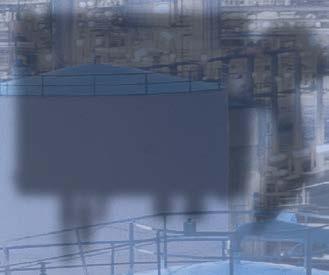




























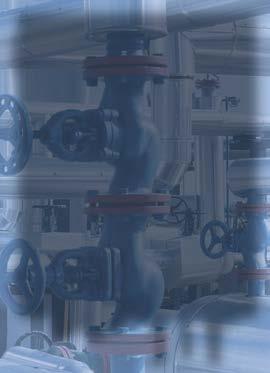









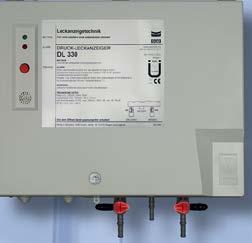

GLOBAL PROJECT UPDATE
A round-up of key terminal projects worldwide, powered by DMS Global
Quezon, Philippines
PETRONAS - BINTULU ADDITIONAL GAS SALES FACILITIES 2 (BAGSF-2)
Sectors: Gas
Facility: Storage Tanks, Liquefied
Natural Gas (LNG)
Budget: € 184,000,000
Status: Construction
Project date: 2021-Q4 – 2025-Q4
Ulsan, South Korea
KNOC - ULSAN OIL STORAGE HUB
Sectors: Onshore
Facility: Offsite & Storage Tanks
Budget: € 1,380,000,000
Status: Construction
Project date: 2009-Q1 – 2026-Q1
ENERGY WORLD - PAGBILAO (QUEZON) LNG TERMINAL
Sectors: Gas
Facility: LNG Terminal, LNG Regassification, Storage Tanks, Liquefied Natural Gas (LNG)
Budget: € 460,000,000
Status: Construction
Project date: 2006-Q2 – 2024-Q4
Jurong, Singapore
GOLAR LNG - FLOATING LIQUEFIED NATURAL GAS VESSEL CONVERSION PROJECT
Sectors: Gas
Facility: Storage Tanks, Liquefied Natural Gas (LNG)
Budget: € 1,196,000,000
Status: Engineering & Procurement
Project date: 2012-Q4 – 2023-Q4
KOGAS - MUI KE GA LNG REGASIFICATION TERMINAL
Sectors: Gas
Facility: LNG Terminal, LNG
Regassification, Storage Tanks, Liquefied
Natural Gas (LNG)
Budget: € 1,380,000,000
Status: Feasibility Study
Project date: 2019-Q3 – 2025-Q4
SAUDI ARAMCO - GAS STORAGE FACILITIES
Sectors: Gas
Facility: Storage Tanks
Budget: € 920,000,000
Status: Project Announced
Project date: 2019-Q4 – 2025-Q4
Ras Markaz, Oman
VTTI - ATT TANJUNG BIN (ATB) OIL TERMINAL
Sectors: Onshore
Facility: Offsite & Storage Tanks
Budget: € 552,000,000
Status: Construction
Project date: 2009-Q3 – 2024-Q2
Hail, Saudi Arabia
SAUDI ARAMCO - HAIL BULK PLANT
Sectors: Exploration & Upstream
Production
Facility: Offsite & Storage Tanks
Budget: € 276,000,000
Status: On Hold
Project date: 2013-Q2 – 2021-Q4
Jamnagar , India
GSFC - SIKKA FERTILIZERS COMPLEX EXPANSION
Sectors: Chemicals
Facility: Diammonium Phosphate (DAP), Phosphoric Acid, Offsite & Storage Tanks, Fertilizer, Ammonia
Budget: € 157,320,000
Status: On Hold
Project date: 2012-Q4 – 2023-Q4
Doha, Qatar
QATARENERGY - HAMAD
INTERNATIONAL AIRPORT JET A1 FUEL STORAGE TANKS
Sectors: Exploration & Upstream
Production
Facility: Offsite & Storage Tanks
OTTCO - RAS MARKAZ CRUDE OIL PARK - PHASE 2 - CRUDE OIL TANKS AND ASSOCIATED INFRASTRUCTURE
Sectors: Exploration & Upstream
Production
Facility: Offsite & Storage Tanks
Budget: € 851,000,000
Status: Project Announced
Project date: 2012-Q4 – 2025-Q4
Ras Markaz, Oman
OTTCO - RAS MARKAZ CRUDE OIL PARK - PHASES 3, 4, AND 5 - CRUDE OIL TANKS AND ASSOCIATED INFRASTRUCTURE
Sectors: Exploration & Upstream
Production
SAUDI ARAMCO - STORAGE TANKS
Sectors: Exploration & Upstream
Production, Gas, Infrastructure
Facility: Storage Tanks
Budget: € 230,000,000
Status: Engineering & Procurement
Project date: 2020-Q2 – 2022-Q4
Budget: € 368,000,000
Status: Construction
Project date: 2018-Q4 – 2022-Q3
Facility: Offsite & Storage Tanks
Budget: € 193,200,003
Status: Project Announced
Project date: 2012-Q4 – 2027-Q4
PAGE 30
Tanjung Bin, Johor, Malaysia
Bintulu, Sarawak Malaysia
Saudi Arabia
Binh Thuan, Vietnam
TANK TERMINAL UPDATE
Saudi Arabia
PTT - LPG STORAGE TERMINAL
Sectors: Gas
Facility: Liquefied Petroleum Gas (LPG), Storage Tanks
Budget: € 460,000,000
Status: On Hold
Project date: 2013-Q1 – 2022-Q4
GULF PETROCHEM - FUJAIRAH OIL STORAGE TERMINAL FACILITYPHASE 2 - EXPANSION
Sectors: Exploration & Upstream
Production
Facility: Offsite & Storage Tanks
Budget: € 276,000,000
Status: On Hold
Project date: 2014-Q1 – 2025-Q1
VTTI - IL&FS PRIME TERMINALS
FZC (IPTF) - PHASE 2 - EXPANSION
Sectors: Exploration & Upstream
Production
Facility: Offsite & Storage Tanks
Budget: € 138,000,000
Status: EPC ITB
Project date: 2016-Q1 – 2024-Q1
BPGIC - FUJAIRAH OIL TERMINALOVERVIEW
Sectors: Exploration & Upstream
Production, Onshore
Facility: Offsite & Storage Tanks
Budget: € 516,120,000
Status: FEED
Project date: 2013-Q1 – 2025-Q2
ZAHARA GROUP - AL HAMRIYAH STORAGE TERMINAL
Sectors: Exploration & Upstream
Production
Facility: Offsite & Storage Tanks
Budget: € 184,000,000
Status: On Hold
Project date: 2014-Q1 – 2024-Q2
QATARENERGY - OIL STORAGE TANKS OVERHAUL WORKS
Sectors: Exploration & Upstream
Production
Facility: Offsite & Storage Tanks
Budget: € 55,200,000
Status: Construction
Project date: 2016-Q3 – 2024-Q1
SKA ENERGY - KAFZA TANK
TERMINAL - PHASE 3 - OIL
STORAGE TANK
Sectors: Gas
Facility: Storage Tanks
Budget: € 230,000,000
Status: On Hold
Project date: 2013-Q1 – 2024-Q4
ADNOC - EMARAT - FUJAIRAH
TERMINAL - PHASE 3 - EXPANSION
Sectors: Exploration & Upstream
Production
Facility: Offsite & Storage Tanks
Budget: € 36,800,000
Status: On Hold
Project date: 2014-Q3 – 2024-Q4
SAUDI ARAMCO - BULK PLANT
TERMINAL
Sectors: Onshore
Facility: Offsite & Storage Tanks
Budget: € 368,000,000
Status: On Hold
Project date: 2016-Q4 – 2020-Q1
KOC - WARA PRESSURE
MAINTENANCE PROJECT - TRAIN 3
Sectors: Exploration & Upstream
Production, Onshore
Facility: Development Drilling & Production, Oil Field, Offsite & Storage
Tanks
Budget: € 172,040,000
Status: Construction
Project date: 2013-Q2 – 2023-Q2
SAUDI ARAMCO - STORAGE TANKS AND ASSOCIATED EQUIPMENT
Sectors: Gas
Facility: Storage Tanks
Budget: € 368,000,000
Status: Construction
Project date: 2015-Q1 – 2022-Q2
IL&FS PRIME TERMINALS FZCFUJAIRAH OIL TERMINALS - PHASE 2 - OIL TERMINAL FARM
Sectors: Exploration & Upstream
Production, Onshore
Facility: Offsite & Storage Tanks
Budget: € 73,600,000
Status: On Hold
Project date: 2017-Q1 – 2023-Q2
GTI FUJAIRAH FZC - FUJAIRAH OIL STORAGE TERMINAL - PHASE 3PETROLEUM TANK FARM
Sectors: Exploration & Upstream
Production, Gas
Facility: Offsite & Storage Tanks
Budget: € 92,000,000
Status: On Hold
Project date: 2010-Q1 – 2023-Q4
SAUDI ARAMCO - STORAGE TANKS AND ASSOCIATED EQUIPMENT
Sectors: Gas
Facility: Storage Tanks
Budget: € 184,000,000
Status: Construction
Project date: 2016-Q1 – 2022-Q4
TOTALENERGIES - PAVILION ENERGY - LNG BUNKER VESSEL
Sectors: Gas
Facility: Storage Tanks, Liquefied Natural Gas (LNG)
Budget: € 27,600,000
Status: Construction
Project date: 2017-Q2 – 2023-Q1
PAGE 31
Fujairah, UAE
Thilawa , Myanmar
Fujairah, UAE
Fujairah, UAE
Fujairah, UAE
Southeast Kuwait, Kuwait
Sharjah, UAE
Halul Island, Qatar
Basra, Iraq
Fujairah, UAE
Duba, Saudi Arabia
Yanbu , Saudi Arabia
Eastern Indonesia, Indonesia
Fujairah, UAE
Jurong, Singapore
TANK TERMINAL UPDATE
SATORP - AMIRAL PETROCHEMICAL COMPLEX - PACKAGE 5A - TANK FARM
Sectors: Petrochemicals, Plastics, Onshore
Facility: Offsite & Storage Tanks
Budget: € 552,000,000
Status: Engineering & Procurement
Project date: 2017-Q3 – 2025-Q4
MITSUI OSK LINES - BRASSAVOLA LNG BUNKER VESSEL
Sectors: Gas
Facility: Storage Tanks, Liquefied Natural Gas (LNG)
Budget: € 161,000,000
Status: Commissioning
Project date: 2019-Q1 – 2023-Q3
ADNOC ONSHORE - WEST TO EAST PIPELINE (WEP)
Sectors: Pipeline, Onshore
Facility: Pumping Station, Offsite & Storage Tanks, Oil
Budget: € 736,000,000
Status: FEED
Project date: 2019-Q3 – 2025-Q4
IOCL - KANDLA LPG IMPORT TERMINAL AUGMENTATION
Sectors: Gas
Facility: Liquefied Petroleum Gas (LPG), Storage Tanks
Budget: € 84,272,000
Status: Construction
Project date: 2018-Q1 – 2023-Q3
SAUDI ARAMCO - HAWIYAH UNAYZAH GAS RESERVOIR STORAGE
Sectors: Gas
Facility: Storage Tanks
Budget: € 1,794,000,000
Status: Construction
Project date: 2019-Q1 – 2024-Q1
CHAN MAY LNG - THUA THIEN HUE LNG STORAGE AND REGASIFICATION TERMINAL
Sectors: Gas
Facility: LNG Terminal, LNG
Regassification, Storage Tanks, Liquefied Natural Gas (LNG)
Budget: € 1,840,000,000
Status: PMC
Project date: 2020-Q3 – 2025-Q4
QATARENERGY - RAS LAFFAN LPG BOTTLING PLANT
Sectors: Gas, Onshore
Facility: Liquefied Petroleum Gas (LPG), Offsite & Storage Tanks
Budget: € 64,400,000
Status: EPC ITB
Project date: 2018-Q1 – 2027-Q1
QATARGAS - NORTH FIELD EXPANSION PROJECT - ONSHORE FACILITIES - PACKAGE 2 - LNG STORAGE AND LOADING FACILITIES EXPANSION
Sectors: Gas
Facility: Storage Tanks
Budget: € 1,840,000,000
Status: Construction
Project date: 2019-Q2 – 2027-Q1
BPGIC - FUJAIRAH OIL TERMINAL - PHASE 3 - REFINERY & STORAGE EXPANSION
Sectors: Exploration & Upstream
Production, Onshore
Facility: Offsite & Storage Tanks
Budget: € 92,000,000
Status: EPC ITB
Project date: 2019-Q4 – 2025-Q2
SK ENERGY - PHILIPPINES LNG INFRASTRUCTURE PROJECT
Sectors: Gas, Power
Facility: LNG Terminal, Storage Tanks, Power Plant, Gas Pipeline, Gas-fired Power Plant, Liquefied Natural Gas (LNG)
Budget: € 1,564,000,000
Status: On Hold
Project date: 2018-Q2 – 2023-Q4
JPA - SMART CREST –INDEPENDENT PETROLEUM HUB (BUNKER ISLAND DEVELOPMENT)
Sectors: Onshore
Facility: Offsite & Storage Tanks
Budget: € 438,840,000
Status: Project Announced
Project date: 2019-Q3 – 2023-Q3
QATARENERGY - NEW TANK FARM FACILITY
Sectors: Exploration & Upstream
Production, Pipeline
Facility: Offsite & Storage Tanks, Welded
Budget: € 506,000,000
Status: Construction
Project date: 2019-Q4 – 2024-Q1
WEST POINT TERMINAL - BATAM OIL STORAGE PROJECT
Sectors: Exploration & Upstream Production
Facility: Offsite & Storage Tanks
Budget: € 773,720,000
Status: Engineering & Procurement
Project date: 2010-Q2 – 2023-Q3
ADNOC OFFSHORE - DAS ISLAND CRUDE OIL TANK FARM
Sectors: Exploration & Upstream Production, Onshore
Facility: Offsite & Storage Tanks
Budget: € 920,000,000
Status: FEED
Project date: 2020-Q1 – 2024-Q4
MAWANI - ALBA NOVA
INTERNATIONAL - TRAFALGAR OILFUEL BUNKERING STATION
Sectors: Gas
Facility: Storage Tanks
Budget: € 490,360,000
Status: Project Announced
Project date: 2023-Q3 – 2026-Q1
PAGE 32
Jubail, Saudi Arabia
Tuas, Singapore
Gujarat, India
Son La, Vietnam
UAE
Das Island, Abu Dhabi UAE
Hawiyah, Saudi Arabia
North Field, Qatar
Tanjung Bin, Johor, Malaysia
Yanbu, Saudi Arabia
Al-Khor, Qatar
Luzon Island, Philippines
Fujairah, UAE
Mesaieed, Qatar
Batam, Indonesia
TANK TERMINAL UPDATE
Certi ed Company: ISO 9001:2015 - ISO 14001:2015
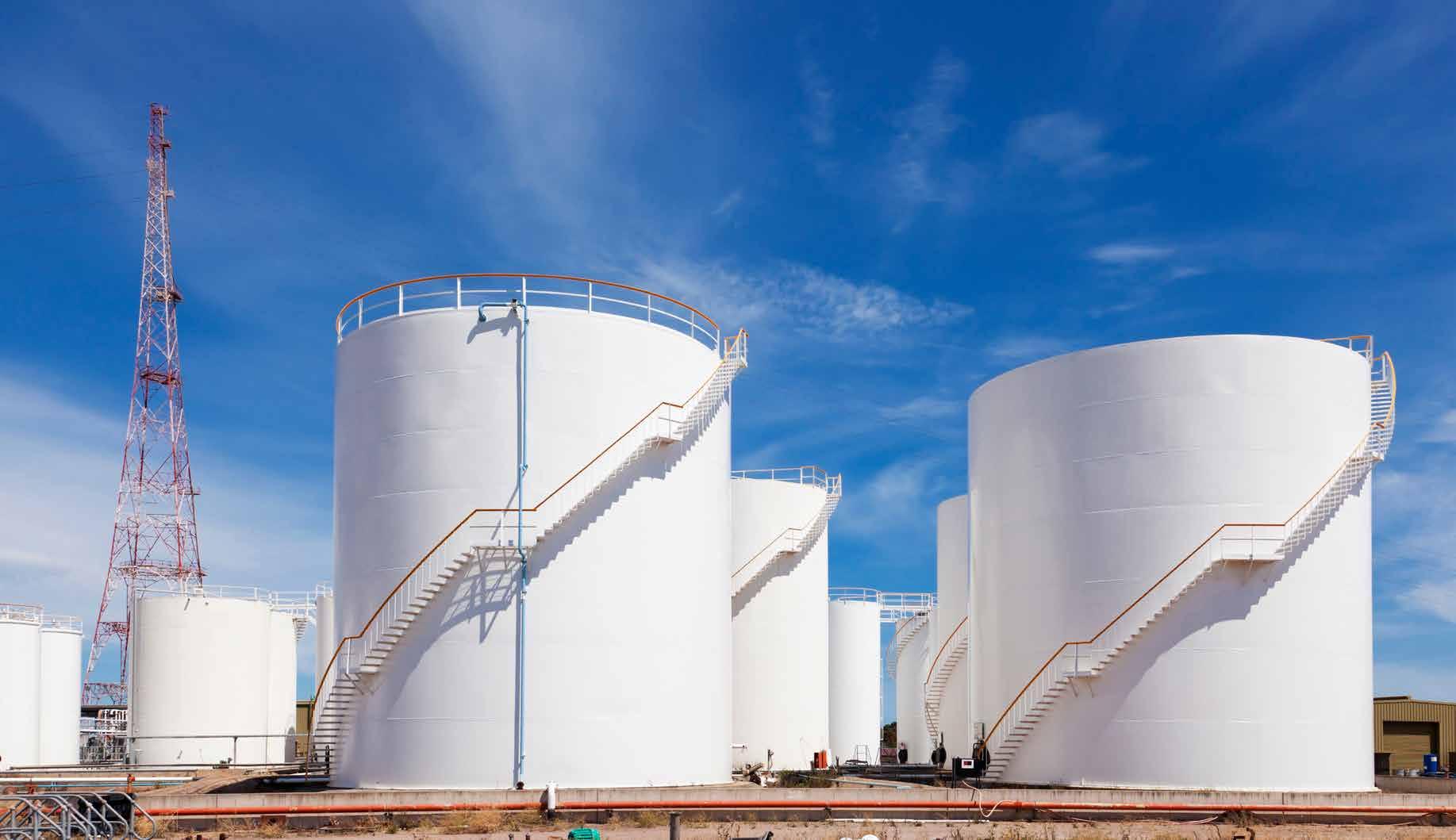
Headquarters:
Via Erasmo Piaggio, 62 - 66100 Chieti Scalo Italy
Tel +39.0871.5801 Fax +39.0871.564101

Workshops:
Via E. Piaggio, Chieti Scalo (CH) – Italy
Via Cervana, Ortona Port (CH) – Italy
SPHERES BULLETS STORAGE TANKS LOW TEMPERATURE CRYOGENIC TANKS
& SINCE 1947
www.waltertosto.it www.maraldi.it
O U R E X P E R T I S E F O R Y O U R P R O J E C T S
FOLLOWING DREAMS; MAKING CHOICES
Tank Storage Magazine sits down with Agnes Kiss, sales representative at Walter Tosto to discuss what route led her to tank storage
AGNES KISS, sales representative at Walter Tosto, strongly believes that every persons’ life follows the ways set by their background, their dreams and their choices.
Kiss was born in a well-known industrial city in Romania. During her childhood, at least one member of her family was working in one of the huge factories employing more than 10,000 people. All the industrial equipment that was manufactured there was bound for the European market.
She grew up among miscellaneous machinery, spending her holidays with her parents in their production workshop. Kiss’ father was ‘a small entrepreneur’ and ran his own production unit for multiple-use steel tanks and a moulding workshop for car batteries. Most of the tools and devices necessary in the process were self-made. While she didn’t know it at the time, this would be the starting point of Kiss’ journey into tank storage.
‘My father was definitely a visionary. We all still keep his memory alive. He was fascinated by the power of hydrogen, the fuel of the future. In this respect, he
was a visionary. He had been working on turning the propulsion of a petrol engine car into a hydrogen fuel engine,’ comments Kiss.
ENTERING THE INDUSTRY
Right after celebrating her 18th birthday, Kiss ended up in Bucharest, where she was hired by the country’s first private airline corporation. ‘I was thrilled to discover the joy of travelling, flying and also supporting myself while saving money for my studies,’ says Kiss. Kiss had a thirst for knowledge, which involved discovering news about interesting topics. And during that period, the news also found her. ‘For two years, I enjoyed being the anchor lady for the news broadcast at a very popular TV channel (Antena 1) in Bucharest. By then, I met many remarkable people, found out how powerful information can be and what a tremendous impact mass media can have at global level.’
Progressing through her career, Kiss discovered that professional communication has no gender. ‘I do believe that I have been valued for my
strong motivation, hard-working attitude and ambition, regardless of my gender or background. I have always found common ground within my professional environment and I have been fortunate to meet people who embraced the unique potential in every person,’ Kiss says.
In 2000, Kiss made a huge change. She relocated to the Netherlands and everything in her life and career turned to a different path.
The Dutch company she worked for specialised in building high standard and innovative river ships. While mastering this field for several generations, the family business was so dedicated to its legacy that the producers, customers and coworkers, became lifetime friends and collaborators of Kiss.
Living in the Netherlands gave Kiss endless admiration for the innovative power and overall professionalism in the country’s industrial sector. ‘In my opinion, the Dutch ship builders, engineers and related professionals are undoubtedly the ultimate trendsetters in their field, just as the world has long acknowledged them already,’ says Kiss.
WORKING AT WALTER TOSTO
In 2019, Kiss started working with Walter Tosto on a new challenge –equipment production. Initially, she worked in the floating division on ship tank manufacture. She later took on the entire range of products, developing the business portfolio and signing on new customers in the BeNeLux region (Belgium, the Netherlands, and Luxembourg).
‘I found myself very committed to my new professional objectives and I could understand why I attuned so intensely with the company vision,’ says Kiss. The Tosto Group has become a global leader in producing some of the most complex industrial equipment. Established in 1960, the Tosto Group is now one of the major manufacturers of the highest-standards tanks, critical items, heavy wall static and heat transfer equipment for oil and gas, petrochemical, nuclear power and energy markets. Tosto Group’s

PAGE 34
01 WOMEN IN TANKS AGNES KISS
engineers carefully monitor each item, manufactured in-house, including some of the tools and equipment used in its production factories.
Kiss says: ‘I genuinely feel honoured to be a part of this company and, in this respect, to be a part of the worldwide awakening and awareness in fighting global climate change to make a better world for our fellowship, our society, our children, our future.’
ADVICE TO WOMEN
Working in tank storage, Kiss has had the chance and privilege to meet, work with and befriend many professional women. Each and every of them proved very skilled in performing extremely fine and highly technical tasks that were essential for the final product. According to Kiss, their remarkable attention to detail and perfectionism is boosted by their aesthetic sense, be they welders, painters, engineers, architects, quality controllers or any related positions.
Kiss says: ‘My personal conviction is that women can bring more BB [beauty and balance] in a male-dominated world. Decision-making and communication in general can be optimised by more empathy and peace of mind in such a competitive field.’
THE FUTURE OF TANK STORAGE
Every individual who works within the tank storage sector sees its future differently. Kiss wants to play an active role in facilitating revolutionary new solutions that comply with the changing rules and regulations in regards to climate change. She believes this turning point of human history, through the energy transition, brings unprecedented business opportunities.
‘In the next 20 years, I expect that the industry as a whole will be shaped by several key trends. Automation and artificial intelligence will continue to revolutionise many industries, including manufacturing, transportation, healthcare, and finance. We will see more and more routine tasks being automated, which will free up workers to focus on more complex and creative work,’ says Kiss.
The drive for sustainability and reducing carbon footprint will continue to increase. Kiss believes this will lead to more companies adopting sustainable practices and technologies, such as waste prevention, renewable energy sources, sustainable packaging and circular economy principles.
While years ago LNG was considered a ‘green fuel’ aiming to replace the traditional ones, nowadays it’s widely accepted that LNG is a transition fuel. New fuels like hydrogen, methanol and ammonia are likely to take over in the transport sector. Kiss says: ‘We are in a transition. We experience very fast developments in the fuel sector and this requires new infrastructures.’
For more information:
www.waltertosto.it
email: anamika@tankstoragemag.com SHARE YOUR STORY Join the Women in Tanks community and inspire other women to join this exciting industry at the forefront of the energy transition. ARE YOU A WOMAN IN TANK STORAGE? Do you have a story to tell? Established 2005. Trusted. Valued. Influential. PAGE 35
01 Agnes Kiss accepts a stand award on behalf of Walter Tosto at StocExpo 2023. Presented by Margaret Dunn, portfolio director
WOMEN IN TANKS AGNES KISS
‘My personal conviction is that women can bring more BB [beauty and balance] in a maledominated world.’
PROACTIVE, COMPETITIVE AND ALWAYS ON THE GO
‘WE ARE an independent storage company for bulk liquid products, focused on the marketing, renting in and renting out storage capacity at bulk liquid terminals,’ says Ulf Vleeshouwers founder, chairman and CEO of V-Tank Storage SA. With more than 52 years of experience in the bulk liquid storage sector, Vleeshouwers has been a vital part of the industry for decades. ‘After having worked for Paktank, Van Ommeren (now Vopak), Nordic Tank Storage, Nordic Storage and InterTank, I had the idea to start the world-wide company – V-Tank Storage SA,’ he says.

GLOBAL SITES
Globally, V-Tank Storage SA is operational in eight major geographical locations, with a total storage capacity of around 4 million m 3, involving more than 250 tanks.‘The locations in Asia, the United Arab Emirates and in the Caribbean were chosen because of the great relationships I have with people managing those locations. And together, we have built these to become prime hubs for bulk liquid storage movements,’ explains Vleeshouwers.
Locations such as the Nordics and Baltics have been prime spots for business in companies Vleeshouwers managed before, so it made sense to continue here. However, due to the European oil embargo on Russia, these are not yet fully operational. ‘The terminals at the other locations are running at full speed and are handling all kind of existing petroleum products from naphtha to heavy fuel oil and chemicals. These are coming in by vessels and going out by other vessels, road and rail,’ says Vleeshouwers.
The facilities in the Caribbean, the Baltics, the Nordics, UK and Europe mainly store petroleum products, while in Asia and in the UAE, V-Tank’s terminals mainly store chemical products. Aside from that, Vleeshouwers says there is not much difference between the various locations. ‘All professional terminals work very much the same way, all around the world. All the same rules are valid. The only difference is the management and employees in those countries because of varying cultures and religions but
at V-Tank Storage SA, we have trust in each other that everything runs smoothly,’ explains Vleeshouwers.
FUTURE OF V-TANK
Over the next five years, Vleeshouwers plans on expanding the business. ‘The plan is to be able to offer a total of 30 terminals worldwide and increase our total capacity to 10 million m3.’ V-Tank Storage SA wants to be able to handle all existing bulk liquid products.

V-Tank Storage SA is taking significant steps towards going green, reinvesting 30% of the company’s profit into sustainable energy solutions like solar, wind, water and the storage of renewable energy. Vleeshouwers and V-Tank Storage SA will follow the rest of the globe by independently assessing the sustainability efforts of both its own terminals and those it represents.
‘We try to be proactive, competitive and always on the go,’ says Vleeshouwers. The future for V-Tank Storage SA is bright and it plans to be a worldwide storage provider which the market can trust. The company’s management employees have a total of more than 200 years’ experience, providing them with the skills and expertise required for a successful tank terminal business.
For more information: www.v-tank-storage.com
PAGE 36
Tank Storage Magazine speaks to this edition’s front cover sponsor, V-Tank Storage SA, about its global sites 02 01
PROFILE V-TANK STORAGE SA
01 Ulf Vleeshouwers, founder, chairman and CEO of V-Tank Storage SA 02 V-Tank Terminals SA in the Seychelles
EXCLUSIVE ONLINE CONTENT, JUST FOR YOU
A sneak peek of some of the high quality, exclusive, members-only editorials that you can find online
AN EXPERT’S GUIDE TO CCUS
Mhairidh Evans, research director at Wood Mackenzie provides insight and strategic analysis on the CCUS landscape
‘CCUS PROJECTS aim to either capture and/or store CO2 that comes from the most emissions-intensive parts of our economies. For industries like chemicals, cement and steel production, there are few technically-feasible options to reduce emissions at scale today – and CCUS is one of them,’ explains Mhairidh Evans at Wood Mackenzie.
Wood Mackenzie believes that 2023 will be a milestone year for carbon capture and storage with the technology finally moving from a smaller concept to mainstream investment theme. ‘To keep within the limits of the Paris Agreement, we forecast that CCUS capacity needs to increase to around 15% of energy-related emissions by 2050,’ says Evans.
‘It is increasingly clear that CCUS has huge potential to help deliver a net zero future. In fact, under our accelerated energy transition (AET) -1.5 scenario – whereby global warming is kept below 1.5°C – CCUS accounts for at least 15% of the reduction in overall global carbon emissions,’ says Evans. Corporations and governments have put more emphasis on CCUS policy and investments since 2021, due to more ambitious net zero targets and are providing incentives for companies to do so...
Read more online:
https://tankstorage.com/feature/an-experts-guide-to-ccus/
GOLD FOR ENVIRONMENTAL PERFORMANCE
UNDERSTANDING THE environment and working with it are part of everyday operations for Circor. Its award-winning Houttin Energy Recovery Valve (ERVC) controls flow in an accurate, fast and stable way, without being influenced by fluid densities and pressures. It also recovers the hydraulic energy wasted by conventional control valves, producing electrical energy in the process. This kind of innovation was exactly what the judges of the Global Tank Storage Awards were looking for.
The ERVC from Houttuin combines modern variable-speed drive technology, control logic and a screw pump configured as a twinscrew-motor (TSM). ‘With this innovation, twin-screw technology can convert excess hydraulic energy into mechanical or electrical energy and save millions of tonnes of carbon,’ says Axel Jäschke, business development director twin-screw at Circor...
Read more online:
https://tankstorage.com/feature/gold-for-environmental-performance-circors-houttin-energy-recovery-valve/
IN CONVERSATION WITH… JAVIER BLANCO ORTEGA
Meet Mecanicas Bolea’s COO and director of operations, Javier Blanco Ortega – one of StocExpo 2023’s Forty Under 40
CAN YOU GIVE US A BRIEF OUTLINE OF YOUR CAREER TO DATE?
Javier: I am senior mechanical and chemical engineer, with a Masters in HSE and in Business and Administration. Since my first job in 2006 I have been working in contractor companies, developing different projects for industry. I have lived all over Europe and in 2008 I started to work in metallurgical areas, in several projects related to tank storage. I became the youngest board member area director at just 27 years old, and since then I’ve developed new divisions, departments and expanded the company in several fields. I am now the Chief Operation Officer and also Business Development Director for Mecanicas Bolea...
Read more online:
https://tankstorage.com/feature/in-conversation-with-javier-blanco-ortega/
PAGE 37 WHAT’S ONLINE EXCLUSIVE EDITORIALS
PRIORITISING SAFETY FOR CUSTOMERS AND EMPLOYEES
Having won gold in Safety Excellence at the Global Tank Storage Awards, Odfjell Terminals Korea shares insights into establishing an accident-free workplace
ODFJELL TERMINALS
KOREA
(OTK) was established as a subsidiary of Korea Petrochemical Company as part of a joint venture with Odfjell SE (Norway). Odfjell SE has over five decades of experience in tank terminal operations, currently owning three additional terminals at strategic locations in the US (Houston and Charleston) and Belgium (Antwerp). Since OTK’s initial completion in 2002, three expansions were built in 2008, 2009 and 2011.
OTK is positioned as a competitive terminal in Korea, attracting various customers from both domestic and overseas regions. The terminal is located in the Port of Ulsan, which serves as the main hub for northeast Asia. As Asia’s newest terminal, OTK boasts modern facilities for the storage and distribution of petrochemicals, acting as a distribution hub for China, Taiwan, Japan and Korea. On top of OTK’s extensive terminal infrastructure – including 85 tanks with 313,710 m3 capacity, six berths with water depths of 9-14 m and 17 tank truck and Iso-container loading bays – the company prides itself on an impressive safety
record. ‘Since starting our business in 2002, there has never been a fatality and we have had no LTI accident for seven years,’ says Gill YongChan, QHSE manager for Odfjell Terminals Korea. ‘This is possible because of our employees’ attitudes and awareness of safety, through the continuous development of various safety activities in collaboration with our parent company Odfjell SE, including education and training.’
ESTABLISHING A CULTURE OF SAFETY
The latest news from OTK is the facility’s gold win at the Global Tank Storage Awards in March 2023. ‘As part of a global network of Odfjell terminals, we set safety as our top priority and operate our terminal business by applying high quality safety and environmental standards,’ says YongChan. This commitment to safety was rewarded at the glitzy awards gala, when OTK took home the gold trophy for Safety Excellence.
‘Being recognised for our safety performance means a lot to OTK and Odfjell’s global operations,’ explains YongChan. ‘For our customers, it plays
‘As part of a global network of Odfjell terminals, we set safety as our top priority and operate our terminal business by applying high quality, safety and environmental standards.’
a role in giving confidence and trust in Odfjell’s safety management. For our employees, it is a validation of the effort and time we have invested to improve safety management, and an opportunity to keep motivating our team to proceed at an even higher level of safety management.’
Since its establishment in 2001, Odfjell Terminals Korea has adhered to the core value of parent company Odfjell SE by making safety a top priority. ‘Safety is a core value of our business, and we have achieved a range of safety targets accordingly,’ says YongChan. ‘We applied to the Tank Storage Awards to see if these achievements could be recognised and

PAGE 38
01
PROFILE ODFJELL TERMINALS KOREA
evaluated on the global stage. We are very proud to have won gold.’
OTK’s safety management system comprehensively reflects its parent company’s standards, legal requirements, ISO, and CDI-T requirements. ‘We carry out safety activities such as SOR, near-miss, management team inspection, and work permits for field safety management. We also provide various education and training programmes, celebrate global safety day and run safety campaigns to raise safety awareness. Lastly, we operate safety programmes such as management of change, risk assessment, image training, and inspection before operation for preventive safety management.’
CONTINUOUSLY EVALUATING SAFETY
The tank storage sector is on the brink of a transition, and that means safety processes need to be continuously evaluated and updated. A practice that was seen as perfectly usual and safe five or ten years ago may no longer be the industry standard.
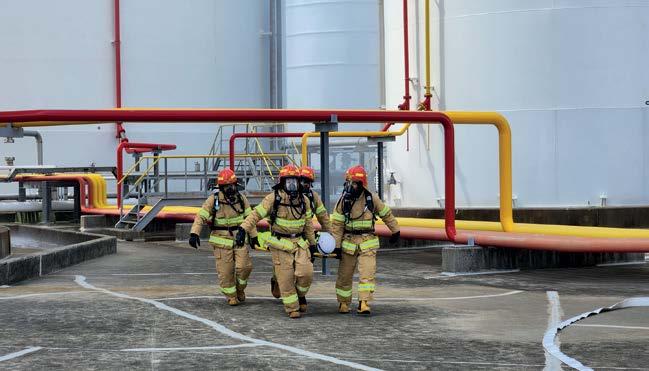
‘Our terminal has the advantage of being able to access a global network. We play a pivotal role in liquid cargo trade around the world, in collaboration with our parent company Odfjell, which is a world-class shipping company,’ says YongChan.

While it’s crucial to keep an eye on changing international standards, terminals must also assess their own practices to ensure they’ve established a culture of safety amongst workers, too. ‘We evaluate all safety education and training we conduct and manage individual safety record cards.’
In terms of facilities, OTK has established an annual inspection plan where any required maintenance work can be carried out. These records are managed and monitored. Any unsafe behaviours or conditions are inspected periodically. ‘In addition, our safety management level is continuously evaluated, confirmed,
and managed through ISO, CDI-T, PSM (Process Safety Management) audits, internal and corporate audits. Improvement measures are implemented as needed,’ says YongChan.
ENSURING A SAFE FUTURE
Winning the gold Safety Excellence award has been a fantastic way for OTK to be recognised on the global stage as a leader in safe practices. Looking to the future, YongChan lays out the role that safety has to play: ‘OTK will pursue continuous growth and development internally and externally to stay competitive. There is no change in the principle that safety must be guaranteed for such growth, so we will continue pursuing safety as a key factor in our business.’
With its record for no fatalities since opening and no LTI accidents in seven years, safety continues to be a top priority. ‘The most important thing is to keep our company as an accident-free workplace,’ says YongChan. ‘The risk assessment review, various inspections, SOR, near-miss, and daily image training will be continuously carried out to find
potential risks and ensure safe operation. On top of this, field safety management, MOC and safe work permits will also be thoroughly implemented to prevent accidents proactively.’
And when it comes to the future, the challenges of attracting new talent is one that OTK is tackling through enhancing safety measure. ‘We aim to make Odfjell Terminals Korea an even more attractive workplace by continuously seeking opportunities and methods that enhance safety awareness and culture,’ says YongChan.
For more information:
www.odfjell.com/terminals/ulsan-korea
01 Aerial view of Odfjell Terminals Korea
02 The OTK team marks Global Safety Day with extra training

03 The OTK team accepts the Global Tank Storage Award for Safety Excellence at the 2023 event
04 The OTK team doing an emergency drill
PAGE 39
04 02
03 PROFILE ODFJELL TERMINALS KOREA
OPERATING IN THE MIDDLE EAST
Star Energy Advario CEO and VP of Advario Middle East, Andrew Drayton, tells Tank Storage Magazine about the Dubai terminal
‘STAR
ENERGY ADVARIO (SEAD)
is a 50/50 joint venture between the Star Energy Group and Advario, an independent storage provider based in the Netherlands, operating 13 terminals worldwide,’ says Andrew Drayton, CEO SEAD; VP Advario Middle East. From here, SEAD serves as a hub for breakbulk, trans-shipments, blending and distribution across the Middle East, the Indian subcontinent, Asia Pacific and East Africa. He explains: ‘The Jebel Ali Free Zone grants us tax-efficient storage of products, which means we can offer highly competitive and streamlined services for our international and local partners.’
The Star Energy Group was first established in Abu Dhabi in 1986. Three years later, the group commissioned a petroleum storage terminal situated in Jebel Ali, Dubai, UAE; the world’s largest man-made harbor, with a 325,000 m3 capacity. 16 years after the expansion, Star Energy Group entered into a joint venture with German independent logistics services provider, Oiltanking GmbH. The terminal continued to thrive under the name Star Energy Oiltanking (SEOT), before rebranding to Star Energy Advario (SEAD) in 2022.
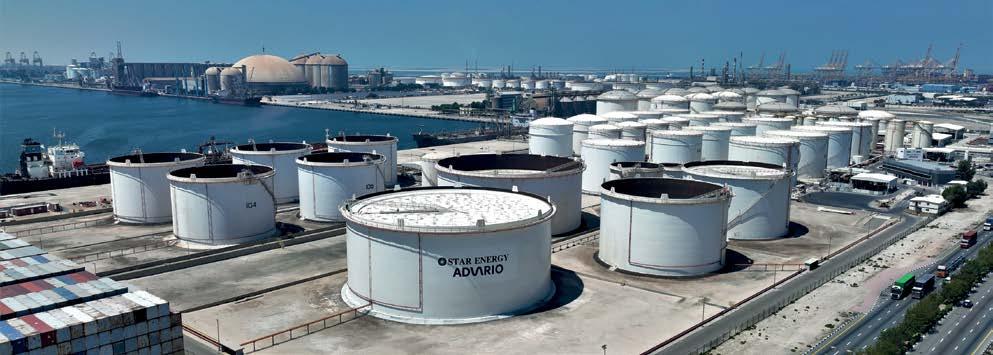
TERMINAL ACTIVITIES
SEAD provides vital midstream energy logistic services for end users, including vessel and truck loading, discharging,
direct ship-to-ship operations, additive injections and inter-terminal pipeline transfers, as well as tank circulation, blending and cleaning. ‘We store clean petroleum products including kerosene, gasoline and its components, jet fuel, condensate, gas, oil, petrochemicals, naphtha and diesel,’ says Drayton. This is in line with Advario’s vision to be a partner for progress in the energy transition as well as storing renewables, including biodiesel and thermal fluid oil.
‘Today, the Star Energy Advario terminal operates 43 tanks with 950,000 m3 storage capacity, making it the largest independent petrochemical storage terminal in the Jebel Ali port and a leading entity in the oil and gas sector in the Middle East,’ says Drayton.
The Dubai site includes eight truckloading bays and three berths for efficient vessel turnaround, as well as high-speed pumps and short, piggable pipelines. This flexible infrastructure makes the plant a popular choice for blending clean products with safe, efficient and costeffective operations, resulting in many accolades from the UAE government.
SEAD is currently assessing an expansion of approximately 85,000 m3 .‘These storage tanks are smaller than our existing ones, adding flexibility to our infrastructure and enabling quicker, easier internal transfers. This will add value by enabling us to react more quickly to market conditions for our partners,’
says Drayton. SEAD expects these tanks to be operational by the end of 2025. In terms of new products, alongside the growing demand for thermal oil and biodiesel, Drayton says that SEAD is seeing more inquiries for used cooking oil. It is currently investigating the infrastructure needed to safely and efficiently store it on-site.
PARTNERS IN THE MARKET
Both Advario Oman and Star Energy Advario are active in the gasoline blending market, as their partners at each site serve similar markets. The main operational difference is in the size and pipeline connections. ‘Our terminal in Oman is the only storage provider in the Sohar port, and the largest in the entire country, with extensive pipeline connections to local production and manufacturing facilities. However, in Jebel Ali there are few production facilities, and as such there are only third-party pipeline links into the refinery infrastructure,’ explains Drayton.
Alignment across both sites is important. In both Sohar and Dubai, the terminals are committed to upholding Advario’s values of respect, responsibility, integrity and accountability. SEAD has various measures in place to facilitate connection and collaboration between teams. ‘For example, we have introduced knowledgesharing practices between corresponding
PAGE 40
01 PROFILE STAR ENERGY ADVARIO
departments to enable colleagues to learn from one another and to ensure we always uphold best practices,’ says Drayton. For SEAD, nothing is this more important than health and safety. ‘I’m proud to say that at SEAD, we’re approaching 3,000 days without a lost time incident (LTI) – in fact, the terminal is a consecutive winner of the internationally recognised RoSPA Gold Award for outstanding safety performance,’ boasts Drayton.
STANDING OUT IN A COMPETITIVE REGION
Drayton says one of the main challenges in the Middle East is competition. There are other major players operating within close proximity to its terminals, all actively pursuing similar opportunities. But Advario has always risen to that challenge.‘When other terminals have suffered capacity issues, we have managed to keep our occupancy very high by innovating and offering unique services based on our customers’ needs, creating strong loyalty from our partners,’ he says.
Internally, Advario prioritises maintaining a deep respect for the diverse mix of cultures across its sites. At Advario Oman and SEAD, the group has people of many different nationalities all working together. Drayton believes that an inclusive environment, which facilitates respectful, effective communication and collaboration, is fundamental to the company’s success.
Relationship-building is crucial to remain a leading liquid storage logistics partner in a highly competitive market. ‘We have worked hard in recent years to strengthen our relationships with port authorities, JV partners, regulators and national oil companies,’ says Drayton.
This allows SEAD to better understand other business’ processes, which can, in turn, better understand SEAD’s business approach. This brings a greater degree of mutual compromise and flexibility.
‘We also empower our people – after all, local colleagues are best placed to advise on local issues. Healthy dialogue ensures our colleagues can provide open and direct feedback to help guide our stakeholder management,’ explains Drayton.
KEEPING A FINGER ON THE PULSE
Operational excellence, commercial excellence and digitalisation are common buzzwords in the industry, but SEAD (and Advario in general) is genuinely embracing these concepts. It is using them to inspire innovation and gradually implementing new processes and tools to facilitate continuous improvement in these areas.
This helps SEAD identify safer, more efficient and more sustainable ways of doing business. Above all, it encourages colleagues to grow, to be inventive and contribute within teams, while remaining focused on the businesses partners’ needs as well as on results. ‘We regularly present at industry conferences to share ideas and stay abreast of external developments. We also have a focus on developing proprietary technologies, better customer service, keeping our people safe and accelerating our ambitious growth strategies,’ says Drayton.
Drayton strongly believes the Middle East will maintain its status as a key global energy supply hub while transitioning into alternative and green energies. ‘We are already involved in discussions with stakeholders across the region about how we can best support their energy strategies for the long term. In
line with Advario’s vision, we will support our partners’ transformation from a fossil-fueled energy market to a more sustainable market that protects people and our planet,’ says Drayton.
STAYING SUSTAINABLE
Advario has a strong ambition to achieve net zero by 2040. Energy consumption and emissions, such as volatile organic compounds (VOCs) and greenhouse gases (GHGs), are monitored at all Advario terminals. ‘Our shared objective is to continue to drive positive impact in our communities while adding value for employees, customers, shareholders and society at large,’ says Drayton.
SEAD’s initial focus is the reduction of scope 1 and 2 GHG emissions that arise from its operations. The business will implement some key changes such as installing solar panels, sourcing electricity from carbon-free sources, replacing site transport with electric carts and switching to LED lighting. By putting plans in place now, SEAD is confident that it can achieve its 2040 target.
SEAD also has robust sustainability measures in place to minimise any negative impact on people or the environment from its operations, including ISO certification for quality and environmental management, and occupational health and safety. It disposes of its segregated waste through approved licensed contractors and conducts regular environmental impact assessments to identify areas for further improvement.
‘We know that enabling the energy transition is a marathon, not a sprint. But Advario’s future is bright. With decades of experience, a future-focused, holistic approach and a truly ambitious sustainability agenda, we are confident that we can realise our vision to be the preferred partner for progress in the storage infrastructure industry,’ says Drayton.
For more information
www.starenergyadvario.com

PAGE 41
02
PROFILE STAR ENERGY ADVARIO
01 Star Energy Advario tank terminal, Dubai 02 Andrew Drayton, CEO Star Energy Advario and vice president Advario Middle East.
EXPANDING TERMINALS TO SUPPLY FUTURE FUELS
VOPAK VLAARDINGEN is a terminal in the Port of Rotterdam, the Netherlands, that’s keeping up with the times. Today, the terminal uses drones for its inspections and with its new tanks, the terminal has an important role in the rising demand for energy from renewable sources in Europe. The regular refurbishments of old infrastructure in combination with the passion and mentality of the colleagues at Vopak Vlaardingen, have kept the terminal young.
HUB LOCATION
Vopak Vlaardingen is a large-scale independent terminal with deep sea access in the Port of Rotterdam, the Netherlands. There are 310 tanks with a total capacity of over 600,000 m³, specialised in storing vegetable oils and fats, oleochemicals, biodiesel and base oils. The terminal offers solutions to suit a wide range of tank sizes in both mild steel and stainless steel, serving various transport modalities.
‘The terminal also has the perfect hub location for customers that are trading, distributing and producing across Europe and the rest of the world,’ says Alexander Fokker, managing director for Vopak Vlaardingen and Vlissingen. Situated in the heart of the industrial cluster, the Rotterdam terminal has a long-term commercial agreement with Shell to store the feedstocks for Shell Netherlands’ new biorefinery.
TANK REFURBISHMENTS & TERMINAL EXPANSION
Most of the existing tanks at the terminal have been demolished. Two of the old tanks were converted into rainwater buffer tanks in case of an increase in heavy rainfall. The new tank pit was built in the centre of the terminal. Old pump rooms and coupling stations have been demolished and pipe bridges serving other tank pits were re-located.
‘It was very demanding to keep operations running during the demolition and construction of the new infrastructure. The terminal successfully served existing customers during this period of time,’ says
Fokker. The project included 250,000 manhours without any major incidents occurring. The construction needed more than 600 foundation piles, 6,500 m³ of concrete, and over 2,500 tonnes of steel.
Fokker adds: ‘All work was executed by local contractors and with as much prefabrication as possible, avoiding excessive transport costs. All tanks are fully insulated (roof, wall and bottom) as well as the pipelines to avoid heat losses.’ In the future, condensate return lines will be installed for the production of steam, avoiding heat losses. The terminal also ordered an e-boiler providing ‘green’ steam. Fokker says: ‘It was a huge project to undertake and complete. But, the result will be worth it – as the new facility will contribute to making the energy sector more sustainable.’
With the recent expansion for storing waste-based feedstocks, the terminal is now equipped to handle an even larger array of clients. Waste can be used as a feedstock for fuels and chemicals, and this helps to create a circular economy. As such, non-recyclable organic portion of municipal solid waste, biosolids, sludges, plastics and food waste, are all examples of waste feedstocks.
The new facility will help Europe to meet internationally-binding emissions reduction targets. It will also help clients on site, such as Shell, to meet their own net-zero emissions targets. It is anticipated that the Shell facility will use technology to capture carbon emissions from the

manufacturing process and store them in an empty gas field beneath the North Sea through the Porthos project.
BUILDING A SUSTAINABLE FUTURE
‘This project is aligned with Vopak’s commitment to invest in infrastructure solutions for building a more sustainable future for its customers and society,’ says Fokker. Vopak has already announced it will accelerate its portfolio investments towards new energies and sustainable feedstocks by allocating €1 billion in growth capital to these activities by 2030. This is half of Vopak’s growth capital allocation till 2030.
Vopak’s focus is on infrastructure solutions for low-carbon and renewable hydrogen, ammonia, carbon, long duration energy storage and sustainable feedstocks. ‘This strategy will help shape the future of Vopak, but also contribute positively to the transition within key industrial clusters and the shaping of energy hubs of the future,’ continues Fokker.
For more information:
www.vopak.com
PAGE 43
01
Alexander Fokker, managing director at Vopak, explains the development of its sustainable feedstock storage in Rotterdam
PROFILE VOPAK VLAARDINGEN
01 From left to right: Alexander Fokker, Michiel Gilsing, Bert Wijbenga, Jacek Dziembaj & Pauline Buitink and receiving the first biofeedstock delivery at Vopak Vlaardingen
IN TRANSITION: ENERGY SECURITY & DIGITALISATION
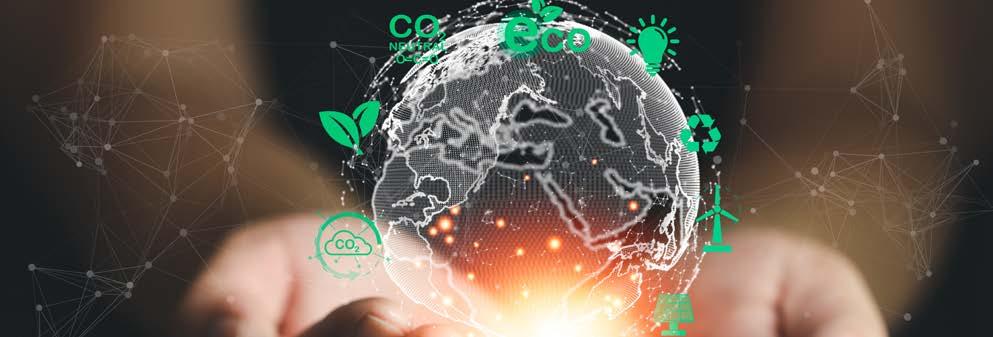
IT IS a time of multiple transitions.
The energy transition continues to be a top priority and FETSA has been working across multiple files related to taxation, incentivisation of hydrogen take up, the future of e-fuels and reduction of carbon and other vehicle emissions. Meanwhile, the EU is designing a new legal framework to ensure 55% GHG reduction from 90s levels by 2030; climate neutrality for 2050.
GEOPOLITICAL TRANSITION
The EU, and the globe in general, is also in the process of a geopolitical transition to a multi-polar, or tri-polar world. There are three major jurisdictions influencing global developments and mulit-lateral institutions (the USA, China and Russia). The EU wishes to become a fourth pole in international relations, but this is a huge challenge given the lack of a state structure of the EU, which is mainly a political and trade union.
This high level transition has concrete policies at working level for FETSA and its members. There is a process of decoupling ongoing with Russia, China and the USA.
Russian de-coupling is focussed on trade, particularly in the energy sphere, and is led by numerous sanctions packages that FETSA has been reporting on and trying to interpret for its members.
Chinese decoupling is focussed on critical minerals and strategic products for the energy transition. It is resulting in new
mining and processing facilities in the EU and the stockpiling of strategic raw materials and finished products.
US decoupling is related to reducing dependencies on US strategic areas such as financial, communications, infrastructure. Taken together, this is shifting trade routes and will result in new areas of investment needed in Europe.
To try and understand how these shifts will impact the bulk liquid storage sector FETSA has commissioned the Hague Centre for Strategic Studies to carry out a report to identify the major geopolitical trends and their consequences on our sector. This is also leading to discussions on how to manage security of supply of current and future energy carriers in volatile times. The IEA and EU are reviewing strategic stockpiling rules in this context and FETSA is a critical voice.
There is also the issue of the transition from a low inflation to a high inflation environment. This increases costs of capital at a time when capital expenditure is needed to finance energy transitionrelated investments at a huge scale.
THE DIGITAL TRANSITION
The digital transformation is another important ongoing transition. The increased digitalisation of terminal operations has resulted in industry initiatives such as ‘Terminal of the Future’ to try and guide this process. It has impacts on health, safety and operational
efficiency and is to be welcomed in a world of scarce human resources and an ageing workforce.
At the same time, this development will increase cyber risks, leading terminals to develop resilience plans, especially those focussed on cyber attack prevention and getting up and running again following a cyber incident.
WHAT NEXT?
2024 is a year of change in the EU. There will be a new European Parliament, a new college of European Commissioners and new political priorities. Whilst there is an expectation for all policies to link back to the transitions previously mentioned, FETSA cannot predict the content of those policies.
It would seem reasonable to expect changed climate targets to keep global temperature rises under control. It would also seem reasonable to expect further financing measures to finance energy transition-related investments. The current trajectory and adoptions of legislation to accelerate the energy transition and reduce emissions will also continue. This all adds up to a heavy work programme for FETSA with many issues for the sector to consider.
For more information: www.fetsa.eu
PAGE 44
MARKET ANALYSIS GEOPOLITICS
FETSA’s executive director Ravi Bhatiani discusses the links between geopolitics, future fuels and the digital transformation for the energy industry
ASIA’S OUTLOOK FOR LNG
President of Chevron Global Gas, Freeman Shaheen explains Chevron’s role in Asia’s LNG market
WORLDWIDE, natural gas resources are plentiful, and with partnership and investment, gas can play a significant role in helping nations achieve both energy security and environmental objectives.
When it comes to supply and demand, North America and Qatar will likely continue to lead the growth of LNG. Natural gas will play a key role in the long-term energy mix. For example, coal to gas switching, particularly in Asia, could help lower the carbon intensity of its energy. Gas can also help address intermittency gaps with renewable energy like wind and solar.

Gas markets tightened due to the release of pent-up demand coming out of the Covid-19 pandemic, immediately followed by Russia’s invasion of Ukraine, which materially disrupted gas supply to Europe by about 80%. Future demand may be impacted by factors such as what kind of winter Europe may have, to consumers being cautious and tightening their budgets from inflationary pressures or a recession.
COMPETING FOR LNG
Europe and Asia are competing for LNG supply amidst growing demand, Asia benefits from their comfort in entering long-term contracts which provide advantaged pricing and reliability of supply. Europe is showing a measure of increased comfort around medium-term contracting for LNG.
To accelerate the energy transition and scale innovative technologies at pace globally, a policy enabled environment is required. Achieving change at scale requires continued partnership and progress across the energy system in technology, policy, regulations, and offset markets. Coal-to-gas switching could play a significant role in reducing the carbon intensity of the world’s electricity generation.
Long-term, there is a likelihood that the developed world will move towards new energies such as hydrogen, wind, solar and other emerging technologies – while maintaining some level of natural gas supply to support grid reliability. Meanwhile, it is likely to see the developing world switch from coal and other more carbon intensive fuels to natural gas as a lower carbon alternative. This infers that the natural gas supply will remain strong.
ACCOMMODATING FOR DEMAND
Natural gas will play a vital role in meeting energy demand for years to come. The global population is expanding and so is access to electricity, both factors will drive increased demand for energy. This energy needs to be lower carbon, but renewables cannot support this demand alone.
The industry needs time to bring on new LNG facilities. In an ideal environment, it takes 18 months to four years to bring a facility online, following final investment decision. It is likely that price volatility will stick around until at least the middle of the decade as industry works to bring LNG facilities online to supply the European market and beyond.
Chevron’s position in the Eastern Mediterranean will play a significant role in supplying LNG to Europe. The region has abundant energy resources and is well positioned to meet growing regional and international demand. Development aligns with its strategy to safely deliver lower carbon energy to a growing world. Finding a way to develop those resources is driving strategic collaboration in the region among countries and investors. Chevron is currently exploring options including exports to Egypt which include Egyptian LNG facilities and FLNG.
Chevron is seeing tremendous growth in exports; the US is on track to become the world’s largest exporter of liquified
natural gas this year. Last year the company announced its agreements to offtake LNG from the US Gulf Coast, starting later this decade. These agreements are part of its growing global natural gas and LNG portfolio and enables Chevron to deliver necessary resource to demand centres in Europe and Asia.
OUTLOOK TO 2050
Each country will determine its own energy transition pathway. Countries throughout Asia should support pragmatic energy policies that recognise the critical role of natural gas and the need for reliable supplies of LNG and gas to the region for the foreseeable future. By 2050, Asia’s energy demand will more than double. Governments are increasingly challenged by the need to balance their energy needs with their environmental priorities. In practical terms, energy security means keeping the lights on with the availability of and public access to energy at affordable prices, while also trying to meet Paris Agreement emission reduction commitments.
As the world drives to lower CO 2 emissions, one thing is clear, gas drives progress. Oil and gas in the short, medium, and long term is important and each has a place in meeting the world’s growing energy demand, including the need and desire for lower carbon.
For more information:
Shaheen is looking forward to speaking at Gastech 2023. Gastech will bring together thought leaders from across the globe for a week of important discussion and collaboration to drive progress.
www.chevron.com
www.gastechevent.com
PAGE 45
MARKET ANALYSIS LNG IN ASIA
ENERGY SECURITY, TRANSITION & EMISSIONS
Andy Brooks, director of new ventures at the North Sea Transition Authority, explains the UK’s new licences for CCS

THE NORTH SEA Transition Authority (NSTA) is the independent regulator for the oil and gas and the carbon storage industry. It was previously the Oil and Gas Authority only, but has now moved into carbon capture and storage as an extension of its powers. The NSTA is the licensing and permitting authority for offshore carbon storage.
As an independent regulator, the NSTA’s remit is to look at energy security, emissions reductions and accelerating the transition. Last year, the NSTA ran the first ever carbon storage licensing round, issuing 21 licences for exploration of the seabed. Prior to this, there were six licences in existence. Once accepted, the NSTA will steward those licences, in much the same way as it does with oil and gas development, from exploration all the way through to the development of the transportation network and the storage.
WHAT’S INCLUDED IN THE LICENCES?
The NSTA effectively put up areas of seabed out for companies to bid on to analyse the ground conditions. Some of the licences issued build out from the original six. Others are new areas of potential exploration for carbon storage. The licenced companies will need to assess the area that’s licensed to them to determine if the site characterisation is suitable for carbon storage. The idea is for the carbon to be stored permanently under the seabed – that’s the main remit of the NSTA. Alongside transportation and storage, one of the main things that the NSTA has to do is ensure that there is no significant risk of leakage from the store before a permit is issued to allow an operator to go and store it.
There’s potential for 78 gigatons of CO 2 to be stored under the North Sea – that’s
more carbon than the UK has produced since the industrial revolution. The permanent storage will enable the UK to meet its net zero targets.
WHAT ROLE DO OIL AND GAS MAJORS HAVE?
While the new licences are still awaiting acceptance, the NSTA cannot reveal the names of the companies involved. However, there are some companies who have already announced that they have been offered license. Looking at the existing six licenses, it’s a mix of companies.
In traditional oil and gas, you would normally have an operator and then a set of joint ventures to carry out the development. So in carbon capture, you might have a mixture of super majors who are looking to diversify. Oil and gas majors have a wealth of knowledge and transferable skills on how to develop different subsurfaces, which can be transferred to carbon storage exploration. There are a lot of familiar oil and gas majors currently working on track one and track two projects. These companies have a lot of experience and expertise in such large development projects. It’s a different fluid, but it’s a transferable skill.
INCREASED INTEREST
There’s some pretty large government targets regarding carbon storage and emissions. The government wants to store 20-30 megatons of CO 2 by 2030, and that’s one of the main drivers for running a licensing round.
One: running the scheme has allowed the NSTA to see interest from the industry. Even from those existing licences, it’s evident that there was interest in more acreage to go and explore for CO 2 storage.
Two: it’s important to appraise and understand the subsurface to see whether the potential 78 gigatons of CO 2 storage capacity is actually real. It’s currently all theoretical – it won’t be confirmed until you go out and start drilling wells or reanalysing seismic data. To meet the government’s target of storing 30 megatons of CO 2 by 2030, the UK probably needs around 100 carbon stores – accounting also for site failures. Though, there can be multiple stores in each licence – that’s important to note.
Increasing from six licences to 21 is a huge step. For the NSTA, it’s a lot more work to steward and ensure that a company sticks to the plans that they’ve bid on and is held to account to deliver.
As the technology and exploration gets more mature, the industry will get a better idea of what the failure rate is like, and more projects can come off the taxi rank, as it were. It’s all about building out the industry and infrastructure to capture and clean up the CO 2, first by figuring out the capacity within the stores.
IS THERE REALLY POTENTIAL?
While there are no major projects in the UK that are currently up and running, the licences that have been granted are expected to progress with government support. There are some examples of current storage projects in Denmark and Australia, which effectively demonstrate how a depleted oil and gas reservoir can be used to store CO 2
So it can be done! The plan for the UK is to accelerate that appraisal and understand how it can be done right.
For more information:
www.nstauthority.co.uk
PAGE 46
MARKET ANALYSIS CARBON CAPTURE & STORAGE

TSA Tank Storage Associa on www.tankstorage.org.uk TANK STORAGE CONFERENCE & EXHIBITION 2023 21 September 2023 Coventry Building Society Arena, Coventry, UK Discover the event: www.tankstorage.org.uk/conference-exhibition 21.09.2023 The UK’s leading event for the bulk liquid storage sector
WHAT PATH LIES AHEAD FOR HYDROGEN?
Insights from Argus’ latest webinar on the progress across different areas of policy, demand and project advancement and the outlook for the hydrogen sector
ARGUS MEDIA RECENTLY held a webinar, hosted by Argus colleagues Aftab Siddiqui, senior product marketing manager, Tim Hard, SVP energy transition business development and editor Stefan Krümpelmann.
The webinar included discussions on national and regional laws and regulation, subsidising infrastructure and production, progress in key existing pillars, movement in new thematic industries, stirring in mobility and FIDs.
The speakers revealed some key information:
• Until 1 January 2030 renewable power produced or purchased via a power purchase agreement will have to match hydrogen production on a monthly basis; from 1 January 2030 onwards they will have to match this on an hourly basis
• 42% of all hydrogen or derivatives used in industry to come from renewables by 2030
• 60% of all hydrogen or derivatives used in industry to come from renewables by 2035
• 1.2% of all energy supplied to the maritime sector to be renewable hydrogen or derivatives in member states with maritime ports by 2030
• 35% of aviation fuel to be made up of SAF, including renewable hydrogen and e-kerosene by 2050
• 1% combined share for biofuels, biogas and renewable hydrogen and derivatives in fuels supplied to the transport sector by 2025
• 5.5% combined share for biofuels, biogas and renewable hydrogen and derivatives in fuels supplied to the transport sector by 2030 including a 1% share of hydrogen and derivatives in fuels supplied to the transport sector by 2030
DRIVING FORCES FROM NATION STATES
In addition to the new regulations, Argus unveiled that, as the European hydrogen bank takes shape, individual projects could bag up to €4/kg but will like get
much less given the competitive process. €800 million has been earmarked for an initial pilot auction, and €3 billion in the long run. Contracts are expected to be awarded in mid-2024.
EU countries are also creating their own launch tenders for opex subsidies. For example, in Denmark, individual projects could get up to €1.94/kg over ten years. Elsewhere, such as Australia, A$2 billion (€1.18 billion) will support 2-3 projects over 10 years from 2026-27.
Canada’s ITC could cut the cost of renewable hydrogen production by around 8%; additional support for associated ammonia production will be provided too. Blue hydrogen will be eligible for less support but rising carbon price will shift economics in any case. The future boasts many new potentials for the energy transition, including:
• Chile is working on financial incentives for project developers
• Individual Brazilian states developing supportive policies
• Morocco draws up incentives to entice developers
• The UK will award contracts for support of 250 MW green hydrogen products shortly; with another 750 MW round to follow
• South Korean government and companies are in talks about subsidy schemes
• Japan is developing contracts-fordifference scheme for hydrogen and ammonia based on gas and coal costs
THE DEMAND IS THERE
The US has set aside $1 billion (€0.92 billion) for demand-side incentives connected to hydrogen hubs, with the hubs decision expected in the next few months. In addition to this, individual states, such as Colorado and Illinois, have launched support mechanisms.
Germany is the frontrunner for demandside support and has set aside €50 billion for carbon-contracts-for-difference. This includes green and blue hydrogen, with current plans under consultation.
Tenders for 24 GW of hydrogen-ready power plant capacity are lined up. Several large state aid packages for industrial consumers to switch to hydrogen, especially in steel, have also been launched. Thyssesenkrupp recently implied a potential use of up to 143,000 tpa of green hydrogen from 2029.
THE FUTURE FOR HYDROGEN
Looking at power generation for the future, many countries are setting plans in place. In the US, the EPA has drafted decarbonisation rules, capping emissions from 300 MW+ power plants. Carbon emissions are to be reduced by 90% by 2040. There are also targets for GHG-free utilities by 2045, carbon neutrality by 2030 and offsets to be permissible to 2030, then phased out.
In Canada, the government has drafted rules for 2035 net zero. Germany has sketched out a hydrogen framework with tenders to be included by 2030. Japan is establishing a hydrogen bidding market, which is also being introduced in South Korea.
For mobility, in Europe a new law will be adopted by EU member states, whereby hydrogen refuelling stations must be in place by 2030 (every 200 km, and within 10 km of road exits). FuelEU Maritime Initiative will also implement a 2% GHG intensity reduction by 2025, escalating up to 80% at 2050.
There are still mobility restrictions in some areas and the action avalanche expected to take place after the introduction of the Inflation Reduction Act has not occurred. But the new parameters globally should help to make hydrogen more accessible and utilised more widely.
For more information:
www.argusmedia.com
PAGE 48 MARKET ANALYSIS HYDROGEN



57ᵗʰ Annual Meeting 25-28 September 2023 Vienna, Austria Collaboration for Impact #EPCA57 Plan to attend! www.epca57.eu

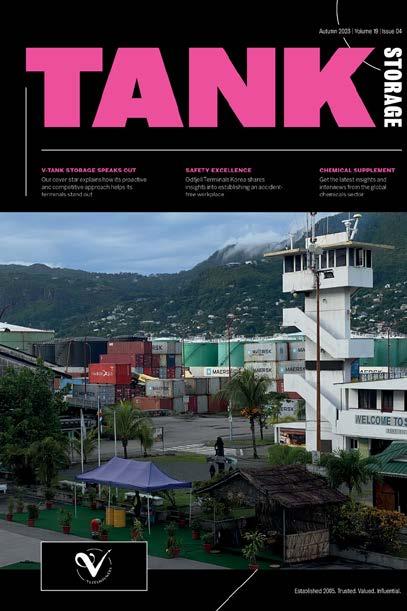




membership@tankstorage.com Established 2005.Trusted. Valued. Influential. JOIN NOW JOIN OUR COMMUNITY Unlock exclusive content with a Tank Storage Elite membership 5 print & digital magazines Exclusive articles , interviews & analysis Live & on-demand webinars Independent Tank Storage Wall Map Priority access to the StocExpo FETSA conference (worth € 625) And more! Scan the QR code to become a member. Elite membership just €299 for 12 months.
CHEMICAL STORAGE
STORING CHEMICALS & SUSTAINABLE EXPANSIONS
Standic’s CCO Paul Voogt speaks about the chemical terminal’s future plans
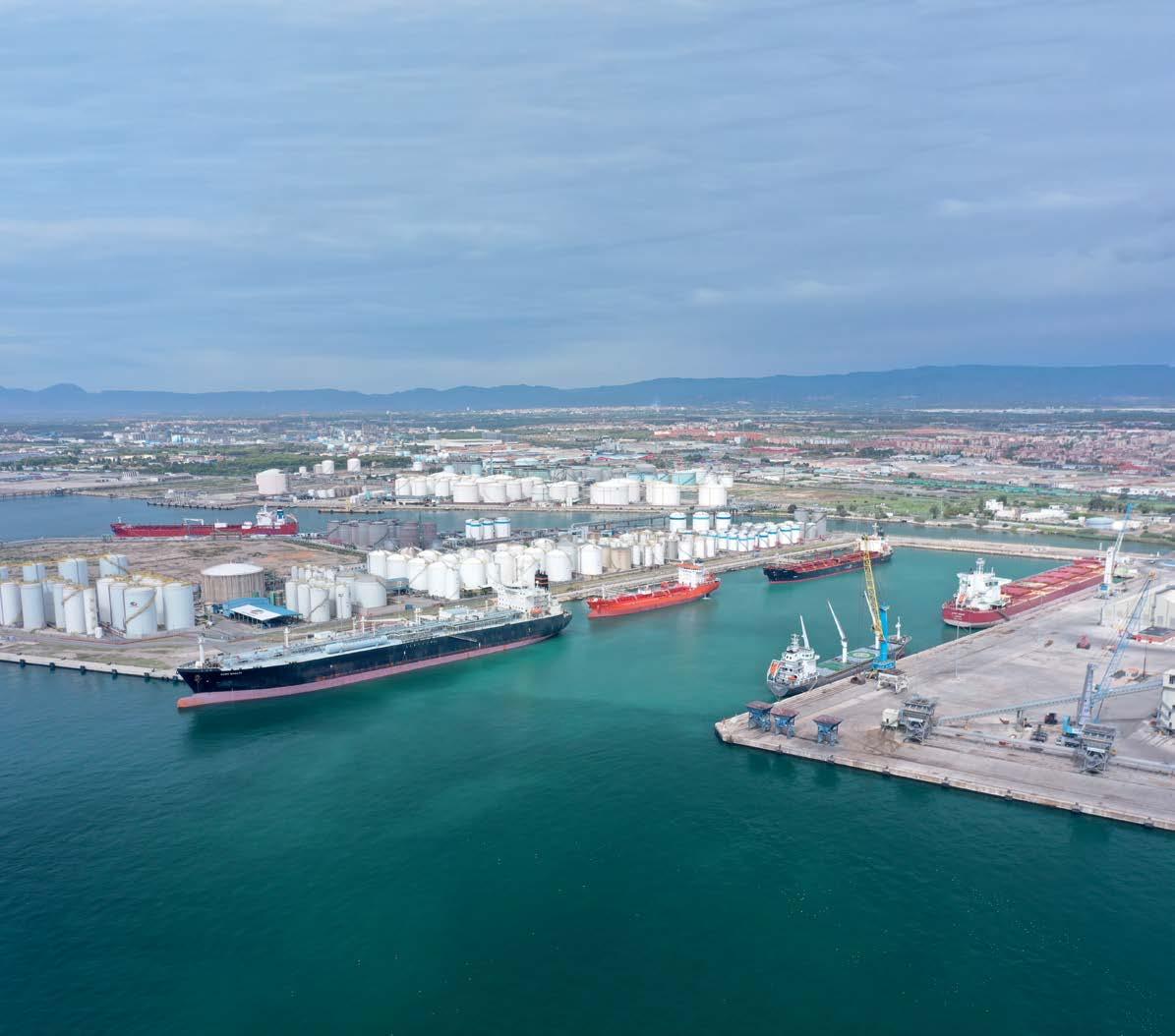
SINGAPORE’S HIGHLY AUTOMATED TERMINAL
The team at Stolthaven Singapore discuss the terminal’s recent Dow SEA S4TAR Award
SAFE & SUSTAINABLE SUPPLY CHAIN
The Chemical Business Association on how it’s championing the industry
XXXXXX XXXXXX PAGE 1
Autumn 2023 | Volume 19 SUPPLEMENT

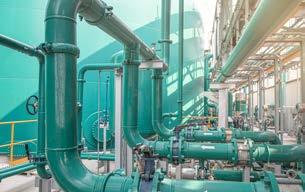


PAGE 02 CONTENTS EXCLUSIVE INTERVIEWS 08 06 12 14 06 Stolthaven Singapore: the new highly automated terminal in the industry Tank Storage Magazine talks to the team at Stolthaven Terminals Singapore about the development of its terminal and its Dow SEA S4TAR Award 08 Storing chemicals & sustainable expansions Molly Cooper speaks to Paul Voogt, CCO and commercial director at Standic about the chemical terminal’s activities and future expansions 14 Women can do chemistry, too Hande Cote, head of engineering at Johnson Matthey, discusses how being a woman in the chemicals industry isn’t the only factor that can put you on the back foot MARKET ANALYSIS 10 Championing a safe & sustainable chemical supply chain Tim Doggett, CEO at the Chemical Business Association, outlines the organisation’s efforts to help ensure a safe and sustainable chemical supply chain in the UK 12 Sustainable product solutions CespaQuÍmicadiscussesitsjourneytowardssustainableproductsolutionsandthe new reality in the chemicals market NEWS 03 News & Regulatory Updates CONTENTS Chemical Storage Supplement | Volume 19
VOPAK TERQUIMSA EXPANDS TARRAGONA TERMINAL
The Board of Directors of Vopak Terquimsa has approved the start of the engineering works for the development of the fourth phase of expansion of its capacity at the chemicals quay in the Port of Tarragona, Spain.
This fourth phase will involve the construction of an additional 37,000 m 3 dedicated to the storage of chemical products, often for circular economy projects and the energy transition. Construction is expected to begin throughout the year 2024, once the corresponding permits have been obtained. The facility is expected to be operational in the last quarter of 2026. With this new expansion, Vopak Terquimsa will have 483,901 m3 of capacity in Tarragona, adding a total of €72 million of direct investment in growth investments since 2017.

Eduardo Sañudo Sánchez, CEO of Vopak Terquimsa, explains: ‘Our commitment to Tarragona is definitive, as an enclave for the storage of chemicals in southern Europe, and consolidates us as the reference partner of the petrochemical industry in its decarbonisation process.’
The new extension will incorporate the latest technology in industrial automation to allow safer and more efficient operations to be carried out, all under the highest standards of environmental efficiency. The construction characteristics of the new capacity will allow high flexibility to meet the needs of customers.
GASUNIE APPOINTS NEW CEO
On the recommendation of the Supervisory Board and following the positive opinion of the Works Council, the Minister of Finance has appointed Willemien Terpstra as CEO and chair of the executive board of N.V. Nederlandse Gasunie. The appointment starts on 1 March 2024 and will be for a term of four years. Currently, Terpstra is currently global vice president for decarbonisation with international chemical company LyondellBasell, where she is responsible for the decarbonisation of the group’s operations worldwide.
‘We are very pleased with the arrival of Willemien Terpstra,’ says Gasunie Supervisory Board chair Pieter Duisenberg. ‘She is extremely motivated to further shape Gasunie’s social task of bringing about the energy transition. Her knowledge, experience and competencies make her perfectly suited to lead the strategic development of Gasunie and the implementation of our agenda for the future concerning hydrogen, heat, CO 2 and natural and green gas.
The Supervisory Board sees her as an enthusiastic successor to Han Fennema, to whom we owe tremendous gratitude. Under his expert, passionate, down-toearth leadership, Gasunie has developed from a gas TSO into a green energy infrastructure company. With this, Han has laid the foundation for the next chapter in Gasunie’s story.’ Terpstra will be succeeding Han Fennema, who announced his intention to step down earlier this year, after serving nearly 10 years as Gasunie’s CEO. Fennema will be stepping down as CEO on 1 November 2023. Gasunie CFO Janneke Hermes will act as interim chair of the executive board until Terpstra steps in as CEO.
BOREALIS COMPLETES STENUNGSUND CRACKER FURNACE REVAMP
Borealis has announced the successful completion of a major upgrade to its steam cracker operations in Stenungsund, Sweden. The seven-year construction project is a resounding success with respect to health, safety, and the environment (HSE), with no major accidents and no process safety incidents whatsoever.
‘Our very highest priority in the Stenungsund furnace revamp was to achieve a stellar safety record while carrying out a project of this huge size and scope, and we have delivered on this ambition,’ says Wolfram Krenn, Borealis executive vice president operations and base chemicals.
This capital investment ensures that the Stenungsund cracker – already one of the most feedstock-flexible in all of Europe – can operate even more reliably, and with greater energy efficiency. As a key supplier of ethylene and propylene to the Stenungsund Chemical Cluster, the OMV Group, and the Borealis Group’s international customers, its enhanced reliability is especially needed to support the rapidly growing wire and cable industry.
‘Our upgraded facility is moving us closer to realising our broader Energy & Climate goals: thanks to the overhaul, the yearly CO 2 emission reductions add up to approximately 24,000 tonnes which is the equivalent to the amount emitted on average by 6,000 European households each year. At Borealis, we are re-inventing the essential building blocks of plastics for more sustainable living,’ says Krenn.
CESPA ANNOUNCES IPA PLANT
Spanish multinational oil and gas company, Cespa has announced that Cepsa Quimica are going to build the world’s most competitive and environmentally-friendly plant for the production of isopropyl alcohol (IPA). This will provide Cespa with the capability to offer sustainable IPA to its customers from renewable or circular raw materials. IPA is used across a wide range of sectors including pharmaceutical, electronic, automotive industries and it is the fundamental component of hydroalcoholic gels, such as hand sanitiser.
The new plant will be powered with green hydrogen and renewable energy sources produced by Cepsa at the Andalusian Green Hydrogen Valley. And, when the plant is operational by 2025, production will be fully 100% CO 2 neutral.
On LinkedIn, José María Solana Deza, EVP Chemicals at CEPSA/CEO Cepsa Química says: ‘We are very excited to reinforce our leadership with the incorporation of this new product into our portfolio and into our new platform Next… My thanks go to our incredible teams in Cepsa and Cepsa Quimica for making this project a reality.’
PAGE 03 CHEMICAL SUPPLEMENT NEWS
Spain
Sweden
Spain Netherlands
INDIA TO REQUIRE IMPORT/EXPORT DECLARATIONS
From October 1, 2023, India will enforce mandatory declaration of IUPAC name and CAS number for the import and export of some chemicalrelated products.
The Indian Central Board of Indirect Taxes and Customs (CBIC) recently issued Circular No. 15/2023-Customs to mandate the submission of selected information for several chemical-related products. These would previously have been declared voluntarily.
Circular 15 requires additional qualifiers to both import and export declaration, as follows:
• For imports: Declaration of IUPAC name and CAS number of constituent chemicals when importing products of the chemical or allied industries specified in the Customs Tariff Act, 1975, including:
- Chapter 28: Inorganic chemicals, organic or inorganic compounds of precious metals, of rare-earth metals, of radioactive elements or of isotopes
- Chapter 29: Organic chemicals
- Chapter 32: Tanning or dyeing extracts; tannins and their derivatives; dyes, pigments and other colouring matter; paints and varnishes; putty and other mastics; inks
- Chapter 38: Miscellaneous chemical products
- Chapter 39: Plastics and articles thereof
• For exports: Declaration of various information includes:
- Medicinal plants under Chapter 12 – Oil seeds and oleaginous fruits, miscellaneous grains, seeds and fruit; industrial or medicinal plants; straw and fodder
- Formulation names of different streams of medicine under Chapter 30 – Pharmaceutical products
- Surface material that comes into contact with the chemical for exports of various products under Chapter 84 – Nuclear reactors, boilers, machinery and mechanical appliances; parts thereof
The mandatory declaration resulted from the consultations with various ministries to reduce queries and improve
efficiency. Chemical products can be associated with many common names or brand names, creating confusion for custom officers and delays in clearance, so using IUPAC names and CAS numbers, a unique identification to each chemical substance, is less confusing and gradually aligns to other global requirements.
EPA LOOKS TO CONTROL CTC
On July 28, 2023, the US Environmental Protection Agency (EPA) proposed a rule under Section 6(a) of the Toxic Substances Control Act (TSCA) which would address the unreasonable risk of injury to human health presented by carbon tetrachloride (CTC).
This proposed risk management rule is based on the EPA’s risk evaluation from November 2020, as amended by the December 2022 revised unreasonable risk determination for CTC.
The EPA has determined that CTC presents an unreasonable risk of injury to health to workers. Risks can include cancer and liver toxicity from chronic inhalation and chronic dermal exposure in the workplace.

The EPA is proposing the following:
• A CTC workplace chemical protection program that includes an existing chemical exposure limit (ECEL) of 0.3 ppm as an 8-hour time-weighted average (TWA);
• Use of a fume hood and dermal personal protective equipment (PPE) for the industrial and commercial use as a laboratory chemical;

• Prohibiting several uses of CTC that have already been phased out;
• Downstream notification requirements for manufacturers, importers, processors, and distributors; and
• Recordkeeping requirements.
PROPOSAL TO ADD NEW GHG CATEGORY
During the 44th session of the subcommittee of experts on the Globally Harmonized System of Classification and Labelling of Chemicals, Austria, the EU, Finland, Germany, and the UK proposed a revision to Chapter 4.2. The group suggested adding the new hazard category related to global warming listed in the annexes to the Montreal Protocol. If the proposal is approved, the new classifications would be Hazardous to the Atmospheric System, which denotes a substance as being hazardous to the ozone layer, and hazardous by contributing to global warming.
In accordance with INF.3, a substance or mixture shall be classified in Category 1 Hazardous to global warming according to the following:
• Is the substance listed with a global warming potential in annexes to the Montreal Protocol?
• Does the mixture contain ≥0.1 of at least one ingredient listed with a global warming potential in the annexes to the Montreal Protocol?
If the answer is yes to either of the above, the substance or mixture is classified as Category 1.
PAGE 04 CHEMICAL SUPPLEMENT REGULATORY UPDATES
USA Europe India
HAZARDS33HAZARDS33HAZARDS33HAZARDS33HAZARDS33HAZARDS33HAZARDS33
HAZARDS33HAZARDS33HAZARDS33HAZARDS33HAZARDS33HAZARDS33HAZARDS33
HAZARDS33HAZARDS33HAZARDS33HAZARDS33HAZARDS33HAZARDS33HAZARDS33
HAZARDS33HAZARDS33HAZARDS33HAZARDS33HAZARDS33HAZARDS33HAZARDS33
Hazards33
HAZARDS33HAZARDS33HAZARDS33HAZARDS33HAZARDS33HAZARDS33HAZARDS33
7–9 November 2023, Birmingham, UK
HAZARDS33HAZARDS33HAZARDS33HAZARDS33HAZARDS33HAZARDS33HAZARDS33
Join the major hazards community at Hazards 33 to review good practice, current thinking, lessons learned and emerging challenges in process safety and hazard management.
HAZARDS33HAZARDS33HAZARDS33HAZARDS33HAZARDS33HAZARDS33HAZARDS33
HAZARDS33HAZARDS33HAZARDS33HAZARDS33HAZARDS33HAZARDS33HAZARDS33
Hazards 33 is an industry-focused event ideal for anyone who is active in process safety and risk management for chemical process facilities or other facilities dealing with hazardous materials. It is an exciting chance to connect with fellow professionals, build networks and share insight and experiences in person.
HAZARDS33HAZARDS33HAZARDS33HAZARDS33HAZARDS33HAZARDS33HAZARDS33
Programme themes
HAZARDS33HAZARDS33HAZARDS33HAZARDS33HAZARDS33HAZARDS33HAZARDS33
Q Assurance
Q Hazardous Area Classification
Q New Energies
Q Competencies
Q Critical Task Analysis
Q Human Factors
Q Hydrogen Hazards
Q Non-routine Operations
HAZARDS33HAZARDS33HAZARDS33HAZARDS33HAZARDS33HAZARDS33HAZARDS33
Q Safety Critical Task Analysis
Q Cross-sector Learning (Nuclear)
Q Cross-sector Learning (Water)
Q Digitalisation
Q Hydrogen Experimental Results
Q Hydrogen Lessons Learned
Q Hydrogen Risk Assessment
Q Safety Culture
Q Safety Culture - Leadership
HAZARDS33HAZARDS33HAZARDS33HAZARDS33HAZARDS33HAZARDS33HAZARDS33
Q Engineering & Design
Q Environment & Climate Change
Q Learning from Incidents
Q Safety Culture - Operator’s Experience
HAZARDS33HAZARDS33HAZARDS33HAZARDS33HAZARDS33HAZARDS33HAZARDS33
Q Modelling & Simulation
HAZARDS33HAZARDS33HAZARDS33HAZARDS33HAZARDS33HAZARDS33HAZARDS33
Speakers
HAZARDS33HAZARDS33HAZARDS33HAZARDS33HAZARDS33HAZARDS33HAZARDS33
Amir Gerges

Professor
Rhona Flin

Dr Stuart Hawksworth
Shell
Trevor Kletz Hazards
HAZARDS33HAZARDS33HAZARDS33HAZARDS33HAZARDS33HAZARDS33HAZARDS33
Lecture
University of Aberdeen & Robert Gordon University
Centre for Energy and Major Hazards, Health and Safety Executive
HAZARDS33HAZARDS33HAZARDS33HAZARDS33HAZARDS33HAZARDS33HAZARDS33
New Energy and Sustainable Technology
Developments in Human Factors and Behavioural Safety
Developments in Hydrogen Infrastructure and Strategy
HAZARDS33HAZARDS33HAZARDS33HAZARDS33HAZARDS33HAZARDS33HAZARDS33
Dr Faisal Khan

Mary Kay O’Connor Process Safety Center Process Safety
Paul Stevens Environment Agency
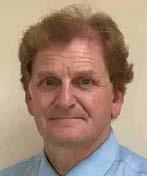

HAZARDS33HAZARDS33HAZARDS33HAZARDS33HAZARDS33HAZARDS33HAZARDS33
Challenges from a North American Perspective
The New UK Government Initiative on Best Available Techniques and its Implications
HAZARDS33HAZARDS33HAZARDS33HAZARDS33HAZARDS33HAZARDS33HAZARDS33
HAZARDS33HAZARDS33HAZARDS33HAZARDS33HAZARDS33HAZARDS33HAZARDS33
Find out more and register: www.icheme.org/hazards33
HAZARDS33HAZARDS33HAZARDS33HAZARDS33HAZARDS33HAZARDS33HAZARDS33
HAZARDS33HAZARDS33HAZARDS33HAZARDS33HAZARDS33HAZARDS33HAZARDS33
HAZARDS33HAZARDS33HAZARDS33HAZARDS33HAZARDS33HAZARDS33HAZARDS33
MB0439_23
ISC
C hemE S a f e ty C entr e
I
STOLTHAVEN SINGAPORE: THE NEW HIGHLY AUTOMATED TERMINAL IN THE INDUSTRY
Tank Storage Magazine talks to the team at Stolthaven Terminals Singapore about the development of its terminal and its Dow SEA S4TAR Award
STOLTHAVEN
TERMINALS
commissioned the development of the 15-hectare Singapore site in November 2011 to increase the reach of its supply chain solutions for customers. The terminal aimed to meet customer demand in the region for high-quality industrial and distribution services for the storage and handling of bulk liquids and gases ,and enhance Singapore’s position as a manufacturing and distribution hub.
Since then, Stolthaven Terminals has invested in progressive expansion and currently has an operating capacity of 230,700 m³ (81 product tanks) with potential for up to 300,000 m³. The terminal is designed perfectly for chemical tankers, with optimally-sized tanks for chemicals and a dedicated pump and pipeline system to ensure product quality.
LOCATION, LOCATION, LOCATION
Stolthaven Singapore is a modern and highly automated facility that is operated

by a team of experts who are dedicated to ensuring that its customers’ products are in good hands.
The terminal is ideally located to serve as a key point in its customers’ global supply chains, especially as it can provide integrated solutions in partnership with its sister companies, Stolt Tankers, for worldwide shipping services, and Stolt Tank Containers (STC) for door-to-door land transportation.
Located within the industrial area of Jurong Island, Stolthaven Singapore serves a large and growing number of manufacturers and suppliers located there with pipeline connections between terminal and plants. Without these, clients would have to use cross-harbour shipment methods.
Specifically, the terminal is located in the Tembusu sector. This is currently not yet fully developed, but the facility is well positioned to store and handle alternative fuels for bunkering and power plants.
TERMINAL INFRASTRUCTURE
The terminal’s advanced infrastructure, comprises three jetties, six truck loading bays and supporting utilities, such as heating, blending, and sparging, which is a specialised process to remove water content in products it stores.
Stolthaven Singapore has made a concerted effort to engage with its customers to understand their evolving needs and meet their specific business requirements. As part of this commitment, Stolthaven Singapore has introduced business-to-business data integration to further improve the efficiency of key tasks including order processing and tracking and tank inventory management.
HANDLING PRODUCTS
The terminal offers a wide range of bulk liquid and liquified gas import/export services; breakbulk distribution; valueadded product blending, certificate of non-manipulation and more.
It stores a wide range of products, including liquified gases, base oils and specialty liquids and gases, and intermediate and commodity chemicals. In addition, Stolthaven Singapore has been quick to adapt its facilities to support the transition to green energy and fuel alternatives. Mark Lim, commercial manager, Stolthaven Singapore says: ‘Stolthaven Terminals is actively involved in providing solutions and evaluating potential projects linked to the transition to greener energy alternatives. In Singapore, we are looking at potential projects relating to green ammonia, other hydrogen carriers, bio-bunkers and green methanol.’
General manager, Chek Chai Foo, says: ‘We are always on the lookout to see how we can do things even better for our customers, employees and other
PAGE 06
01 CHEMICAL SUPPLEMENT STOLTHAVEN TERMINALS SINGAPORE
stakeholders. We believe continuous improvement – which is the spirit driving all Stolthaven Terminals’ operations and initiatives – is key to achieving customer service excellence and business success in a sustainable manner.’
WINNING THE DOW SEA S4TAR AWARD
Dow’s four evaluation criteria – safety, service, sustainability and social responsibility – aligns with Stolthaven Singapore’s business priorities and Stolthaven Terminals’ global strategy so it was already making a conscious effort to embed initiatives related to these criteria into day-to-day operations and community-engagement activities. For example, the terminal scored much higher on sustainability than the three runners-up due to its multiple local sustainability initiatives, including its green terminal transportation and regular coastal preservation efforts.
Foo, says: ‘We are extremely proud and honoured to be recognised by such a valued customer for our consistently strong performance in safety, service, sustainability and social responsibility. Winning this award three years in a row demonstrates our commitment to continuously improving in these areas, which are so important to Dow and to us.’
We believe they are essential for optimising our business, the services we provide to customers and the relationships we build with them and the community at large. We are grateful to all our team members who made this achievement possible through their hard work and dedication every day, and to our customers and partners who support and guide us on how we can make sure our services continue to meet their needs.’
THE EVOLUTION OF OPERATIONS
Stolthaven Singapore is always looking at how it can add more value to its customers and better support their businesses. For example, the terminal is moving in-field terminal operations and communications online to connect and improve its systems and processes, give its people access to up-to-date product, asset management and safety information and provide intelligent, realtime asset insights.
Also, the terminal is adding value to the products it handles through blending on behalf of manufacturers for its customers to reduce or eliminate trade tariffs and providing supporting documentation such as certificates of non-manipulation, which are required to verify that products have not been modified during storage. Stolhaven is also an industry leader in terms of its commitment to sustainability and designing services around its customers’ needs (such as real-time data visibility and reporting).
ENSURING SUSTAINABILITY
For Stolthaven Singapore, the focus is on projects through which it can improve its energy footprint and support its customers to do the same. As a global business, Stolthaven Terminals was awarded EcoVadis silver status for sustainability performance in 2022 and was in the top 4% of companies rated by EcoVadis in the warehousing storage industry. It is striving to achieve a gold rating this year.
At the Singapore terminal, Stolthaven Terminals has introduced a range of initiatives to improve the sustainability of its operations and
general activities. As part of its green transportation programme, it purchased decommissioned electric golf buggies from a nearby golf club to transport larger equipment around the terminal. Refurbished bicycles are the main mode of transport for people around the terminal (as they are at most other Stolthaven facilities), because they are environmentally friendly and keep employees healthy. And the terminal recently purchased a decommissioned ISO tank from its sister company, STC, to collect and store rainwater for general domestic use onsite, such as cleaning.
It’s also important to keep sustainability front of mind for employees. Therefore, Stolthaven Singapore has appointed two sustainability leads who keep everyone informed about the company’s global sustainability agenda and encourage employees to submit ideas and engage in local activities.
Stolthaven Terminals has a target to make all its primary activities carbon neutral by 2040 through a series of related initiatives.
THE FUTURE
Transparent, real-time data, including integration with its customers’ systems allows for more efficient processes and decision making.
It is already happening – including at the Singapore terminal – however the team believes more can be done in terms of digitalisation development, in alignment with the wider maritime industry; for example, to reduce waiting/operating times for vessels in port.
Stolthaven Singapore, is focused on Stolthaven Terminals’ core business of storing and handling chemicals and industrial gas and continuing to deliver an exceptional service to its existing customers. This includes the continued automation of its operations and communications for optimum efficiency and data transparency.

Stolthaven Terminals is also exploring opportunities to support the energy transition and to invest in its site and infrastructure, potentially using the five hectares of available land it has on site.
For more information:
PAGE 07
Stolthaven
Stolthaven
02 CHEMICAL SUPPLEMENT STOLTHAVEN TERMINALS SINGAPORE
www.stolthaventerminals.com 01
operator on a buggy on site 02
Terminals Singapore
STORING CHEMICALS & SUSTAINABLE EXPANSIONS
Molly Cooper speaks to Paul Voogt, CCO and commercial director at Standic about the chemical terminal’s activities and future expansions

STANDIC offers tailor-made solutions for the storing of biofuels, base oils, lubricants, marine fuels and chemicals.‘Standic is made up of three terminals in the Netherlands and Belgium. The two chemical terminals are located in Dordrecht and Antwerp and since January 1 of this year, our sister company, Haan Oil Storage, became Standic Oil Storage in Dordrecht,’ says Paul Voogt CCO and commercial director at Standic.
The terminals in Dordrecht were originally constructed at the end of the 1950s and the De Haan family acquired the first terminal in 2006 in Dordrecht. ‘The original focus of the De Haans’ business was pure fuel distribution and automotive fuel distribution, but at that time, they were already looking ahead to diversify the business. They were already seeing that fuel stations and the fuel trade business was changing,’ explains Voogt.
Standic upgraded the Dordrecht terminal to drastically increase the chemical storage tanks’ capacity. At the time, it was working partly as an overflow terminal for the other facilities in Rotterdam.
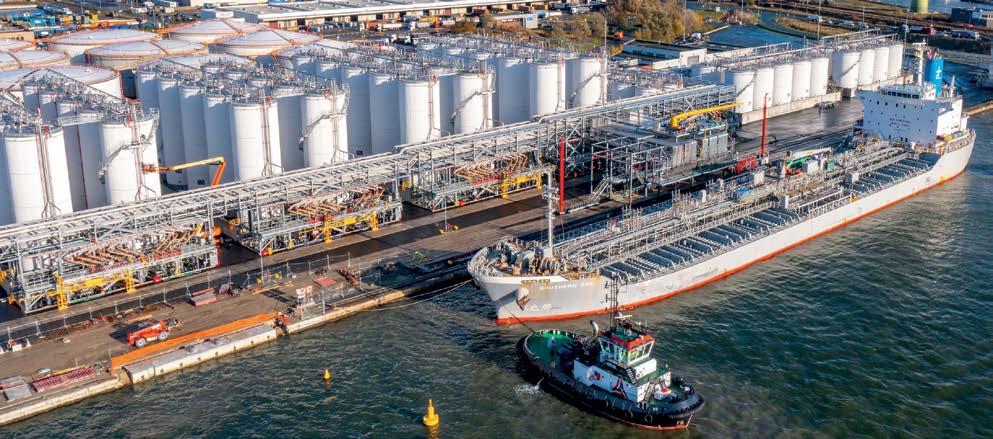
LOCATION & PRODUCTS
The Antwerp terminal was selected because of its location in the centre of the chemical cluster. ‘We had learnt from the industry that there was a lack of storage capcity for specialty chemicals and intermediates in Antwerp.There were not enough smaller tanks or dedicated infrastructure to accomodate for their storage requirements,’ says Voogt. Standic handles speciality chemicals and intermediates as its main focus for its Antwerp terminal. For its Dordrecht terminal, the company mainly focuses on ethanol for industrial purposes and occasionally, the fuel related to ethanol. ‘We have all licences in place to store and denature bioethanol,’ says Voogt. The other focus is lubricants, divided into white oils and base oil. Standic can also provide some mixing services for that sector. ‘It’s not only about the tanks and infrastructure – you have to adapt to changing market requirements and product volumes too,’ says Voogt.
PAGE 08
01 02 CHEMICAL SUPPLEMENT STANDIC
OPERATIONS IN ANTWERP
The Antwerp terminal is currently in its first phase of operation. This terminal is fully dedicated, meaning each tank has its own pump and line to the jetty/berth and also to the loading locations for rail wagons and tank trucks. ‘Our tanks are mostly stainless steel ensuring they are optimal for chemical products. Most of them can handle all flammable liquids with closed systems and vapour recovery systems already in place,’ explains Voogt.
Standic Antwerp is now ready for its second phase. By the beginning of 2024 it will have the first new tanks available for operation. The second phase of this expansion project will add another 85,000 m3 storage capacity to the terminal. Together with the first phase, the terminal will offer 179,000 m3 of dedicated storage capacity for chemicals.
EXPANSION IN DORDRECHT
Originally designed for automotive and marine fuels, Standic’s terminals are equipped with larger tanks and pipelines. ‘We recognised that variety in tank-size and flexibility is vital for our customers in Dordrecht. Here, we have more than 15 different sizes to offer in mild steel and stainless steel tanks, these can be heated and we can set up a dedicated system if a customer requires,’ Voogt says.
Not only this but the two Dordrecht terminals have jetties for up to 265,000 m3, rail capacity and more than 30 locations for loading tank trucks, making it the ideal location for distribution business. As of now, the company handles bioethanol, chemicals and lubricants, as well as more bio-based fuels for the automotive and marine sectors instead.
‘By 2026, in Dordrecht, we aim to be fully operational with 65,000 m3 storage capacity. By the end of next year, in Antwerp, we will also have entered into phase two and we have a third phase which will start immediately after the second one has completed,’ says Voogt. The third phase will add another 70,000 m3 to Standic’s portfolio, bringing the
total to 250,000 m3 of special chemical storage in Antwerp.
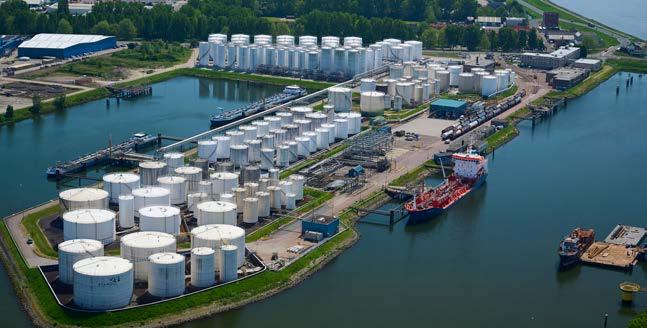
Standic’s phased approach to its expansion means that the team will have time to put the new infrastructure to market, while accommodating for its draft expansion. Voogt explains: ‘We currently have a draft of 11.5 m which will be expanded to 14 m in phase two.’
CUSTOMER SERVICE & FLEXIBILITY
Standic offers tailor-made services to its customers and has designed specific tanks and infrastructure for them when required. ‘For example,for a specific customer in Antwerp, we have installed specific closed loops for its loadings and unloadings. This reduces emissions from the chemicals, keeping gases contained within the system,’ says Voogt.

Standic also aids it customers with other services, not just storage. For non-EU customers, Standic can offer support by a dedicated Customs Team that handles all their customs-related matters, ensuring the highest standards of customer care.
Standic listens to its customers and the current market as much as it can and adapts its services accordingly where possible. An example of this is Standic choosing to construct more stainless-steel tanks during expansion or reconstruction phases. ‘This is more expensive but, in the long run, it provides more customer flexibility and less maintenance, meaning better sustainability,’ says Voogt.
When designing and developing new terminals, the company involves its customers by holding discussions with them, and potential customers. This has become especially important in recent years due to the energy transition. Voogt says: ‘We are also preparing for future market requirements with renewable and circular products and waste streams. That’s one of the reasons we are expanding here in Dordrecht with another 65,000 m3 and building new tanks and infrastructure ready for future use.’
SUSTAINABLE PRACTICES
Standic is looking outside of the BeNeLux region and is in discussions regarding other European locations. ‘Our focus moving forward is facilitating customers sustainable solutions, and of course our own. We are always searching for new locations in the ARA regions, and even outside of this, to help facilitate the sustainable solutions Standic are putting into place,’ says Voogt.
Currently, the company is working with the Port of Rotterdam to investigate the application of shore power, for the vessels to be connected to the shore power network in Dordrecht.
‘In Antwerp, we have a vapour treatment system in place for the combustion of gases from the shipments and the breathing of the tanks. We use this residual heat to heat up the tanks and other systems at our location. With this we turn waste into energy and reduce the use of natural gas for central heating and the heating of tanks,’ says Voogt. The tanks are placed on a concrete foundation with a foamglas insulation from Pittsburgh Corning Europe between the concrete bases and the bottom of the tanks, as another measurement to prevent heat loss to the bottom and reduce the use of energy for tank heating. ‘By investing in these sustainable systems now, we will be contributing towards a more sustainable future, and reducing costs in the long term,’ says Voogt.
For more information: www.standic.com
PAGE 09
03 04
Standic Antwerp
Standic Antwerp
An operator at a Standic terminal 04 Standic Dordrecht CHEMICAL SUPPLEMENT STANDIC
01
02
03
CHAMPIONING A SAFE & SUSTAINABLE CHEMICAL SUPPLY CHAIN







Tim Doggett, CEO at the Chemical Business Association, outlines the organisation’s efforts to help ensure a safe and sustainable chemical supply chain in the UK
industry is a vital sector that plays a crucial role in the UK and global economy, contributing significantly to the production of a host of essential products used across numerous industries. In fact, more than 97% of all manufactured products contain inputs from the sector.
By its very nature, the chemical industry must contend with unique safety, regulatory and environmental challenges.
Given the hazardous nature of many chemicals and the processes and regulations involved in their production, handling, and storage, they pose significant risks to human health, safety, and the environment. With this in mind, stakeholders are continuously and resolutely striving for safer, more sustainable and compliant operations across the chemical supply chain.
SUPPORTING SUSTAINABILITY
The chemical sector has encountered negative perceptions around sustainability for years. Contrary to popular belief, however, companies within the chemical supply chain are
actively involved and instrumental in finding solutions to help combat climate change and related environmental challenges.
The CBA itself has been part of the Responsible Care (RC) programme. This global, voluntary initiative provides an ethical framework for the safe use and handling of chemical products and seeks to deliver continual improvements in health, safety, security, and environmental performance across the industry, for the past three decades. All members are required to commit to the programme.
Last year, with the aim of demonstrating the chemical industry’s commitment to
the safe and sustainable management of chemicals, it published its own vision for responsible care in the 21st century.
One of the CBA’s initiatives to help the chemical supply chain become more sustainable and engage the workforce in environmental initiatives is the provision of carbon literacy training to its members through a series of webinars and workshops. The training allows those who become certified as Carbon Literate to run subsequent workshops in their organisations, widening the reach of this vital work.
SAFETY AS A TOP PRIORITY
Besides sustainability, the CBA is committed to improving safety performance across the chemical supply chain and as such proactively supports industry in improving the transport, storage, and handling of chemicals.One of its most valuable roles in this regard is providing authoritative workshops and seminars to members and nonmembers alike.
Its comprehensive training programme covers a wide range of regulatory and compliance matters, including COMAH,
PAGE 10
CHEMICAL SUPPLEMENT SUPPLY CHAIN SAFETY
‘Contrary to popular belief, companies within the chemical supply chain are actively involved and instrumental in finding solutions to help combat climate change,’
Spill Response, COSHH, and ADR, as well as Online Clinics and Best Practice Workshops on a variety of subjects.
The training offered by the CBA is designed not only to educate and inform, but also to provide peace of mind and assurance that companies working in the chemical supply chain are able to comply and work effectively within the industry’s increasingly complex regulatory framework.

Moreover, the CBA offers DGSA (dangerous goods safety adviser) services through its own in-house DGSAs, or bespoke training through its Compliance on Demand service.
In addition to being part of the Health and Safety Executive’s COMAH Strategic Forum, the CBA has its own dedicated COMAH Safety Leadership Forum which shares information, experiences, and best practice with its members. It also hosts a number of technical committees, providing a platform for member companies to share insight, provide evidence and highlight issues about a number of topics key to the chemical supply chain.
These have also led to practical solutions such as the designing and development of an IBC to carry higher strength ammonia, and which led to the CBA being Highly Commended in the 2023 Trade Association Forum (TAF) Awards Innovation of the Year Category.
SAFEGUARDING THE INDUSTRY’S FUTURE
Another aspect affecting the chemical supply chain is the perception that industry is not doing enough to address diversity, equality and inclusion (DEI). However, businesses throughout the chemical supply chain are actively and continuously ensuring that policies and legislation are revised, that training and development opportunities are accessible, and that best practices for creating more diverse, equitable, and inclusive environments are in place. Additionally, to ensure it attracts the diverse and inclusive talent pool required to maintain its position as a vital contributor to the UK and global economy, a number of projects have been launched in recent years.
The CBA itself has launched various initiatives aimed at challenging negative perceptions about industry, highlighting its importance to society and the economy, and in promoting the huge range of diverse career opportunities that it offers.
The CBA’s most recent project is the People & Skills Hub. Launched in July, the Hub is a dynamic network that
brings together education partners, aspiring professionals, industry experts and thought leaders from the chemical sector. Its aims include to act as a catalyst and space to facilitate knowledge exchange, skills development, and career advancement via a comprehensive range of resources, outreach programmes, and networking opportunities to empower individuals and organisations alike.
Last year, it also established its Future Council which is made up of young people with a diverse range of roles from its member companies The Future Council enables them to contribute meaningfully to industry. It allows workers to share their experiences and raise awareness, and to showcase the diverse career opportunities that exist in the sector to younger generations, while at the same time, growing their own professional network and to develop their own knowledge and skills.
Furthermore, the CBA has taken a leading role Generation Logistics, an industry-led campaign backed by the
Department for Transport which is aimed at bringing industry together, shifting perceptions, and encouraging the next generation to optimise opportunities in the logistics industry, from entry-level pathways to graduate programmes. This initiative is going into year two with impressive results, having collectively reached an audience of over 415 million, with website visits of nearly 600,000 and more than 4 million social media interactions.
INTERNATIONAL REACH
Whilst it serves businesses within the UK’s borders, the CBA’s influence and activities are not restricted to the UK, with its staff attending and participating in global events where they share knowledge and best practice on a range of subjects, from the carriage of dangerous goods and chemical warehousing, and logistics to regulation and engagement between national authorities and industry.
As companies in the chemical supply chain continue to focus on safety, and as they look to rapidly integrate sustainability into their overall strategies, the CBA, which has been the voice of the chemical supply chain for a century, continues to use its position as a leader and influencer to facilitate safe chemicals management, improve the environmental impact of the chemical supply chain, and to promote safe and sustainable practices.
For more information: www.chemical.org.uk
PAGE 11
CHEMICAL SUPPLEMENT SUPPLY CHAIN SAFETY
‘The CBA, which has been the voice of the chemical supply chain for a century, continues to use its position as a leader to facilitate safe chemicals management and promote safe and sustainable practices.’
SUSTAINABLE PRODUCT SOLUTIONS
Cepsa Química discusses its journey towards sustainable product solutions and the new reality in the chemicals market

LAB IS AN organic compound primarily used as an intermediate to produce LAS and LABSA, categorised as surfactants. LAS is the most consumed surfactant, supported by its strong technical performance, mainly used for home care applications. LABSA is also used in light-duty liquids (LDL), heavy-duty liquids (HDL), and unit dose applications (tablets and capsules) in laundry care and dishwashing and surface care products.
Cepsa Química has redirected conventional LAB manufacturing by moving away from traditional fossilbased materials and reducing GHG emissions during production.
LAB has commonly been produced of both paraffins and benzene. Depending on the paraffin used, the molecular weight of the final surfactant can be tuned, making it more suitable for a particular application.
DETAL technology allowed Cepsa Química to produce LAB and LABSA with a higher 2-Phenyl content. Cepsa Química’s new technology, DETAL Flex-2 phenyl (year 2020), enables Cepsa Química to produce all commercial LAB grades (high and low 2-phenyl) in the same installation, with total flexibility, depending on the demand.
This versatility allows the company to meet the specific demands of each client. Cepsa Química makes sustainable versions of all these grades available within the NextLab family.
REDUCING CARBON FOOTPRINT
In addition to DETAL Technology, Cepsa Química has developed NextLab and NextLabsa, a new range of chemicals, providing the same properties and performance as traditional LAB while having a reduced carbon footprint compared to its traditional counterpart.
The product systems are evaluated using the Life Cycle Assessment (LCA) methodology. The study was conducted according to the requirements of ISO 14040 and ISO 14044. The assessment reports on the core environmental impact indicators according to EN 15804:2012 + A2:2019/AC:2021.
A third-party peer review of the study has been carried out by a review panel comprised of five experts.
NEXTLAB-R
NextLab-R is the first commercial development of this new product range, a full molecule based on sustainably sourced biomass. Two products are manufactured: NextLab-R68, produced from 68% renewable raw material, and NextLab-R100, entirely produced from renewable raw material.
In the first stage, NextLab-R is produced by co-processing sustainable raw materials in the production assets and traditional feedstocks on a mass balance approach. The new product decreases global warming potential (GWP) emissions significantly, reducing
up to 80% compared to a standard LAB, saving up to 1,320 kg CO 2 eq. It is RSPO certified, non-peatland, no land use emissions considered (>20 years old), not considering POME treatment, using DETAL- Plus Technology. Other products included on the NextLab family are:
• NextLab-C: Based on circular raw materials, gives a second life to valued waste by recycling it and sending less waste to landfill.
• NextLab –Low Carbon: Manufactured using renewable energy sources, reducing GWP emissions. This production process is like the mass balance concept but with respect to energy sources. It is a way to produce regular LAB with clean energies and reduces up to 20% of the GHG emissions.
PARTNERSHIP
Active partnering with customers and industry is key to shape the direction of the sustainability dialog within its core business segments.
Cepsa Quimica has a joint venture with Golden Agri Resources (GAR) –Sinarmas Cepsa Pte Ltd (SCPL). GAR offers an extensive portfolio of fatty acids, fatty alcohols, glycerine, and soap needles manufactured using stringent quality control processes.
Sinarmas Cepsa is a member of the Roundtable on Sustainable Palm Oil (RSPO), SCPL and its subsidiaries are
PAGE 12
CHEMICAL SUPPLEMENT SUSTAINABILITY
fully committed to the production and marketing of fatty acids and fatty alcohol derivatives based on sustainable palm oil and palm kernel oil (PKO) with the best industry practices and the most stringent sustainability policies.
So, not only is Cepsa Química sustainably producing LAB and LABSA, but it is also producing other intermediates such as fatty acids, fatty alcohols, glycerine, and their derivatives, which are the following surfactants: fatty alcohol ethoxylate (AE), sodium lauryl sulfate (AS) and sodium lauryl ether sulfate (AES).
COMPLYING WITH STANDARDS
Cepsa Química’s products comply with the ISCC PLUS (International Sustainability and Carbon Certification), a certification system for all markets,

such as the food, feed, or energy markets, and diverse industrial applications. ISCC PLUS covers all agricultural and forestry raw materials, waste and residues, non-bio renewables, and recycled carbon materials and fuels. Within ISCC PLUS, it must be guaranteed that the whole upstream supply chain up to the farm/plantation or point of origin is entirely ISCC certified (ISCC Compliant). Any material used in an ISCC Compliant supply chain must consist entirely of ISCC material.
Recently, Cepsa Química also obtained The Roundtable on Sustainable Palm Oil (RSPO) certificate. It certifies that a member bears the commitment and complies with all sustainable requirements. The aim is to make the palm oil sector more sustainable, bringing together stakeholders across the supply
chain to develop and implement global standards for producing and sourcing certified sustainable palm oil.
As part of Cepsa Quimica’s research and development area, the laboratory aims to focus on customers’ needs to ensure full support to meet the most strict technical and formulation requirements of the sector. Both individual surfactants and formulations can be characterised, and their performance can be evaluated (foam, soil removal, rheology profiles, stability, etc.).
Customers receive support in developing and improving different types of home and personal care formulations, enhancing the desired properties for each product type. Cepsa Química is continuously exploring alternatives to offer more sustainable and innovative products.

NEW SUSTAINABLE REALITY
Cepsa Química is adapting to a new reality with more sustainability initiatives and changes to products. For example, soap manufacturers launching plant-based products with new ingredients or companies producing alternative packaging with reduced plastic, especially in developed regions. Convenience and sustainability are driving a shift in product formats with more concentrated formulas. A growing population in developing markets will help to increase the demand of alternative and sustainable products, bring new opportunities. The growth of the middle-class, urbanisation, and increasing social consciousness will play a huge role.
Cepsa Química’s goal is to expand its sustainable products and continue improving its current range. This goal includes achieving products made 100% with biobased materials and advancing the technology with constant innovation. Cepsa Química aims to reach zero GHG emissions by 2050 and create a better, sustainable world.
For more information: www.cepsa.com
PAGE 13
01 DETAL plant, Puente Mayorga Spain 01 CHEMICAL SUPPLEMENT SUSTAINABILITY
WOMEN CAN DO CHEMISTRY, TOO
Hande Cote, head of engineering at Johnson Matthey, discusses how being a woman in the chemicals industry isn’t the only factor that can put you on the back foot
HANDE COTE
, head of engineering
at Johnson Matthey, came from an under-represented society. When she was a young girl in school, she experienced several power outages and studied under gasoline lamps. This made her want to alleviate both energy and water poverty –so Cote became an engineer.
After studying engineering and completing her PhD, she couldn’t wait to start developing the products and services that could be used to benefit people’s daily lives. With that motivation, shortly after finishing her post-doctorate studies at Imperial College London, Cote started in the oil and gas industry in the UK.

Now, with over two decades of experience in the chemicals and energy sectors, and having worked as head of engineering in LATAM, EMEA, and East Asia, Cote is grateful the industry has given her the opportunity to serve the communities, tribes, and various levels of society through the reach of services and products.
A DAY IN THE LIFE
In her current position as head of engineering at Johnson Matthey, Cote is responsible for overseeing the engineering management and assurance of 28 global chemicals/production sites through the development of engineering standards and practices.
Through her team (sustainability, process, mechanical, automation & robotics, electrical & controls & instrumentation, civil & structure, asset integrity, and commissioning technical authorities and process engineering team), Cote develops asset integrity management initiatives, and strategies, and supports the energy management programmes.
Cote comments: ‘I am constantly engaged with cross-functional teams (procurement, human resources, legal, finance, strategy, EHS, research and development, and audit, diversity & inclusion, corporate affairs). I oversee the business approach to sustainable digital asset integrity and maintenance, energy and waste management (ISO 14001, ISO 50001, ISO 50006), creation of group engineering standards, and collaboration
with businesses and manufacturing sites (USA, UK, China, India, and Europe).’
She continues: ‘I support plant engineering functions in all aspects of design safety, civil and structural improvement work, energy reduction, predictive maintenance, and high-quality support for major capex projects. For example, creating an engineering scope for EPC with global supply chain for a variety of value creation projects. The role has a large scope and accountability that necessitates interaction with various stakeholders and an understanding of both internal and external contexts (regional regulations, local rules, socioeconomic aspects, policies).’
STARTING OUT IN ENGINEERING
Cote began as a graduate engineer and progressed to several roles within corporations. Working on onshore and offshore platforms, FPSO from the Gulf of Mexico to the Gulf of Guinea, and so on, shaped her personality. In addition, her experience has provided her with a wealth of expertise.
‘I worked closely with the locals to meet their needs; to emphasise the importance of localisation. I worked through transformation and established local teams in West Africa and Mexico. This had a favourable socioeconomic influence on the country’s infrastructure, social well-being, labour access, and wealth,’ comments Cote.
Cote has spent the last 10 years in group roles, establishing operational KPIs, developing engineering management systems, and risk management guidelines. Through this she has provided assurance, executed internal corporate audit programmes, and monitored the administration of group policies. She has always emphasised developing a sustainable asset portfolio, improving equipment performance, and building entity resilience that protects the interests of stakeholders and reputation. There are numerous processes involved in chemical industry manufacturing and production. Cote is captivated by overseeing each stage, from integrating new technologies such as AI, digital twins and other digital methods, to
PAGE 14
01 CHEMICAL SUPPLEMENT WOMEN IN TANKS
sustainable practices. Considering how the industry can improve, it is still slow, which indicates the industry needs more incentives to build more research and development facilities.
SECURING A BETTER FUTURE
The chemicals industry needs to collaborate more with policymakers, government agencies and the private sector in order to achieve greener and more sustainable operations and product lines. While things are moving and new partnerships are being formed, there is still a long way to go and the industry must accelerate progress toward net zero emissions.
‘This is a worldwide scope within the chemical industry; there must be clear goals and they should be shared. Knowledge and best practices are critical success factors for initiatives. Communication and the building of ambitious alliances are essential for success,’ comments Cote.
Throughout her career, Cote has managed many physical assets, promoted significant expansion, optimised chemical processes, created opportunities for local communities, provided training, and held senior management positions across the world. She is thankful to both chemicals and energy industries in making her a global citizen.
ENCOUNTERING OBSTACLES
Given Cote’s varied career, working in different regions, such as Latin America, the Middle East, Africa and Asia means she has had to get used to the distinct conventions and societal practises. These norms, and on occasion, legislative impediments, can limit women’s participation in decision-making and result in gender inequality.
‘Throughout my work, I have encountered obstacles as a result of social norms. Being a woman on the factory floor poses unique obstacles,’ reveals Cote. There are also career break periods due to pregnancy and maternity. ‘All those stages of life should not be a barrier to career development. We need to encourage equal opportunities, particularly in terms of selection, remuneration, and promotion requirements. This should be carefully promoted in workplaces where the chemicals industry is currently moving slowly,’ Cote adds.
‘We cannot establish a resilient and flexible workforce without the input of women and future generations of women. We must seize every opportunity to increase the number of women in all areas of the
workplace and on the production floor, regardless of socioeconomic condition or cultural background,’ she continues.
As a woman of mixed heritage, Cote brought new strategies and perspectives to each role throughout her career. A workplace with a single force is impractical. A single-force workplace cannot be resilient to an ever-changing world, especially during economic and political upheaval such as that which the world is witnessing today.
GAINING RECOGNITION
Cote was recognised as a top 10 women leader in manufacturing, an accolade she is very proud of. Gaining recognition as a woman in the industry, is not only a big achievement but represents the challenges overcome to get to that point.
‘I am humbled by the recognition as a top 10 women leader in manufacturing, also being on the same list with female top professionals in the chemical business. I believe it is crucial to have this type of recognition award, especially for young women considering entering the field, so that they can see that their female coworkers are respected, included, and recognised,’ comments Cote. ‘I hope it inspires young female engineers as much as it inspires me,’ she adds.
SECURING TALENT
To be able to produce the right products, provide the correct services, respond to environmental and socio-economic challenges and meet the needs of different customer bases, companies need to win top talent. This means building diversity, equity, and inclusion into their policies and hiring practices.
Cote says: ‘Last year, I had vacancies for technical authority roles within my function, and we faced the challenge of finding female talent. We went back to HR to address our work flexibility and how we can improve our working conditions to attract a wider gender range.’ Generally, STEM subjects suffer from a lack of gender diversity. In particular, mechanical engineering or civil and structure, electrics and electrical engineering branches, women are underrepresented.
‘In some cases the ratio is 1/40 of applicants are women,’ says Cote. ‘We need to address how we can attract more girls into STEM in the first place, then look at how we can attract female candidates in jobs. This requires changes to job descriptions towards offering flexible working conditions, in some cases job shares or part-time roles.’
The pandemic has accelerated change in the chemicals industry, especially with regards to the digital transformation.
Digital will continue to be fast-tracked across every aspect of the chemical industry, including robotics and automation. ‘We see the ESG impacts from our products, and consumers are publicly demanding that businesses move beyond token gestures and into hard action. C-suite executives will increasingly be measured on, and rewarded for, progress against ESG targets,’ comments Cote.
ATTRACTING OTHER WOMEN TO CHEMICALS
The industry is experiencing a transition of energy supplies to renewable sources. Hence, Cote advises young women to step into the chemicals industry. There are lots of opportunities, from supply chain and manufacturing, to digital science and artificial intelligence through renewables. ‘It is a place to be for the future,’ Cote adds.
She suggests the key to attracting women is flexibility, future-proof jobs, and being part of a transparent, open, and ethical workplace. If one aspect is removed, the others will not be sufficient to attract young talent. Also, younger generations want ESG implemented in the workplace so they feel equal and valued.
CLOSING THE LOOP: A CIRCULAR APPROACH
The chemical industry is heavily reliant on raw materials, so it cannot use linear models in terms of supply chains. Rather than continually sourcing raw materials, work needs to be done to allow the adoption of closed loop process where the materials are treated and introduced back into the process. Cote says: ‘The circularity principles need to be embedded in the DNA of chemical production lines, requiring heavy research and development studies starting at academic levels. Young women can find a place both in the R&D world and the production world.’
She concludes: ‘Closed loop sits alongside established developments such as lean manufacturing or resource efficiency where more functional opportunities can be introduced to attract new female talent.’ As such, companies need to adapt their approach and ensure that retention schemes are in place for female workers, in addition to making role openings attractive in the first place.
For more information:
www.matthey.com
PAGE 15
01 Hande Cote on
CHEMICAL SUPPLEMENT WOMEN IN TANKS
site


porttarragona.cat 9th & 10th November
MAKING INSPECTIONS FASTER AND EASIER
The experts at Skygauge explain why drone inspections are the future
STORAGE
TANKS
, particularly those constructed to the API 650 or API 12C standard, are difficult and dangerous to inspect. The tanks are at minimum 50 ft (15.24 m) tall, and require thickness inspections on 40-60 points every five to ten years.
Traditionally, these inspections are done by hand with a certified inspector scaling the structure using ropes, a crane or scaffolding, and manually conducting a spot thickness UT test.
Using an inspection drone, such as one from Skygauge Inspections, modernises this process, improving safety, quality, convenience, cost, and time.

SAFETY FIRST
According to OSHA (The Occupational Safety and Health Administration) falls from a height are the second most common cause of death in the workplace, after vehicle incidents. Falls are responsible for more than 500 deaths and thousands of severe injuries across the United States each year.
The easiest way to reduce a workplace risk to zero is to avoid exposing your employees to it where possible. The Skygauge Inspection drone ascends to height, so your workers don’t have to. Inspectors can remain safely on the ground, indoors, or even offsite, and still conduct the test.
QUALITY AND CONVENIENCE
When the Skygauge drone inspects assets, it transmits its inspection reports live to a ground station. The ground station can then transmit these reports to an offsite location, or save them locally for later review by a qualified inspector. This means that the inspecting pilot does not have to be a certified API-653 inspector, and does not require any specialised skillset outside of a standard commercial drone pilot’s license. Past methods would have required an inspector to be certified in order to complete both UT inspections and complex high-altitude work.
Whilst inspecting, the Skygauge drone’s built-in software suite creates a 3D map of your asset. This means that past inspection points are saved for future
testing. When the next inspection cycle rolls around, five or ten years later, the Skygauge drone can still inspect those exact same points with perfect precision. This level of consistency is simply impossible with the manual recordkeeping that conventional inspections use. This improvement in consistency leads to more reliable data over time, and a higher quality of inspection overall.
Unlike manual readings, the drone is capable of vertical and angled contact, meaning that it can easily access the sides, roof, and (if elevated) bottom of a tank as required. This also applies if the walls or roof of the tank are sloped. The drone has optional attachments for surface preparation and cleaning and can operate in moderate winds. This ensures that you can still conduct the inspection if weather conditions or asset surface conditions are less than optimal.
SAVING TIME & MONEY
Facility downtime resulting from an inspection is usually more expensive than the cost of the inspection itself. Some estimates place the cost of shutting down all or part of an oil refinery at $1 million (€914,000) per day. Moreover, temporary structures such as rope lifts, scaffolding, and manlifts can disrupt the workflow at an industrial site, even if the entire site does not have to be shut down for the duration of the test.
Skygauge conducted a comparison study with Paul Holloway of Holloway NDT and Engineering. In an echo-to-echo test on
three specific locations on the tank it was determined that the readings from a handheld instrument and those from the Skygauge inspection drone were functionally identical. This proves that there is no loss in performance quality when using a Skygauge drone over a manual method for tank inspections. The Skygauge drone can complete inspections 10 times faster than traditional methods, minimising downtime and disruptions to facility operations. It is easy to compare the cost savings of using one drone, manned by a crew of two, against an inspection team of three to five people as well as multiple vehicles to help setup and teardown aerial work platforms. Skygauge customers report that 50-90% of the cost of a tank inspection was saved by switching.
FUTURE OF TANK INSPECTIONS
The Skygauge drone is capable of conducting API-653 compliant ultrasonic inspections of storage tank infrastructure. This work is completed with the same accuracy, and better quality, than traditional methods. Customers are able to save time and money while ensurig the safety when using Skygauge Inspections.
For more information:
www.skygauge.co
01
PAGE 51 TECHNICAL TANK INSPECTION
01 Pilots and inspectors operating the Skygauge Inspections drone
HOW MAPPING ASSETS IS KEY TO MAINTENANCE

MAPPING ASSETS can be hugely useful to help understand the inside of a tank, leading to better management. Using lasers to create these images can aid operators and workers in assessing facilities and assets better. Relying on inaccurate data can lead to incidents such as storage tank rupture, a decrease in production, environmental impacts and costly repairs.
Jason Hayes, market manager, Reality Capture Solutions, at Trimble Geospatial, explains how laser mapping works: ‘LiDAR, which stands for Light Detection and Ranging, is the core principle of our laser scanning solutions. The basic idea is that a pulse of light, the laser, is sent out from the scanner, which measures how long it takes the pulse of light to reach a surface and bounce back to the scanner. Because we know the speed of light, we can then calculate how far that surface is away from the scanner. We also measure the horizontal and vertical angles the light travels and can then calculate the precise 3D coordinate for a point. LiDAR systems send these pulses of light out very quickly, so you can get up to two million measurements per second.’
LiDAR data-processing software helps to identify the flaws within a tank, its floor or the structure. The technology
often means people don’t need to enter the tank or put themselves in potentially dangerous situations.
HOW CAN MAPPING BENEFIT OPERATORS?
Accurate data is an intrinsic part of ensuring safety and efficiency. By documenting the inside of a tank, colleagues across a facility – or multiple facilities – can access insights helping
them to ensure assets are in good condition and develop maintenance plans. Peter Merrett at Merrett Survey, says: ‘Once a terminal operator has laser scan data, it can be used for many different analyses. For example, data collected for an out-of-roundness assessment or IFR installation can help update the tank’s strapping table, feeding data into a new depth monitoring device. Any deformation detected will feed into calculations of the tank’s overall integrity.’ Scanning of the tanks, or indeed the entire terminal, for a 3D model provides efficient desk-based tools for planning maintenance, replacements, upgrades, expansions, pipework routing and clash avoidance research. The 3D model can be viewed in a VR (virtual reality) environment, which is ideal for training new staff on all aspects of the site.
Hayes comments: ‘Unique features such as automatic instrument calibration and automatic levelling make our solutions very user friendly while increasing productivity and reducing yearly maintenance costs for calibration.’
IMPROVING SAFETY & EFFICIENCY
The laser mapping process means that accurate asset data can be collected without sending workers to physically map out the interior. The operator can set up the scanning instrument at a
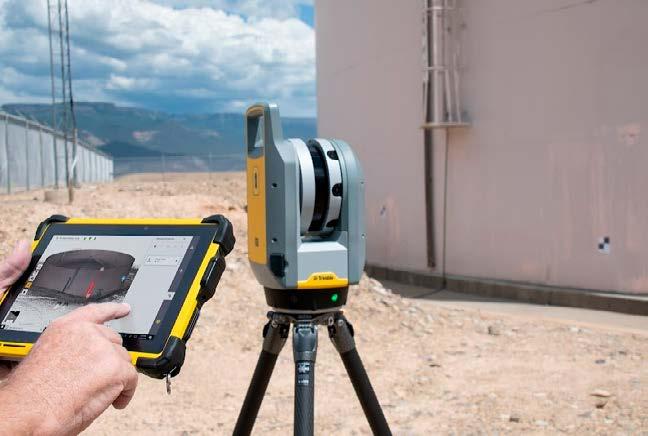
PAGE 52
Cyann Fielding talks to industry experts about how tank mapping with lasers can improve the efficiency and longevity of assets 01 02 TECHNICAL LASER MAPPING
distance from the feature and record data to millimetric accuracy, with no need to work at height, or expensive scaffolds or mobile access platforms. In turn, this reduces costs for the operator, as well as reducing the environmental impact of the project. This is because no machines need to be used to build any structures to carry out scans and mapping.
Colin Pittman, director at A3D, says: ‘You will no longer require temporary access platforms to elevate equipment into position to collect tank surface information, nor will you be limited to a few hundred data points providing minimal information for your reports.
3D laser scanning is cost-effective and very fast, providing many millions of data points for analysis and reporting.’
‘For underground tanks, the scanner can work in an inverted position, so we can lower the scanners through access hatches, avoiding the need for confined space access. This greatly improves safety, reduces the time and number of people required for that task,’ says Hayes.
It is important to understand the tech is carrying out tasks on a human’s behalf. Hayes says: ‘Our solutions are built to reduce complexity in the field and the office. In the field, running Trimble Perspective software on a tablet allows the operator to have confidence that they have all the data they need to go back to the office. This is because the field software automatically aligns the scans and displays them in 3D.’
Not only does this remove workers from potentially unsafe situations, but it also provides more accurate and detailed data – far quicker – than would be possible for a human worker to achieve.
USE-CASES FOR LASER MAPPING

Radial Deflection: This works by taking radial cuts horizontally through the middle of each tank plate (as many as required). The radial deflection of a tank can be observed compared to a true cylinder (an accurate 3D model of the tank).

Shell Verticality: By taking a vertical cut at regular intervals (usually every 10m) through the side of the tank around its circumference, one can gauge the tank’s vertical integrity.
Tank Settlement: 3D scan data can be used to take measurements of the height of the skirt around the whole tank to check for signs of settlement.
Bund Volume Analysis: For operators using earth bunds for containment, 3D scans can assess ground levels and interrogate the variances that occur with natural bunds.
Tank Floor Analysis: Surveying within the tank with 3D laser scanners allows for an accurate map of the whole tank floor, useful for identifying settlement or any tilting. This means the lowest point within the tank can be calculated, allowing a water draw-off line to be added in the optimal place.
Roll Out Gradient Map: Laser mapping isn’t limited to the assets themselves. An accurate 3D gradient map of a client’s site can save time and money when it comes to new tank projects, enabling proper planning before any works begin.

By surveying a site once, then sharing the data online (as a point cloud or 3D model), multiple users can visit the site virtually and see every valve, pump, tank, nut and bolt without having to travel to the site. This saves time, money and travel, reducing the survey’s carbon footprint.
LIMITATIONS OF MAPPING TECHNOLOGY
Laser mapping is not a magic wand, and there are considerations that operators need to be aware of. Pittman explains: ‘Because 3D laser scanners read the light of a laser to record data, ambient light may blend with the laser and interfere with the scan’s accuracy. Depending on the severity of this interference, the scan may be noisy or even unusable; though, this happens very rarely.’
Laser scanning can be impacted by environmental factors, such as temperature, humidity, air pressure, and various weather phenomena. Proper
calibration can reduce the influence of these factors on the quality and accuracy of the data.
‘Calibration involves adjusting the settings and parameters of the laser scanner to fit the specific conditions and requirements of the scanning site and target object. Furthermore, calibration can help to fix any errors or distortions in the data caused by the laser scanner itself or its accessories,’ says Pittman.
Lasers can also only be used to a certain distance. Hayes says: ‘Laser scanning works on a line-of-sight principle, so basically if you can see it, you can measure it. The only limiting factor is the laser scanner’s range.’
The technology is constantly developing to overcome these limitations. Hayes shares: ‘In the past LiDAR had trouble with very dark surfaces, but the technology in Trimble scanners such as the X7 and X9 do very well with these types of dark surfaces, which makes them ideal for storage tank applications.’
PAGE 53
05 03 04
TECHNICAL LASER MAPPING
FUTURE PROSPECTS FOR MAPPING TECHNOLOGY
The technology involved in mapping is still very new and evolving every day. Data has more than one use, and this means the technology can be used for a wider purpose. ‘The airborne LiDAR technology that was previously only available in a full-size fixed wing aircraft
can now be mounted on a drone,’ says Merrett. ‘This doesn’t yet achieve the accuracy required for tank scanning, but, we use drones for camera work. This includes detailed inspection surveys and the imagery can be used to make high quality 3D surveys.’
Merrett also explains that AI can be used to look for corrosion using drone-based
RADIAL DISPLACEMENT PLOTS
Peter Merrett, from Merrett Survey, explains how radial displacement plots can help indicate the integrity and condition of an asset: Displacement plots are a way of visualising the ‘roundness’, or more importantly, the ‘out-of-roundness’ of a cylindrical tank shell.
The point cloud data is used to compute a mathematical centre of the tank, and then compute the average radius of the tank wall from the centre. So, the operator works with the reality of the tank’s shape, rather than relying on a potentially outdated design radius.
Horizontal slices up the tanks’ walls can be taken and determine the deviation of radius at each of the measured points, compared to the average radius. If the difference is exaggerated, it can help the tank owner or integrity engineer to visualise the out-of-roundness.
This is of great use to anyone wishing to install an IFR (internal floating roof), as the analysis can create and measure where the IFR may clash or where the gap between the IFR and tank wall is too great for the seal to reach across.
The point cloud can be useful in its own right, but the datasets can be large; many operators don’t yet have the software to handle this type of data. Merrett Survey can supply free data viewers for users to access the dataset. Data in this form is good for visualising the asset being surveyed and can be used to take accurate measurements of plant, pipes, vessels and tanks that are remote or inaccessible. The added value in the point cloud data comes with analyses; once it is processed into 3D models, the data size reduces, and industry standard software can be used for design work, planning, training and asset management.
In addition to radial plots, data can be taken from the whole tank surface, digitally unrolled with the deviations colourised to identify the locations and extents of any deformations. Additional analyses include the creation of a tank floor map which will identify any tank bottom settlement. Tank tilt (verticality) can also be easily measured using the scan data.
External scanning can include computing the bund volume to ensure its capacity meets the 110% capacity of the tank. Using aerial LiDAR, the wider area can be mapped, including a spill analysis to see the likely location or route of any spillage. Volumetric analysis, also known as tank calibration and tank strapping, has been revolutionised with the application of laser scanning. By using millions of closely spaced, high accuracy points the true volume of a tank can be computed. Deadwood (pipes and objects not containing fluid) can be modelled and removed from the volume calculations.
imagery. ‘Most of our work is conducted using tripod mounted scanners, but there are hand held scanners that are getting more accurate. The tripod mounted scanners are getting lighter, faster and with longer ranges,’ says Merrett. But this may change in the future as AI and drones begin to play a bigger role in tank mapping. Merrett says: ‘The oil and gas industry can sometimes be conservative as regards new technology, but laser scanning is now a standard method of measurement. It is important because it’s an efficient and safe method that should provide cost savings and increase insight into the operator’s assets. It is being improved and developed all of the time and will in the future enable even more efficiency and cost savings.’
For more information:
www.geospatial.trimble.com
www.lasersurveying.com
www.merrettsurvey.com
www.storagetanksurveys.com
01 Capturing data in the field. The tablet allows users to see the data and add annotations with important information about the tank (via Trimble)
02 3D modelling of pipework at a terminal from laser scan data (via Peter Merrett)
03 Radial deflection: 3D model of a tank (via A3D)
04 Shell verticality: 3D image of tank section (via A3D)

05 Tank calibration image (via A3D)
06 Earth bunds: bund volume analysis (via A3D)
07 Radial displacement plot – red line shows the average radius (via Peter Merrett)

08 Colourised deformation analysis – tank ‘unfurled’. Note – image top left is a laser scan point cloud coloured using the internal camera (via Peter Merrett)

PAGE 54
06 07 08
TECHNICAL LASER MAPPING

MODERN FOAM FOR SAFER FIRE SUPPRESSION
ALCOHOL-RESISTANT aqueous film-forming foam (AR-AFFF) has been the standard for delivering rapid control and extinguishment of large, flammable liquid storage tank fires. As foam technologies evolved, a new class of non-fluorinated products was introduced but struggled to deliver the performance of traditional AR-AFFFs –until now. Recent advancements have resulted in non-fluorinated foam solutions that perform similar to legacy foams.
The latest industry innovation is the new Thunderstorm WNF33A 3x3 foam concentrate, part of the Williams Fire & Hazard Control foam portfolio from Johnson Controls. It is the first product in its category to deliver control and extinguishment performance on large hydrocarbon tank fires that is comparable to its ARAFFF predecessors. WNF33A is UL 162 listed as an alcohol-resistant synthetic fluorine-free foam (AR-SFFF) for use on hydrocarbon and polar solvent fires.
PUTTING IT TO THE TEST
Multiple rounds of tank fire testing have demonstrated the firefighting performance of Thunderstorm WNF33A foam concentrate.
The foam was applied to fuel in-depth fires in a 42 ft (12.8 m) diameter tank. While NFPA 11 and UL 162 standards mandate a minimum foam application rate of 0.16 gpm/ft 2 for these types of fires, the Thunderstorm WNF33A Foam was tested at half that application rate, 0.08 gpm/ft 2 (3.26 lpm/m2), to challenge its fire suppression properties. Following a 30-second pre-burn, firefighters were able to achieve control of the fires with a 3% Thunderstorm WNF33A foam solution in less than 2 minutes, with full extinguishment in under 5 minutes. For comparison, legacy Thunderstorm AR-AFFF products applied at the same application rate delivered
control times in the range of 1 minute 45 seconds to 3 minutes, demonstrating the control performance of the new, nonfluorinated foam.
The Thunderstorm WNF33A Foam has a 25% drain time that exceeds one hour and provides for a long-lasting blanket with enhanced burnback resistance and vapour suppression, which aids in postextinguishment hazard control of large flammable liquid tank fires – unlike many non-fluorinated firefighting foams on the market, Thunderstorm WNF33A Foam has been extensively tested for use in conjunction with dry chemical agents. It’s compatible with Purple-K and similar dry chemicals for dual firefighting application.
BENEFITS FOR FIRST RESPONDERS
Equally important as fire suppression performance is the ability to apply the foam concentrate using conventional firefighting equipment. Thunderstorm WNF33A foam concentrate produces robust, effective firefighting foam blankets at low expansion ratios –between 3:1 and 4:1 – verified by independent, third-party testing. This lower expansion range allows application of Thunderstorm WNF33A foam with most standard discharge equipment, and for first responders provides a safer throw distance than air-aspirated foam.
Thunderstorm WNF33A Foam
Concentrate was developed with a viscosity-shear curve very similar to the legacy Thunderstorm concentrates. Therefore, it may be effectively
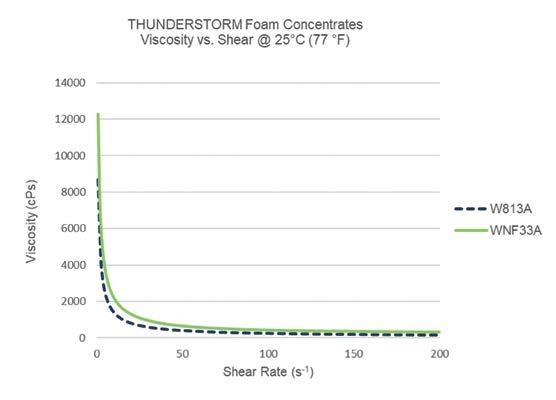
PAGE 56
01 02 Thunderstorm Foam Control Time Legacy F-601A AR-AFFF 1 min 45 sec Legacy F-601B AR-AFFF 2 min 40 sec Legacy W813A AR-AFFF 2 min 55 sec Non-Fluorinated WNF33A AR-SFFF 1 min 49 sec TECHNICAL FIRE SUPPRESSION
David Garris, firefighting foam agent & hardware product manager, at Johnson Controls explains how its new non-fluorinated foam has proven effective for large tank fire suppression
proportioned with the same type of equipment and setup as the legacy concentrates in most applications. The concentrate is UL listed for application with industry standard nozzles, foam chambers, and sprinklers.
ECO-FRIENDLY FIREFIGHTING FOAM

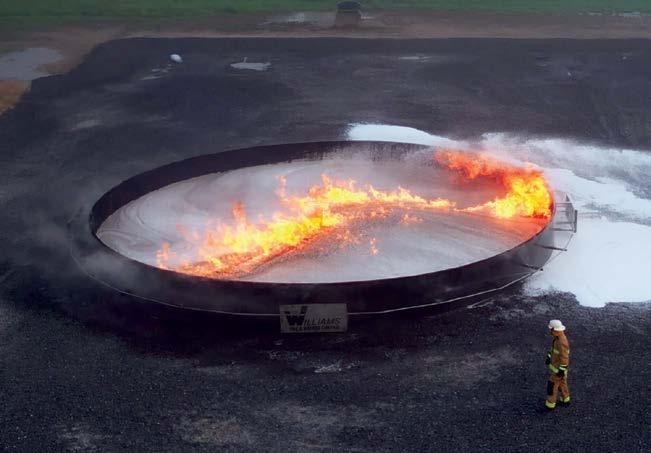

Thunderstorm WNF33A Foam
Concentrate is a readily biodegradable, GreenScreen Certified Silver formulation. As a non-fluorinated foam concentrate, it does not contain intentionally added PFAS chemistry, and it is produced using equipment that has not handled PFAS chemistry.
PURSUING THE HIGHEST LEVEL OF PERFORMANCE
The transition from AR-AFFF to new, high-performing non-fluorinated foams for Class B firefighting demonstrates the industry’s adaptability to new customer demands and shifting regulatory guidelines. By employing the latest advancements in foam technology, such as Thunderstorm WNF33A concentrate, emergency response teams can be prepared to face the most challenging flammable liquid hazards with the greatest confidence.
For more information: Visit WilliamsFire.com to learn more about fire suppression solutions for oil and gas and other industrial hazards.
01
02 Comparison of Thunderstorm non-fluorinated vs. legacy foam viscosity measured on a Brookfield Viscometer, Spindle #4 @ 30 rpm
03 Pre-burn on 42 ft open top tank
04 Control achieved on 42 ft tank fire
05 Extinguishment of 42 ft tank firefourth
PAGE 57
03 04 05
Table 1. Comparison of time for Thunderstorm WNF33A vs. legacy foams to achieve 90% control on large, 42 ft diameter tank fire of hydrocarbon fuels
TECHNICAL FIRE SUPPRESSION
THE KEY TO SUCCESS FOR DATA INTEGRITY

Cesar Espinoza and Veronica Dominguez at Rosen USA break down the essentials for ensuring smooth and effective data management and integrity
DATA MANAGEMENT refers to the process of collecting, organising and storing large amounts of data in such a way that it can be useful and easy to access, navigate, and analyse.
Facilities owners and operators now have more access to mechanical integrity data than ever before. As technology continues to advance, data will become increasingly accessible.
On the other hand, the challenges of working with large volumes of data, and the need for automated systems to manage it, will become more prevalent.
The ultimate goal of an integrity management programme is ensuring and maintaining safe and reliable operations. Effectively generating risk profiles at different hierarchy levels (plant, unit, equipment and circuit levels) helps to determine what risks exist and where they are. Support can then be provided to the owner to mitigate this. When organisations can effectively do this, they achieve greater production uptime, more efficient operations, and more reliable predictions.
TYPES OF DATA MANAGEMENT
There are two levels of data management in a typical processing facility. The first uses simple models to pull relevant and validated data from the established sources to visualise correlations and trends. This is done via filtering and generating charts. This is a level of data management that is used by integrity management personnel on a daily basis for routine tasks. Examples would include: wall thickness data; operating temperatures and pressures; sample
chemical analysis results (such as pH, water cut, and chlorides content) and; corrosion rates.
The next level uses more complex analytical models and generally requires data scientists and machine learning software. It typically requires specialised third-party involvement, aiming for a more predictive and forward-looking strategy development.
Without a clear and proper strategy for data management, facility owners will become tied to the use of segmented and qualitative approaches for managing asset integrity. This translates in subjectivity and variability in how reliability programmes are managed; decisions will not be data-driven and therefore, not consistently applied. The world of possibilities enabled by proficient data management becomes evident within every aspect of facility operations. Data management accomplished through a well-suited integrity management application (IMA) and mobile data reporting solutions can result in significant time and cost savings. These streamlined capabilities allow faster inspection activities, while the collected data becomes available in real-time. Data management can also aid post-inspection work by making it more informed and relevant.
CHALLENGES OF DATA MANAGEMENT
At any facility, there are normally several systems simultaneously collecting and processing good data. These systems and data sets are often siloed, since they don’t effectively communicate with
each other. There may be information nuggets that could greatly support asset management, but that can only become evident once the data is integrated. One way to overcome this challenge is to integrate the data siloes from different departments (inspection, maintenance, operations, etc), into a centralised data repository. Then, apply predictive analytics to obtain useful outputs for inspectors, engineers, and maintenance personnel. An example of the importance of correlating the data is illustrated with the charts opposite. Two sets of data belonging to different data bases were plotted together with the aim of determining correlations and patterns that could lead to a better understanding of a series of failures associated to aqueous sour water corrosion and hydrogen induced cracking in a gas recovery unit (GRU) in a typical refinery. Both corrosion mechanisms are widely related to the H2S presence in aqueous phase (Wet H2S Damage) and a high content of cyanides and ammonia. In the first chart (Figure 01), process engineers plotted cyanides content in the water (vertical axis in mg/L) on one of the pressure vessels boots outlet over time. This data is captured from water samples taken from several sample points and then analysed in the refinery laboratory. The trend revealed cyanides were under control for a certain period of time and then became erratic, exceeding the design thresholds.
By plotting the lab analysis of the water samples against other data sets, it became evident the influence of the lack of wash water injection in the significant increase of free atomic hydrogen that
PAGE 58
TECHNICAL DATA MANAGEMENT
is available to permeate through the steel and cause hydrogen damage (Figure 02). The wash water injection data (right vertical axis in tons per hour) was captured by the plant operations monitoring software.
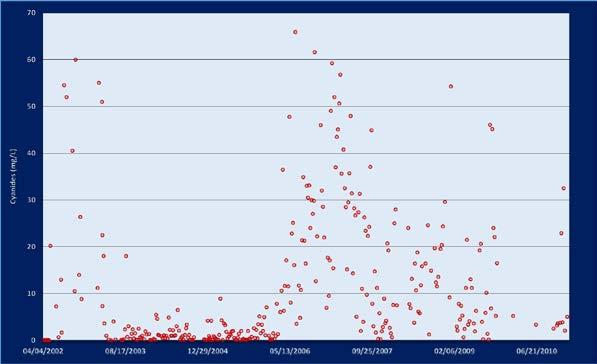
By leveraging failure history and maintenance costs from the computerised maintenance management system (CMMS), it becomes possible to determine the cost and losses associated to this operational constraint. All this study provided the refinery owners with clear decisionmaking criteria to solve the problem.
CLEAR PROCEDURES FOR LARGE DATA SETS
Managing and organising large volumes of data can be complex, costly and time consuming. Facility owners are continuously collecting large volumes of data points, very often unknowingly of whether they will be able to make use of it (or even how), and potentially, with management systems not mature enough to fully leverage this data.
To overcome this challenge, a robust data management system is paramount. These systems need to handle the complex relationships between different types of data or data sets, and need to provide users with the ability to easily find and reproduce the desired information. This can require sophisticated systems that can support the needs of different users across the organisation, and can provide the right level of access and controls.
To ensure good data can be leveraged by all interested departments, it is important to have clear procedures in place for all aspects of the data collection protocols. This includes training and supervision of the personnel involved in the data collection, the use of standardised
measurement instruments, and the procedures for verifying the accuracy of the data. This can ensure the data is properly collected and incorporated into a data management system.
DATA INTEGRATION
The future of asset integrity within refineries and plants lies within the benefits of an integrated data highway. This is because data can come from various incompatible sources, such as multiple types of nondestructive testing (NDT) tools and online monitoring systems that have been collecting data for years with different levels of completeness and complexity.
For integrating these distinct sources, a comprehensive IMA solution specialised in risk assessment, management of inspection and corrosion data management, and with powerful visualisation capabilities is fundamental. An IMA should be able to store, analyse and generate actionable insights from
the data. An IMA with the proper analytic tools can manage multiple assets across multiple facilities in one platform. This increases transparency in the inspection process and helps operators meet compliance requirements. Both owners and operators can simplify the process of integrating data from multiple inputs, by partnering with integrity management consultants specialising in a wide variety of solutions. Rather than retroactively integrating incompatible data from multiple sources (such as data from drones, inline inspections (ILI), NDT examinations, and online monitoring systems), relying on a single consultant to execute all of these activities helps ensure that the data collected, can be easily and effectively stored and analysed.
Advanced mobile inspection data reporting platforms have developed into mobile cloud-based field inspection, execution, and reporting solutions. Through the use of handheld devices in the field, mobile inspection data reporting platforms allow technicians to develop reports directly on their device. This further enables them to send information dynamically to an IMA, thus removing the time and manpower inefficiencies present when manually entering data.
For more information:
Don’t miss the Rosen Group’s case study into how a successful software implementation rendered great dividends. Online now!
www.tankstorage.com/partner-news/ rosen-group-data-casee-study

www.rosen-group.com
01
02 Comparison between wash water rates and cyanide content
PAGE 59
01 02
Cyanide trends in GRU fractionator tower top accumulator boot.
TECHNICAL DATA
MANAGEMENT
AVOIDING REPUTATIONAL DAMAGE AND INJURIES
TANK CLEANING plays a critical role in ensuring the efficiency and safety of oil storage facilities. Traditional practices involving a confined space entry (CSE) crew for cleaning and maintenance have proven to be hazardous, leading to avoidable fatalities, and accidents.
Prioritising safe, reliable and efficient tank cleaning is vital to terminal operators. This is especially true when they consider the financial, human and reputational damage of accidents and injuries, not to mention the downtime associated with using a traditional manned crew. Thus, terminal operators should be advocating for the urgent enforcement of no-man entry in tank cleaning, where possible.
The adoption of no-man entry cleaning methods, like those available from Re-Gen Robotics, is increasingly favoured.

The initial investment in implementing automated systems would be offset by long-term benefits, including reduced labour costs, lower insurance premiums, and minimised expenses associated with accidents, injuries, and litigation.
In today’s connected world, reputation is everything. News of accidents, injuries, or fatalities in the oil tank cleaning industry spreads fast, leading to negative public perception of affected companies. Adverse incidents can irreparably damage a company’s reputation, undermine investor confidence, and directly impact share prices. By prioritising manless entry
companies can protect their brand image, enhance stakeholder trust, and maintain a positive market valuation.
THE BENEFITS OF NO-MAN ENTRY
The manual cleaning of oil tanks presents inherent risks, including exposure to toxic gases, lack of oxygen, and potential explosions. Tragically, these hazards have resulted in the loss of human lives and severe injuries. Any fatality is one too many with a significant impact on families, communities and companies. Employing manless entry systems, such as Re-Gen Robotics’ Zone 0 EX certified, remote-controlled robotic tank cleaning service can significantly reduce or eliminate these risks altogether. By removing human workers from dangerous confined space entry environments, companies can prevent accidents and fatalities for their employees.
OPERATIONAL EFFICIENCY
The Re-Gen Robotics team has a highly specialised background in oil tank cleaning, hydrocarbon recovery, and waste minimisation. Its experience encompasses every tank design and type of material such as crude, Jet-A1, gas oil, heating oil and gasoline. In less than four years, Re-Gen Robotics has eliminated 15,000+ hours of CSE cleaning in over 60 tanks.
Industry giants, such as Shell, Valero, P66, ExxonMobil and Vermilion, are embracing no-man entry tank cleaning services because they’ve discovered they offer major advantages in terms of operational efficiency.
Re-Gen Robotics’ technology can perform tank cleaning tasks with increased speed, precision and consistency compared to any other system or human labour. Tank downtime is reduced by between 40-60% because of the short time it takes to assemble the equipment and the elimination of staff in CSE.
WHAT HAPPENS ON SITE
From arrival on site, the entire tank cleaning system can be set up in four hours. That’s a significant reduction compared to the time required for human crews to prepare. Robotic tank cleaning is also classed in many operators’ systems as a medium risk, which also reduces lengthy procedures, paperwork and the complexity of permits.
Re-Gen Robotics’ robot is not susceptible to fatigue, leading to reduced downtime during maintenance activities. As a result, companies can enhance their overall productivity and cost-effectiveness.
A robot can optimise the cleaning processes leading to decreased water and chemical usage, further contributing to cost reduction and environmental sustainability. This boosts environmental, social and governance (ESG) credentials. ATEX Zone 0 robots are economically and environmentally friendly because of their closed-loop cleaning circuit. There is an opportunity to reclaim precious oil from the sludge and return it to the customer, which they can monetise.
For more information:
Re-Gen Robotics’ key success is achieving far greater technical results while having fewer people risk their lives. It is time to prioritise safety, embrace innovation, and work towards a safer and more efficient oil tank cleaning industry.
www.regenrobotics.com
ADVERTORIAL RE-GEN ROBOTICS PAGE 60
Aidan Doherty, managing director of Re-Gen Robotics, discusses how no-man tank cleaning can impact safety, costs and reputation
PROTECTING CRITICAL INFRASTRUCTURE
Molly Cooper investigates how tank terminal operators can protect their staff and assets from terrorism and security threats
IN
A TIME
where parts of the world are at war, and security threats and terror attacks loom large, safeguarding critical infrastructure becomes vital. This includes storage terminals. ‘In any event of any war, the first thing that you attack is the infrastructure. Oil, gas, electricity, water and that’s what’s happening in Ukraine. They are going to attack what the country is dependent on,’ says Chris Phillips, managing director at IPPSO (International Protect and Prepare Security Office).
Storage facilities and refineries cover large areas, while having a constant flow of workers and materials which create significant security challenges.
‘Traditionally, security at these sites consists of fences, surveillance cameras, access control and on-site personnel. These measures provide a solid foundation, but security gaps exist,’ explains Brad Martin, director of product management at Senstar.
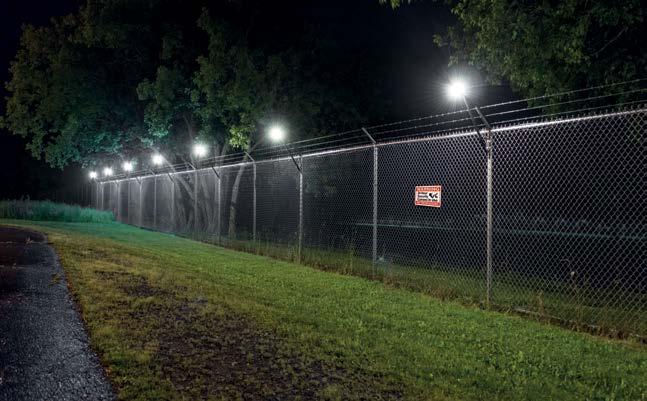
A lack of proper security systems for terminal operators can be very costly. A deliberate attack on a facility could result in injury or loss of human life, harm to the environment and severely impact supply chains. Even less serious incidents, such as theft or trespassing, could also result in damages to high-value assets and interruption of operations.
In the last year, Tank Storage Magazine reported on many security incidents at tank terminals, including data breaches, tank explosions, refinery fires, drones and war-fueled attacks. Terminal operators must have a comprehensive approach to security, training and antiterrorism. ‘Many terminals are operated reactively rather than proactively,’ says Arend van Campen CEO at Tank Terminal Training. This approach needs to be changed as a priority.
REGULATORY COMPLIANCE
In the UK, sites that store certain products above specific quantities fall under COMAH – the Control of Major Accident Hazard Regulations. These regulations are founded on the Seveso directive that underpins European legislation. Under this legislation, there is a requirement to demonstrate the competence of the workforce across all levels, including coordination with offsite partners. ‘Compliance with all of these regulations has two main factors – security and training,’ says John Reynolds at Reynolds Training. Other key regulations for terminals in the sector to consider are:
• Sites served by jetty will need to comply with the International Ship and Port Facility Security Code, which places specific requirements on the port to ensure security is maintained both within the port itself and on the vessel.
• Alarm Management which is underpinned by a set of standards from EEMUA (The Engineering Equipment and Materials Users Association). These standards generally mirror the International Society of Automation standards for alarm management.
PROTECTING EVERYONE
Phillips began his career working at the National Counterterrorism Security Office, a police team whose role was to protect the UK from terrorist attacks. ‘This included hazardous sites, terminals, coal and gas sites and protecting places with crowds or large amounts of people. So, I learnt a lot about the industry,’ he explains.
Phillips recounts the Buncefield fire incident in the UK and the impact that had on safety and security operations. Although an accident, it showed how much damage a tank explosion could cause. ‘It made us realise that a lot of critical infrastructure were actually hazardous sites and were not well protected,’ says Phillips.
He recounts a time in which his team were investigating a group of terrorists who were exploring how they could attack a tank terminal in the north of England. While nothing happened, it put in perspective the security measures required for this type of critical infrastructure.
Phillips says, ‘Due to situations I had witnessed like this, when I retired, I set up a consultancy for anti-terrorism, security training and help. I’ve trained many CEOs in the TotalEnergies refineries in counterterrorism and run other training courses at terminals globally.’
PAGE 61
01 TECHNICAL SECURITY & TERRORISM
WHERE TO START?
Proper security really begins with basic knowledge and research. ‘It’s really important for people in the oil and gas industry to have knowledge of terrorism, how terrorists choose their targets and what type of methods that they would use to damage or destroy a site,’ says Phillips. ‘All senior personnel in head office, down to all staff on the ground need to understand terrorism,’ he says. This includes how it could impact their business, how they could be a target and also how to ensure that there’s a security culture at their sites that protects them from these types of incidents. Health, safety and security must be equal partners.
KEY STEPS
Physical security at tank terminal sites is the first step. But with new and emerging technologies, such as drones aiding attacks, not all physical security features can protect it. ‘The fences and the gates can be all 10 ft high with barbed wire on them but if you’ve got a drone that can fly over the top of it, you need to consider what you need in place to prevent that,’ says Phillips.
As a non-profit organisation, IPPSO provides engineered penetration tests on security systems. This tests if the equipment works and if the teams in charge are doing their jobs correctly. ‘If we make a breach on perimeter security, we will be looking to see if the camera operator picks it up immediately and reports it through the right processes,’ explains Philips.
Cyberattacks can also start from within. IPPSO provides a service which looks at a company’s employees and hiring processes, ensuring that companies are doing the right background checks on people when they come to work for them. Phillips provides five key points that all on-site personnel need to know when it comes to protecting themselves:
• Be aware of the threats
• Understand the motives of potential attacks
• Protect yourselves
• Evaluate potential implications if anything happens
• Test security and run through scenarios
By doing this, companies could save themselves from attacks.
INTELLIGENT MANAGEMENT
‘Physical security technology can augment the effectiveness of both physical infrastructure and security personnel. When designed and deployed
MAXIMISING HSEQ & OPERATIONAL EXCELLENCE BY INFORMATION SCIENCE
Tank Terminal Training is a training company focusing on downstream marine storage terminals training and consulting. It develops specific training programmes that help clients boost their professional excellence and HSE standards. During training at Arabian Chemical Terminals in Abu Dhabi, Arend van Campen CEO at Tank Terminal Training, discussed the requirements for total safety and launched Behaviour Observation Teams.
‘Every employee, including managers, office staff, operators or contractors, takes part in rotating observation teams of four to six people, observed the day-to-day operations for a period of two weeks,’ explains van Campen.
During this time, they list risky behaviours and convene to talk about this with management. These findings allow an HSEQ culture to be built and sustained. Van Campen regards information as being crucial to ensuring work gets done at a terminal. Without information, there will be a shortage of energy, putting the functionality of the terminal at risk. This information theory-based training creates a fair and uniform approach for HSQE culture.
correctly, it is a cost-effective element of a facility’s risk management program,’ explains Senstar’s Brad Martin. The company is a technology provider in advanced sensing and information management systems for the protection of critical infrastructure and facilities.
On top of the costs, a less tangible side effect is the damage done to a corporation’s reputation. Security breaches could lead to a perceived inability of the organisation to foresee and respond effectively to threats. In turn, this could have long-term effects on regulation, future approvals, and public opinion.
THE EQUIPMENT
Senstar provides comprehensive physical security solutions, extending beyond the traditional forms of protection. ‘Fence-mounted perimeter intrusion detection sensors turn existing fences into smart fences by detecting and locating attempts to cut, climb, or lift the fence fabric,’ says Martin. When an intruder is detected, the fence generates an alarm and provides the precise location, which can be
THE POWER OF SENSORS
used to trigger other on-site security resources, including cameras and sirens, loudspeakers, or security lights. The system can be monitored by centralised security personnel, enabling them to assess the situation remotely and dispatch a response if required.
‘One question that always gets asked about fence-mounted sensors is what happens if someone cuts the cable? When the sensor cable is cut, either accidentally or in an attempt to defeat the sensor, the system immediately reports the incident, including its exact location,’ explains Martin.
A new trend Senstar has seen is in intelligent, lighting perimeter security. This is installed on fences outside of designated hazardous areas. LED-based luminaries provide wide-spectrum illumination targeted along the fence line. ‘LED-based lighting is also ESG-friendly and dramatically reduces electrical consumption while a 10-year-plus lifespan eliminates maintenance,’ says Martin. Sensors embedded in the luminaries themselves detect the fence vibrations caused by someone attempting to cut, climb or lift the fence fabric. ‘Knowing they are detected, potential intruders may rethink their actions.’
A large critical infrastructure site was protected with Senstar’s Fiber Patrol fibreoptic sensor and Senstar’s Symphony video management system (VMS) when an intruder began climbing the fence and it was immediately detected. In addition to displaying an alarm in the central security office, the VMS automatically zoomed a high-powered PTZ camera to the intruder’s precise location for immediate operator assessment.
The barbed wire outrigging on the fence delayed the intruder by snagging them as security personnel went out to the location and apprehended him, before he could reach any sensitive areas.
PAGE 62
TECHNICAL SECURITY & TERRORISM
COMBINING WITH AI
Advances in artificial intelligence (AI) have led to the development of sophisticated object classification capabilities, including people and vehicle types. ‘This is important because these software modules may be included as part of a video management system,’ explains Martin.
Video analytics can detect and track activity both inside and outside protected zones and can be added onto existing systems at a low cost. Senstar’s Sensor Fusion Engine synthesises data from both fence sensors combined with video analytics to increase detection rates in more challenging deployment scenarios. Martin says: ‘For security operators, this helps deal with information overload and alarm complacency – when an alarm occurs, it is real and must be responded to immediately, avoiding any confusion.’
ENSURING PROPER TRAINING
Effective personnel training at storage terminals is critical for safe and efficient operations, reducing the risk of accidents and errors and ensuring highest security standards. ‘Training should embed core actions into an individual’s mindset. If you’ve got good emergency response training, it starts to develop muscle memory; what to do, where to go, initial actions to take,’ says John Reynolds, managing director at Reynolds Training.
Reynolds Training is focused on the energy sector, and specifically on the development and demonstration of competence across the whole sphere of operational and maintenance requirements within a bulk storage facility. ‘This goes from understanding tank farms through to occupational and process safety and control of work. It drives technical competence as well as softer skills around communication, mental health and people management,’ explains Reynolds.

TRAINER TO OPERATOR
As advice from trainer to terminal operator, Reynolds believes in assessing. ‘Assess where your vulnerabilities lie. This can be done in a very methodical way,’ he explains. Identify the assets present on site – both hardware and software and the systems that connect them.
Determine possible entry points to these assets and evaluate the level of control within your in-house systems. Check all software is up to date and any unnecessary software that can be removed.
Act on findings, update assets, limit access, train personnel in the security of information.
A SECURE FUTURE
‘With changing technologies and competing energy sources, we will require new skills and competencies as well as the evolution of the regulatory framework that ensures safety is maintained,’ explains Reynolds.
In recent years, cyberattacks have become more sophisticated. These attacks can be Distributed Denial of Service (DDoS), ransomware, malware, insider threats, supply chain attacks when third-party vendors are targeted to gain access, physical attacks with cyber consequences, and vulnerabilities in Internet of Things (IoT) devices.
‘As AI advances, potential threats to critical infrastructure include more sophisticated AI-powered attacks. Also, deepfakes can be used to deceive personnel responsible for critical infrastructure,’ explains cybersecurity expert at NordVPN, Adrianus Warmenhoven. AI can help hackers to identify and exploit the vulnerabilities that are already present in the company.
Cyberattacks and data breaches can lead to loss of customers’ trust and loss of business, further leading to regulatory fines and legal actions. It is important that
critical infrastructure companies employ network segmentation to isolate critical systems from less sensitive networks to reduce breach impact.
Warmenhoven says: ‘It is key to educate employees about the importance of cybersecurity and make sure that the security practices are updated and advanced regularly. It is also important to have a reliable action plan that would help in case of a breach,’
Regular backups and use of the most advanced cybersecurity tools will help companies to feel ready for possible attacks. This will also help mitigate the impacts of any attacks.
The global economy is in the middle of an energy transition which will have a major impact on terminals. These rapidly emerging fuels will have to work alongside current hydrocarbon based economies, and tank terminal security will need to account for both types of fuels.
For more information:
www.ippso.co.uk
www.nordvpn.com www.reynoldstraining.com www.senstar.com www.tankterminaltraining.com
PAGE 63
01 Senstar’s LED-based luminares
02 TECHNICAL SECURITY & TERRORISM
02 John Reynolds training operators in the Process Centre
TAKING THE TANK WORLD BY STORM, ONE BUILD AT A TIME
Niklas Nordin, CEO and project manager at Nordweld, talks to Tank Storage Magazine about the company’s recent win at the Global Tank Storage Awards
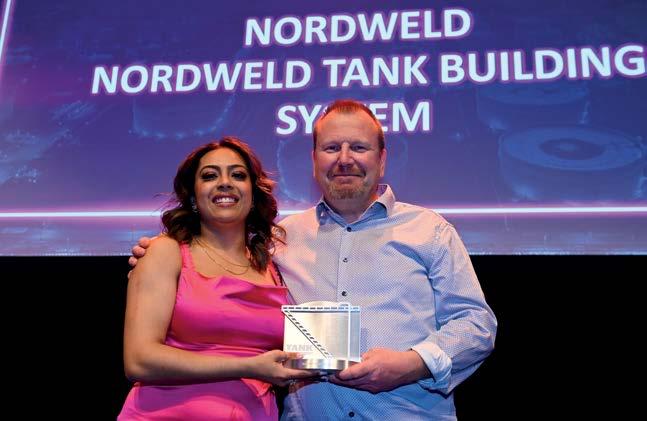
THE GLOBAL TANK Storage Awards
recognise the best talent, innovation and products in the tank terminal industry. In particular, the Innovative Technology award identifies solutions that are revolutionising the sector – and Nordweld’s Tank Building System took home the gold award in 2023.
Niklas Nordin, CEO and project manager at Nordweld, says: ‘It was great! I have put a lot of effort into developing this technology. This is an acknowledgment that we are doing something right and, hopefully, more companies will be interested in our Tank Building System. We will surely continue our journey to be the best supplier of different tank building solutions.’
‘My advice to other participants is to remain dedicated to their work or product development projects, and open-minded. There is always a solution for every problem,’ he adds.
THE SYSTEM
Nordweld’s Tank Building System allows clients to manufacture more tanks with fewer people, in a safer and more cost-effective way. ‘Our system uses the
‘top-down’ method of construction. The system consists of 15 or 9 tonnes electromechanical lift jacks, roller beds, wheel trolley (optional), tank rotators, a welding station and a tack weld/welding stand,’ says Nordin.
The system is designed for the erection of large aboveground atmospheric and pressured tanks and enables the construction of tanks with a diameter of 8-50 m, weighing up to 600-700 tonnes.
The different parts of the system enable the loading and feeding of the shell plates individually from one location, and then rotate them around the tank’s periphery. All shell joints and any required stiffening rings are welded using a mechanised welding process, designed, and refined over many years of continual research and development. This rotating system means that a tank can be constructed in a limited space.
The top-down method allows for roof stability and means the construction process is not halted by bad weather. This increases quality and improves the working environment for its users. Nordin says: ‘Since the system is modular, we can offer different building and
welding solutions depending on the type of the tanks and their material.’ All tank building components are transported in 20 ft shipping containers with a special movable transport rack for an easy and efficient unpacking. ‘Having all necessary components in one container is the perfect solution, including for overseas projects!’ he adds.
SAFETY, EFFICIENCY & A STREAMLINED PROCESS
One element that caught the judges’ eyes is that work is performed at ground level, instead of at heights. This eliminates safety risks – a huge benefit. Another benefit is that all work can be done from a single location – from assembly and fitting to onsite welding. All shell materials can be rolled onsite either from flat sheets or directly from coil. Finally, all non-destructive testing (NDT) can be performed from one location during the erection phase.
The modular system can be customised to suit different sized tank constructions without too much engineering. It can be used to build tanks either from pre-rolled plates or add a vertical bending machine and roll flat material, or even use material directly from coil on site.
Nordin adds: ‘I have worked for 35 years in this field and started my career as a tank builder. I have tried to cover everything from the transport of the equipment to its unpacking and installation, as well as its adaptability in order to enable the manufacturing of different types of tanks. This system is designed by a tank builder for tank builders.’
For more information:
www.nordweld.eu
01
01 Niklas Nording, CEO and project manager at Nordweld receives the award from Tank Storage Magazine editor Anamika Talwaria
PAGE 64 GLOBAL TANK STORAGE AWARDS INNOVATIVE TECHNOLOGY
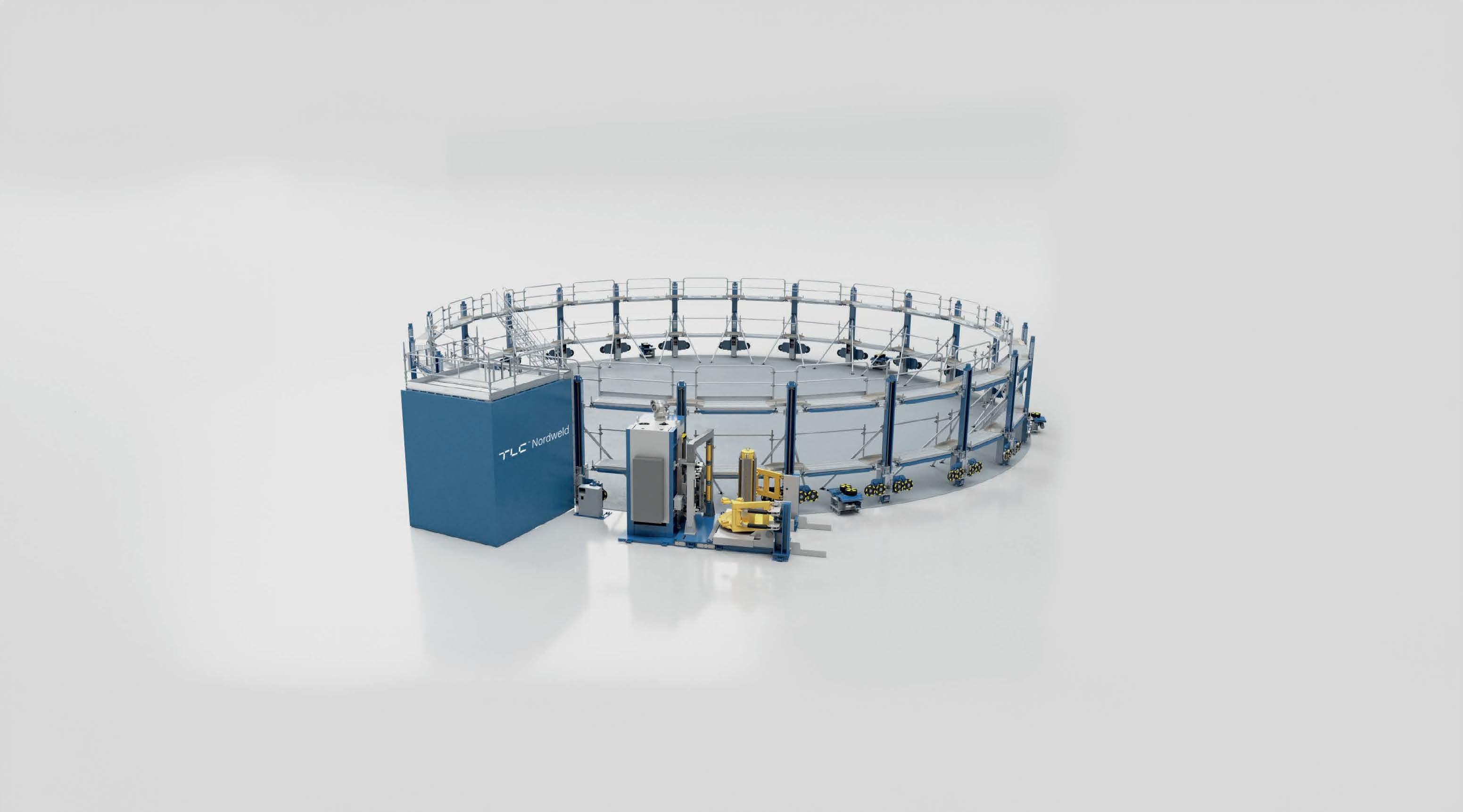







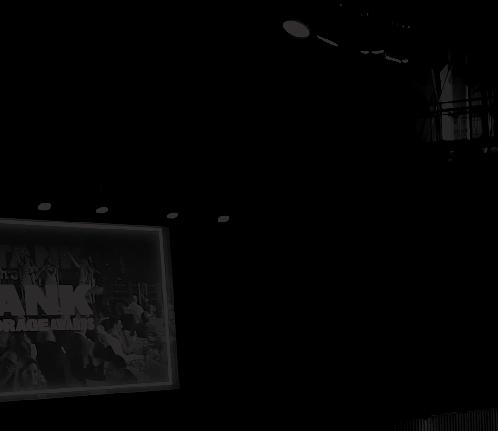
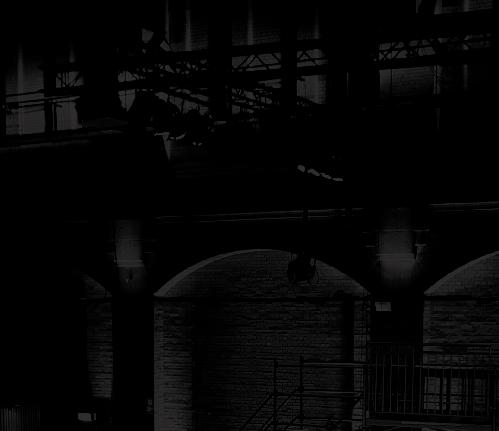
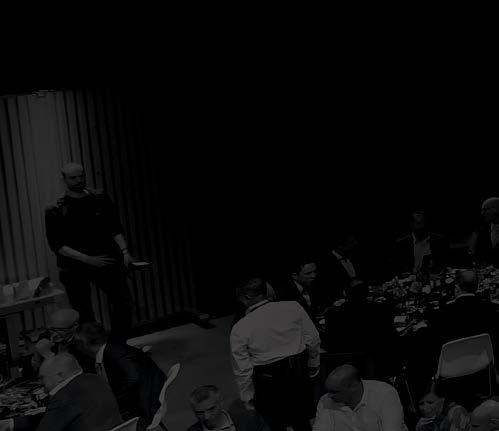

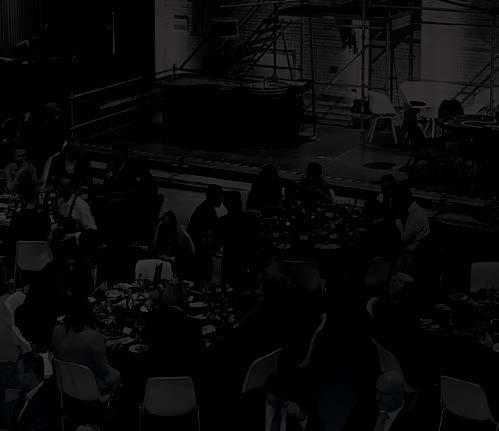



WINNERS 2023 FInd out more > tankstorageawards.com EMERGING TECHNOLOGY GOLD iSensPro BRONZE CLIIN Robotics SILVER Voliro ENVIRONMENTAL PERFORMANCE GOLD CIRCOR BRONZE Aquacycl SILVER TECAM INNOVATIVE TECHNOLOGY GOLD Nordweld BRONZE Imbibitive Technologies SILVER TWTG PORT OF THE FUTURE GOLD North Sea Port BRONZE Port of Amsterdam SILVER Port of Antwerp-Bruges TERMINAL OPTIMISATION GOLD Diamond Key International BRONZE Insights Global SILVER Smartflow
SAFETY TECHNOLOGY
GOLD
Real Safety
SILVER
ScoutDI
OUTSTANDING ACHIEVEMENT AWARD
GOLD
Nicholas Gohl, CFO, Aquarius Energy

SILVER
Helena Hjortberg, Manager Solutions for Rosemount Tank Gauging, Emerson
SAFETY EXCELLENCE
GOLD Odfjell Terminals Korea
SILVER
ITC Rubis Terminal Antwerp

RISING STAR AWARD
GOLD
Guy Curtis, EWFM

SILVER
Martyn Bazem, Exolum
TERMINAL INNOVATION
GOLD
ORLEN Unipetrol RPA
SILVER
Rubis Terminal Tepsa
Bilbao
TERMINAL OF THE FUTURE

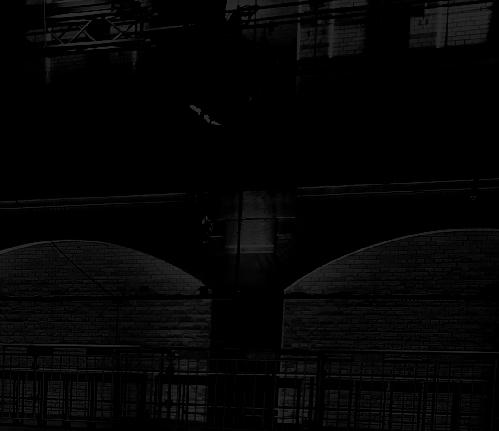
GOLD Advario
SILVER
Euro Tank Terminal
EXCELLENCE THROUGH DIVERSITY


GOLD
Emerson
SILVER
Pallavi Kanhere, CCO, Assai Software Services
BRONZE
CLIIN Robotics


BRONZE
Patrick Kulsen, Managing Director, Insights Global

BRONZE
GPS Chemoil
BRONZE
Amy McKeown, Re-Gen Robotics
BRONZE
Koole Tankstorage Botlek
BRONZE
ACE Terminal
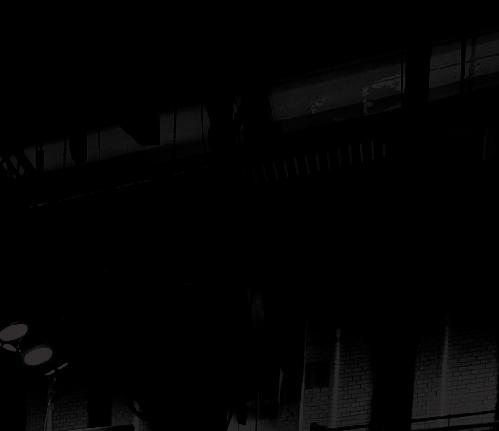
BRONZE
Vopak WeConnect

REVOLUTIONISING TANK MAINTENANCE & INSPECTION PROCESSES
Cyann Fielding speaks to iSensPro about its gold win for Emerging Technology at the Global Tank Storage Awards 2023

SENSOR
TECHNOLOGY
plays a crucial role in the bulk liquid industry by providing accurate and real-time data about various parameters related to the storage, transportation, and handling of liquids in large quantities. These sensors monitor and control important factors such as level, temperature, pressure, flow rate, and quality of liquids.
No two sensors are alike. The bulk liquid sector is experiencing emerging technology at an exponential rate. One company has recently made a significant impact with its ground-breaking sensor technology. iSensPro’s iSens-SDS ATEX moisture and CUI-sensor led the company to victory with the gold Emerging Technology award at the Global Tank Storage Awards 2023.
THE ROAD TO SUCCESS
iSensPro’s journey began with the development of an intrinsically safe sensor, designed to be deployed in explosive environments. The team had been working diligently to achieve the necessary certifications and approvals, ensuring a safe and reliable product. Prior to winning the award, the iSensPro team had already received positive feedback and garnered interest from potential customers, making the recognition at the Global Tank Storage Awards even sweeter.
Yves Desmet, CEO and co-founder of iSensPro, says: ‘Our most important USP is that the insulation of static assets doesn’t need to be dismantled for applying our sensor; most other sensing equipment requires the cladding and the insulation to be removed.’
THE VALUE OF WINNING
Securing the gold award for Emerging Technology not only brought recognition but also served as validation of the team’s hard work and dedication.
Desmet says: ‘It was very rewarding especially in our case as we are a start-
up company. So we are on the verge of commercialising our product.’
So, this achievement is very significant to iSensPro. It not only boosts confidence but also provides a strong footing as they venture into commercialising the product. The award has helped open doors for the company, enabling iSensPro to initiate commercial discussions with potential customers and build crucial partnerships.
ENTERING THE AWARDS
Participating in StocExpo seemed like an obvious choice for the iSensPro team, considering the positive feedback they had already received from potential customers. And entering the Global Tank Storage Awards was perfect to complement their presence at the event. The timing aligned perfectly with iSensPro’s recently acquired intrinsically safe certification. It was an opportunity they couldn’t pass up. ‘We think we have
a good product, serving the customers’ need for more efficient and automated maintenance. And so it was kind of proof that we were not the only ones who believe in it,’ comments Desmet.
REVOLUTIONISING MAINTENANCE PROCESSES
The sensor developed by iSensPro has the potential to revolutionise maintenance processes in the industry. Traditionally, maintenance of static assets, like pipes and tanks, requires costly and labour-intensive visual inspections. But iSensPro’s award-winning sensor is an automated solution, eliminating the need for extensive human involvement.
By simply placing the sensor on top of insulated static assets, it can detect moisture, coating degradation, leakage and corrosion within the insulation. This non-intrusive method offers a more costeffective and efficient approach to asset
PAGE 68
01 GLOBAL TANK STORAGE AWARDS EMERGING TECHNOLOGY
inspection. In part, this is because it does not require the dismantling of insulation for installation.
Additionally, the sensor provides real-time data on the condition of static equipment, eliminating the need for predictive analysis. This offers customers a clear understanding of the asset’s health and enables them to take proactive maintenance measures, reducing costs and downtime.
Desmet says: ‘So, with one sensor installed on an existing pipe, you can measure up to 1 km of pipe, for example. If you put the sensor below or at ground level, the pipe may go up or may go down and may go up again, may contain valves etc. All that is measured automatically without being intrusive in the whole pipe system.’
IMPACTS ON SUSTAINABILITY AND STREAMLINING OPERATIONS
Implementing this sensor technology has significant implications for sustainability and operational efficiency. By automating the inspection process and providing real-time data, asset owners can avoid or reduce costly shutdowns and extensive revamping of insulation, resulting in cost savings and reduced environmental impact. The sensor’s ability to identify
problems accurately and provide precise data empowers companies to make informed decisions and optimise maintenance strategies. On the other side, iSensPro’s sensor can indicate that an insulated pipe or tank is still in good health and does not need reconditioning, skipping unnecessary maintenance.
WHAT’S NEXT?
Looking ahead, iSensPro is focusing on commercialising its products. This involves strategic staffing and securing funding for the company. Winning the gold award has provided iSensPro with a valuable introduction to potential customers, opening doors for
commercial discussions. The team is excited about the future and believes that its award-winning technology will drive success in the market.
Desmet says: ‘Now, of course, we have a good introduction to our potential customers. We first start every meeting saying ‘Hey, we’ve won the gold Emerging Technology award’, so it’s a good opener.’
For more information: www.isenspro.com y.desmet@isenspro.com
Non-intrusive, without removing insulation Complete 360°detection from 1 to 1000 m length Continuous monitoring Clear data to take action upon CUI Intrinsically safe ATEX certification D a t a U n d e r I n s ul a tio n contact@isenspro.com www.isenspro.com Manage Corrosion Under Insulation (CUI) in a cost-efficient way, both on existing and new installations. Adv A5 lig.indd 1 01/09/2023 13:59 PAGE 69
01 Yves Desmet receiving the gold award for Emerging Technology at the 2023 Global Tank Storage Awards
‘We think we have a good product, serving the customers’ need for more efficient and automated maintenance. And so it was kind of proof that we were not the only ones who believe in it.’
GLOBAL TANK STORAGE AWARDS EMERGING TECHNOLOGY
NREGISTER OW

SCAN THE QR CODE TO REG ISTE R

ENTERING A NEW PHASE
Aquarius Energy CFO, Nicholas Gohl tells Tank Storage Magazine about winning the Outstanding Achievement award
AT THE 2023 Global Tank Storage Awards in Rotterdam, Netherlands, Nicholas Gohl, CFO of Aquarius Energy, was presented with gold for the Outstanding Achievement award.
The judges were impressed by the way Gohl champions terminals in both developed and emerging markets, understands the broader picture, and finds a concrete ways to help communities – beyond making money.
‘I felt honoured enough just to be nominated for an award, let alone win gold,’ says Gohl. ‘I’m proud to represent a company that I’ve been a part of since its inception as a standalone group. So, winning this award is the cherry on the top.’ Recently making the name change from HG Storage to Aquarius Energy, Gohl and the company are moving into a new phase in its business. ‘We’ve operated as HG storage for the last six years and are now moving forward as Aquarius Energy. It’s wonderful to have this recognition as we do this,’ says Gohl.
ON THE WORLD STAGE
‘We’re a small team and a relatively small company compared to some of the big names that you see at the Global Tank Storage Awards, so it’s always good to be recognised on the world stage,’ says Gohl. HG Storage may not have been as widely known as some of the big names like VTTI and Vopak, but its terminals across the globe have always been very well known throughout the market. However, with Aquarius Energy, Gohl is looking to change this. Winning the award was a fantastic way to start the re-brand.
‘We’ve made name for ourselves as a partner to our customers as HG Storage and as Aquarius Energy we intend to develop this as they grapple with the changing energy landscape and how best to develop their respective businesses.’
As CFO of the group since the inception of HG Storage, Gohl is now part of building the strategy and laying the foundations for what will be an exciting new chapter.
On top of winning the Outstanding Achievement award, Nicholas Gohl was also named one of StocExpo’s Forty Under 40, 2023. This symbolises recognition for his potential to be an industry leader – and go even further.
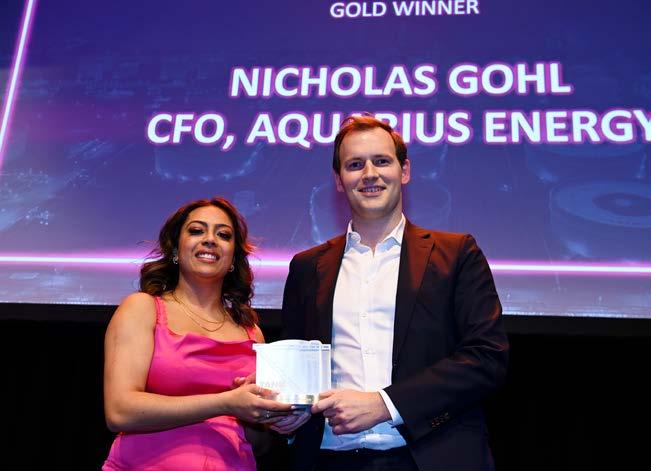
‘I attended this year’s StocExpo with a
colleague and we both really enjoyed it. We were very pleased to come home from the awards with myself winning gold and one of our terminals, GPS Chemoil, UAE, receiving bronze for Safety Excellence. It was a very successful evening for us, especially being our first time with our new name,’ says Gohl.
BUILDING UP THE BRAND
With outstanding achievement comes challenges, and building the company’s portfolio has been a major part of Gohl’s role. The portfolio was born out of global trader, Glencore, and various mid and downstream assets that it owned. In 2017, when a partner was brought into the business, it was established as a standalone company with assets across the world.
‘Building a portfolio and a coherent business model strategy was a challenge in itself. Not only that but, if you look at the places in which we operate, and you look at the geographies; we’re in the Americas,
Africa, Europe and the Middle East. These places come with different challenges,’ says Gohl. One of his key achievements is understanding the challenges of these regions where Aquarius Energy operates and being able to build the portfolio armed with that knowledge.
Despite the challenges, Gohl finds the experience very rewarding. These regions often have not had the same access to energy that is taken for granted in western Europe. A huge benefit of the role is being a part of bringing energy to communities in places that are subject to energy poverty, where access to energy is not always a given.
‘We are growing our LPG business as an alternative to electricity. We’re growing our solar business in a place like Zimbabwe as an alternative energy. Learning to understand those markets that we operate in and being able to then find out how we can make a difference is one of the skills and successes that I’ve been recognised for as part of this award,’ explains Gohl.
These new ventures do not mean that Aquarius Energy is leaving oil and gas behind. ‘Historically, a lot of our terminals are oil and gas. However, we are slowly moving into new energies. We’re currently looking at a very exciting project in the biofuels space,’ says Gohl.
01
PAGE 71 GLOBAL TANK STORAGE AWARDS OUTSTANDING ACHIEVEMENT
‘Historically, a lot of our terminals are oil and gas. However, we are slowly moving into new energies...’
INDUSTRY SUCCESS
Gohl believes his success stems from his hard work, patience and commitment to the industry. ‘You need to have passion, you need to feel that what you’re doing is making a difference and whether that is financial difference or other,’ he says.

Gohl also considers ‘time in the seat’ experience to be important. ‘Having the patience to wait and grow within your role is something I have done; and what I’ve learned from this has been phenomenal. I get to the end of every year and reflect on how much I have grown relative to the same position a year before.’
BECOMING AQUARIUS ENERGY
HG Storage recently became Aquarius Energy – and it was more than just a rebrand. ‘The change was a broadening of the scope of what this business is. Up until now, we’ve traditionally been an oil and gas storage terminal business,’ says Gohl. But now, Aquarius Energy is making a shift to focus on the energy transition and access to energy in parts of the world that are struggling and how it can aid in those supply chains.
Aquarius has started looking beyond just storage terminals. ‘We’re looking at solar and into biofuels feedstocks, and what these might entail in terms of other services that we may be able to provide to our customers,’ says Gohl.

With the new name, Gohl wastes no time telling people Aquarius Energy is open for business. ‘We’ve got this new name; this new presence and we’re looking at developing the portfolio. We’re reshaping the mix of what we have, but the key point
is, we are growing.’ Aquarius Energy is striving to be spoken about in the same conversation as the energy giants. ‘We see this portfolio as having the potential to be at that scale,’ he says.
Gohl believes that the industry has still got scope for growth, and it is only going to get bigger over the next decade as new energies and technologies evolve. ‘The industry needs fresh eyes to look at it and find what’s missing and where the opportunities and solutions are. Keeping the industry relevant is going to be important for us all and Aquarius Energy is going to be a big part of tank storage 2.0 and I’m excited to be a part of that.’
www.aquariusenergy.com
For more information:
01 Nicholas Gohl with Tank Storage Magazine’s editor, Anamika Talwaria at the 2023 Global Tank Storage Awards
02 Aquarius Energy’s joint venture terminal in Antwerp, SEA-Tank 510
02 03 PAGE 72 GLOBAL TANK STORAGE AWARDS OUTSTANDING ACHIEVEMENT
03 Nicholas Gohl with marketing intern, Chloe Rouse and his Forty under 40 certificate at StocExpo 2023
THE GLOBAL HYDROGEN EVENT

9 - 13 October 2023 | Rotterdam
9 - 10 October 2023



Mainport, Rotterdam
A focused event exploring the emerging hydrogen derivatives market highlighting changes in legislation, current market trends and opportunities for ammonia, methanol, LOHCs and more.
10 October 2023
Mainport, Rotterdam
A case study-led summit taking you on a tour of leading national hydrogen projects and best practice around the world.

11 - 12 October 2023






World Trade Centre, Rotterdam
The world’s leading commercially-focused dealmaking event accelerating hydrogen projects up to and beyond final investment decision (FID).

13 October 2023
World Trade Centre, Rotterdam
A platform to hone skills and knowledge through practical hydrogen workshops, masterclasses and a conference summit dedicated to global hydrogen project case studies.


#WHW23 #WHC23 #WHD23
www.worldhydrogenweek.com
Scan to find out more
350+ speakers 60+ hours of content 150+ sponsors & exhibitors 4 events over 5 days 3000 attendees 800+ companies represented 50+ countries
2023 API STORAGE TANK
9-12,
The 2023 API Storage Tank Conference will give attendees an opportunity to learn about new and existing industry codes and standards, and to hear about emerging trends from industry experts. This conference offers over 25 sessions addressing the needs of individuals involved in production systems, pipelines, terminals, refining, and storage facilities. Each day focuses on presentations relevant to upstream, midstream and downstream.


Copyright 2023– American Petroleum Institute, all rights reserved. API, and the API logo are trademarks or registered trademarks of API in the United States and/or other countries. API Globa Marketing & Creative: 07.11.23 Register at www.API.org/storagetank
OCTOBER
2023
CONFERENCE & EXPO HILTON
|
DENVER CITY CENTER, DENVER, COLORADO
OPPORTUNITIES FOR TANK STORAGE IN THE HYDROGEN ECONOMY
Nick Waple, senior engineer at Wood Plc, gives Tank Storage Magazine an exclusive preview of his talk at the Hydrogen Technology Expo and how this relates to tank storage professionals
THE OFFSHORE pipeline industry is facing some key challenges when it comes to transporting hydrogen at high pressures. This includes:
• What a new hydrogen pipeline will look like in terms of specification and testing requirements
• Pathways in repurposing existing pipelines for hydrogen
• The latest hydrogen pipeline design methodologies following an Engineering Critical Assessment (ECA) approach combining material test data, defect sizing and design loads
Many aspects of the challenges foreseen for both onshore and offshore pipeline is also relevant to the tank storage industry. This includes aspects such as material compatibility, considering the embrittlement effects hydrogen has on carbon steels, which are key in ensuring safe pipeline design and may significantly impact the feasibility of repurposing existing infrastructure.
There are also thermodynamic considerations, such as the comparatively low volumetric energy density of hydrogen compared to traditional hydrocarbons, and safety aspects, such as the low ignition energy of hydrogen and potential for deflagration or explosion to occur in a gas release scenario.
WHAT OPPORTUNITIES ARE THERE FOR THIS INDUSTRY?
Hydrogen technologies present a tremendous opportunity for many sectors of the energy industry to utilise their existing knowledge and skillsets to support decarbonisation, including tank storage. The low volumetric density of hydrogen in particular will require additional and new storage solutions to maintain energy security and support de-centralised hydrogen production from renewable sources.
In addition, hydrogen energy vectors such as cryogenic hydrogen and liquid ammonia present new challenges and opportunities for bulk energy storage and transportation over large distances. In preparation for the rise of hydrogen technologies, it is important for all industries to identify and understand
the key differences between hydrogen and natural gas and the impacts these will have on established material use, design methodologies and operational procedures. This opens up new opportunities for collaboration and innovation to ensure industry wide solutions to challenges faced.
Within the pipeline industry many Joint Industry Practices (JIPs) such as the DNV-led H2PipeJIP (of which Wood is a participant) are ongoing with comprehensive experimental testing programs being carried to enhance the understanding of key hydrogen transportation challenges to support in the design and re-qualification of hydrogen pipelines.
Wood has also funded a three-year multidiscipline team tasked with understanding the challenges of hydrogen and developing design solutions to address these challenges. Many of these solutions are relevant to tank farms.
For more information:
Nick Waple will be speaking at the Hydrogen Technology Expo on 27-28 September in Bremen, Germany. www.hydrogen-worldexpo.com

PAGE 75 EVENT PREVIEW HYDROGEN TECHNOLOGY EXPO
‘I’m looking forward to hearing about the great work being done and challenges being faced within other industries surrounding hydrogen,’
H.H.
2-5 October 2023


Abu Dhabi, UAE
Decarbonising. Faster. Together.


Taking place shortly before COP28, ADIPEC 2023 will connect policy, people, technology and capital to accelerate the next phase of the energy transition; bringing together diverse energy industry stakeholders in a forum that will quicken industry action to decarbonise faster, future-proof sooner and create the energy system of the future, today.
Al Kaabi Executive Director of Register as a delegate www.adipec.com Register as a visitor
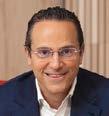


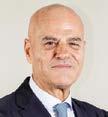

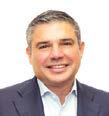
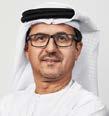 Under the Patronage of
Sheikh Mohamed Bin Zayed Al Nahyan, President of the United Arab Emirates
Under the Patronage of
Sheikh Mohamed Bin Zayed Al Nahyan, President of the United Arab Emirates
Strategic insights partner Host City Venue partner Official travel partner Official hotel partner Official local media partner Sport & recreation partner ADIPEC brought to you by Technical Conference organised by Knowledge partner Official English news partner Official broadcast partner International news partner Partners Supported by Gold sponsors Platinum sponsors
Patrick Pouyanné Chairman & CEO TotalEnergies Musabbeh
Low Carbon Solutions & International Growth ADNOC
Oxy
Alfred
Eni Douglas
Speakers include:
Vicki Hollub President and CEO
Lorenzo Simonelli CEO Baker Hughes Bernard
Looney
CEO bp
Stern CEO OMV
Claudio Descalzi CEO
Pferdehirt CEO TechnipFMC
Martin
Helweg CEO P&O Maritime Logistics
Wael Sawan CEO Shell
EVENTS 2023
5 – 8 September 2023
Media Partner GASTECH Singapore www.gastechevent.com
14-15 September 2023
Media Partner DIGITALISATION IN OIL AND GAS Houston, Texas
www.digitalizationoilgas.com
21 September 2023
Media Partner TANK STORAGE ASSOCIATION Coventry, UK
www.tankstorage.org.uk/conferenceexhibition/
25-28 September 2023
Media Partner THE EUROPEAN PETROCHEMICAL ASSOCIATION (EPCA)

Vienna, Austria www.epca.eu
26-27 September 2023
BLOCKCHAIN EXPO EUROPE

Amsterdam, The Netherlands
www.blockchain-expo.com/europe
27-28 September 2023
Media Partner HYDROGEN TECHNOLOGY EXPO Brehem, Germany
www.hydrogen-worldexpo.com
2-3 October 2023
Media Partner HYDROGEN AMERICAS 2023
Washington D.C. www.hydrogen-americas-summit.com
2-5 October 2023
Media Partner ADIPEC Abu Dhabi, United Arab Emirates www.adipec.com
4-5 October 2023
PUMPS AND VALVES ROTTERDAM Ahoy, Rotterdam, The Netherlands www.pumpsvalves.nl
9-12 October 2023
Media Partner
AMERICAN PETROLEUM INSTITUTE STORAGE TANK CONFERENCE & EXPO Denver, Colorado www.events.api.org/2023-api-storagetank-conference-expo
9-13 October
WORLD HYDROGEN WEEK Rotterdam, Netherlands
www.worldhydrogen-week.com
25-26 October 2023
Media Partner ASIAN DOWNSTREAM SUMMIT Singapore
www.asiandownstreaminsights.com/ events/asian-downstream-summit
24-25 October 2023
Media Partner
PROCUREMENT PROCESSES FOR TANK STORAGE EQUIPMENT
Dubai, United Arab Emirates www.cconnection.org/events/ tankstorage
7-9 November 2023
Media Partner HAZARDS 33 Coventry, UK www.icheme.org/training-events/ hazards-process-safety-conference
28-30 November 2023
Media Partner ANTWERPXL Antwerp, Belgium www.antwerpxl.com
5-7 December 2023
Media Partner ANNUAL GPCA CONFERENCE Qatar, Doha www.gpcaforum.com
5- 7 December 2023
Media Partner NISTM WOODLANDS The Woodlands, Texas www.nistm.org
PAGE 77 EVENTS 2023 CALENDAR










































































































































































































































































 Under the Patronage of
Sheikh Mohamed Bin Zayed Al Nahyan, President of the United Arab Emirates
Under the Patronage of
Sheikh Mohamed Bin Zayed Al Nahyan, President of the United Arab Emirates


